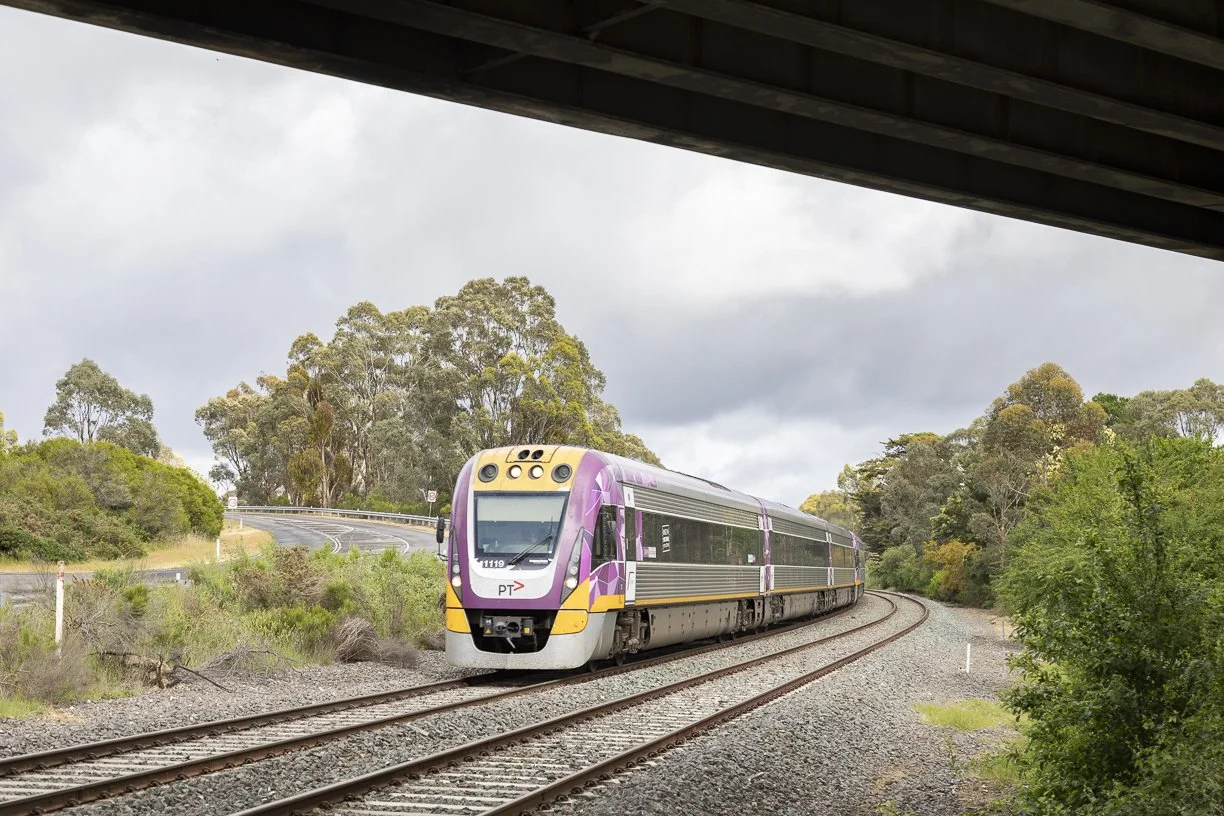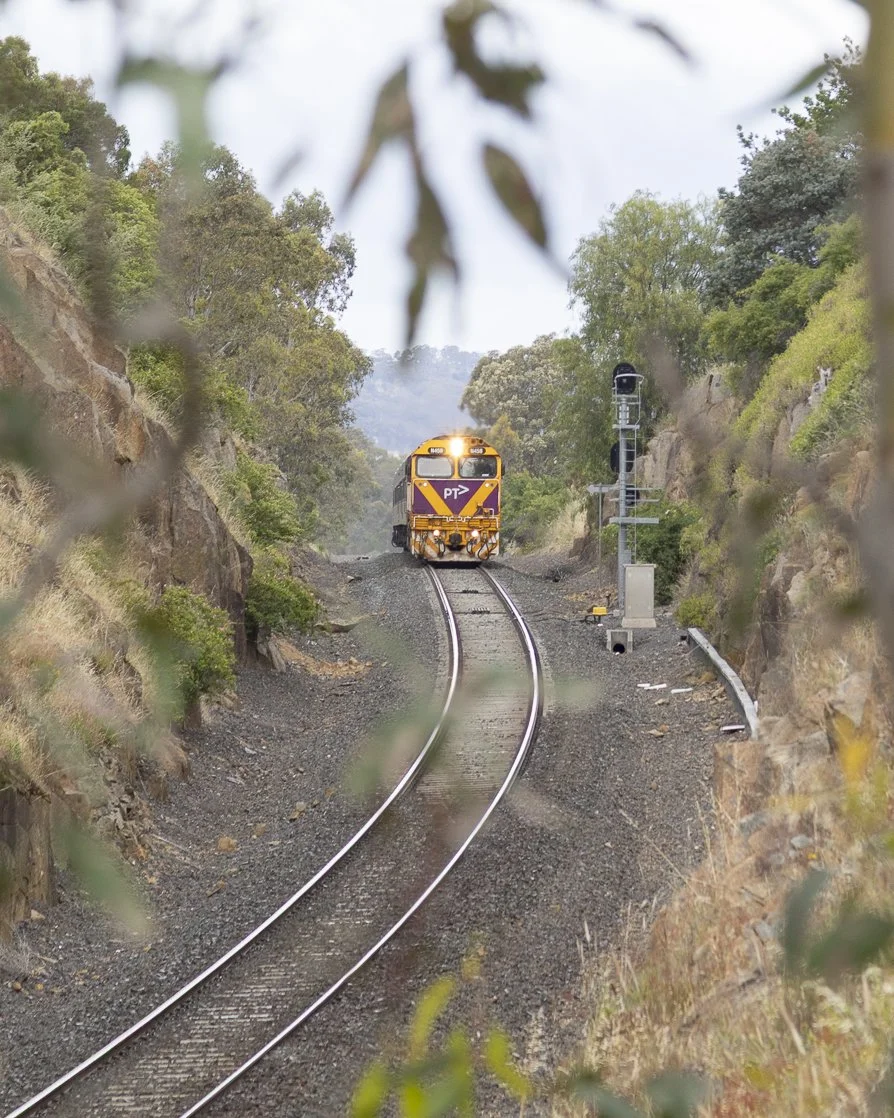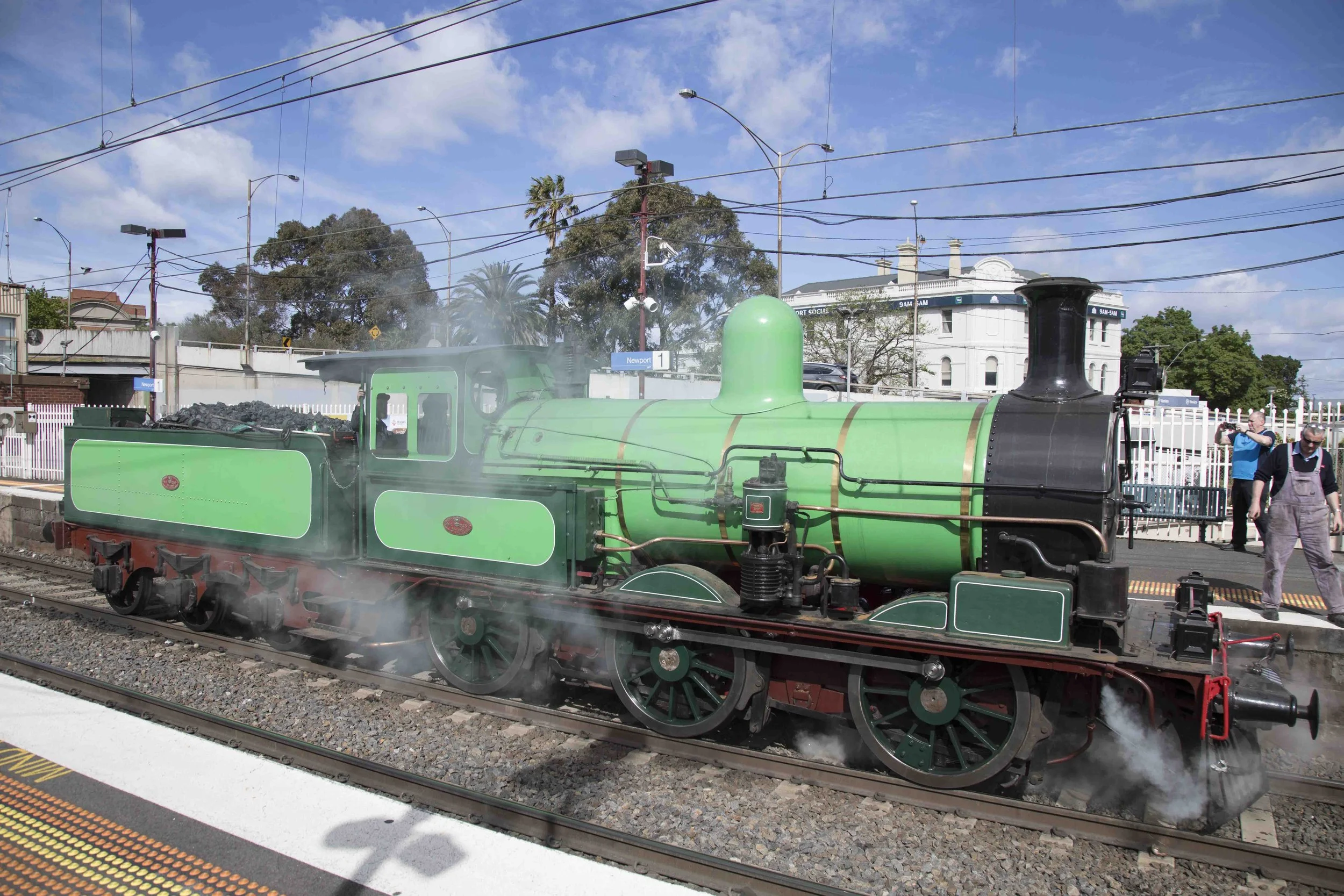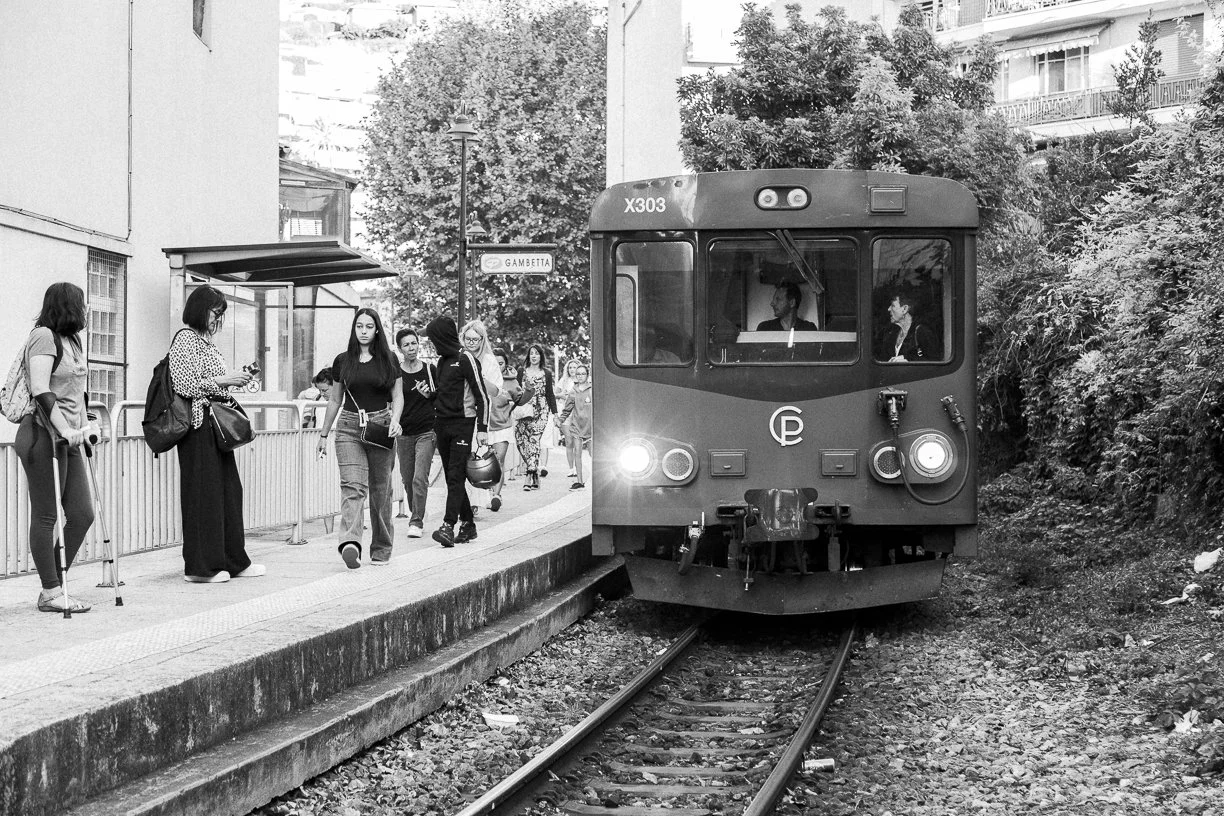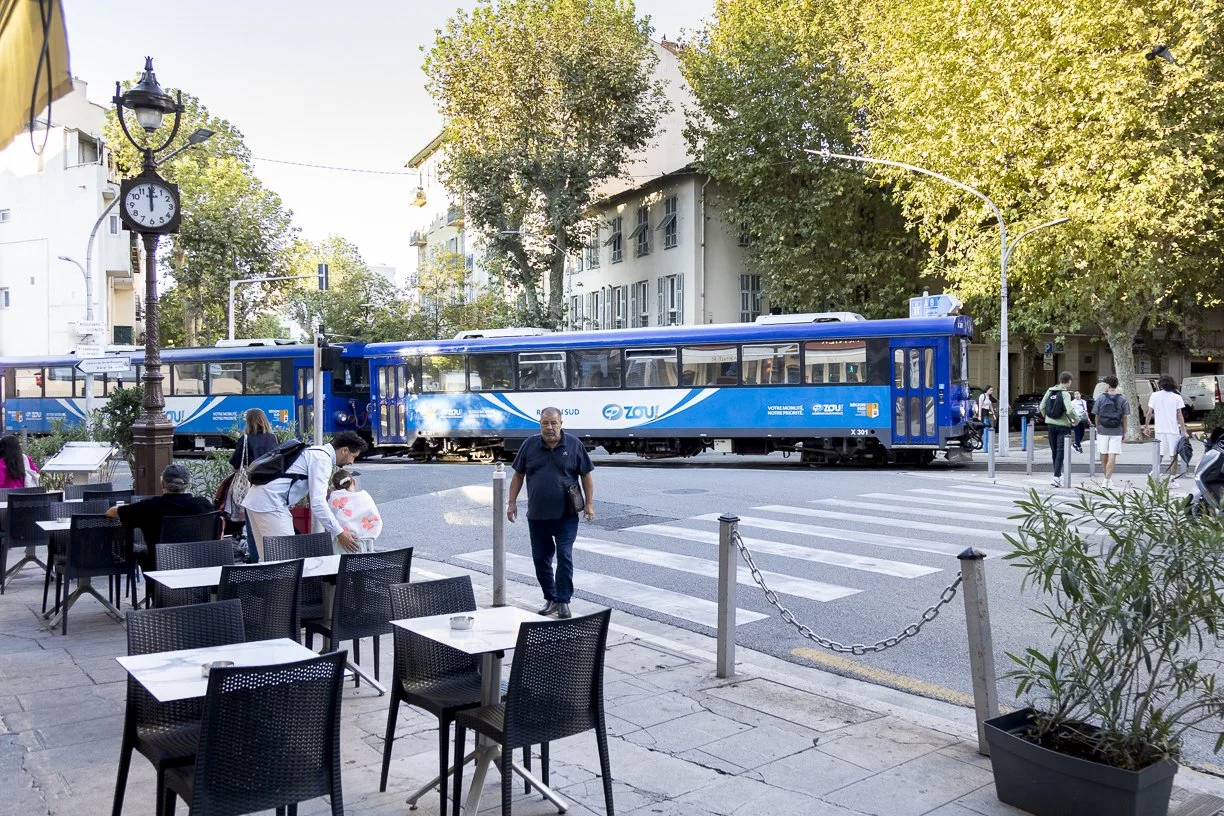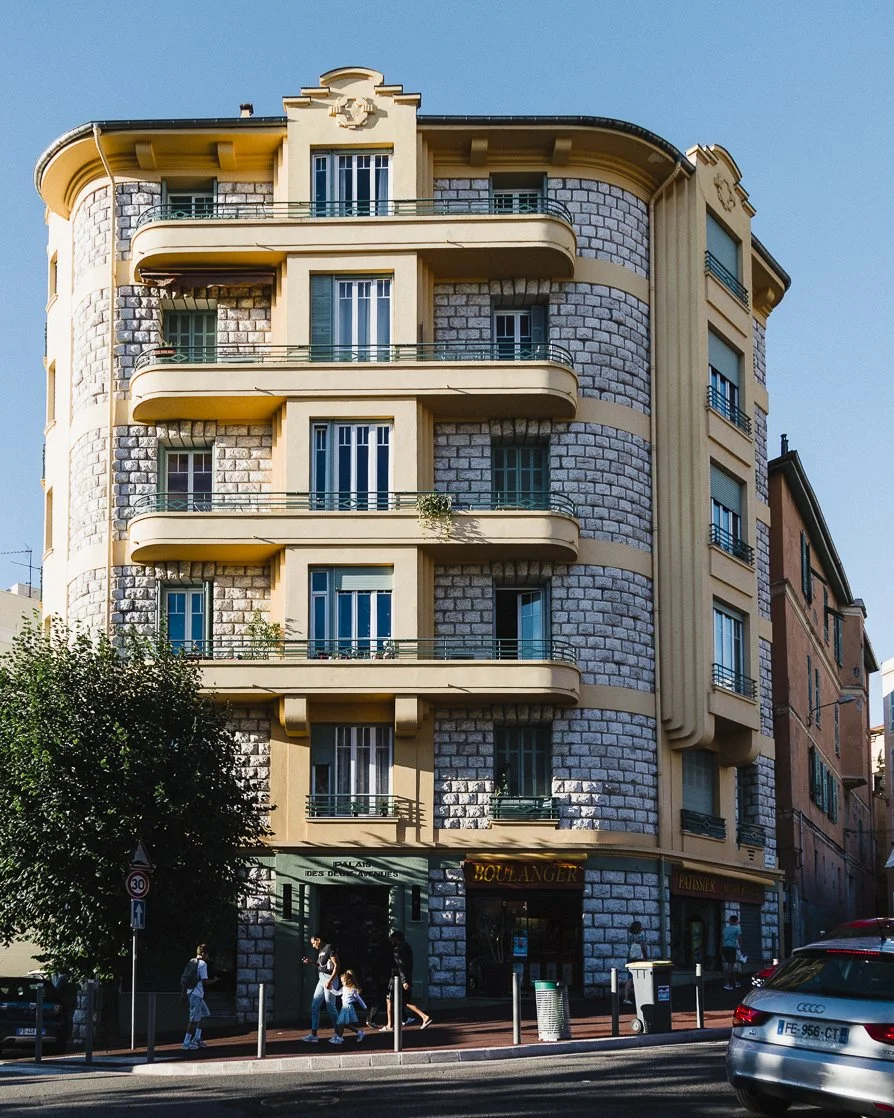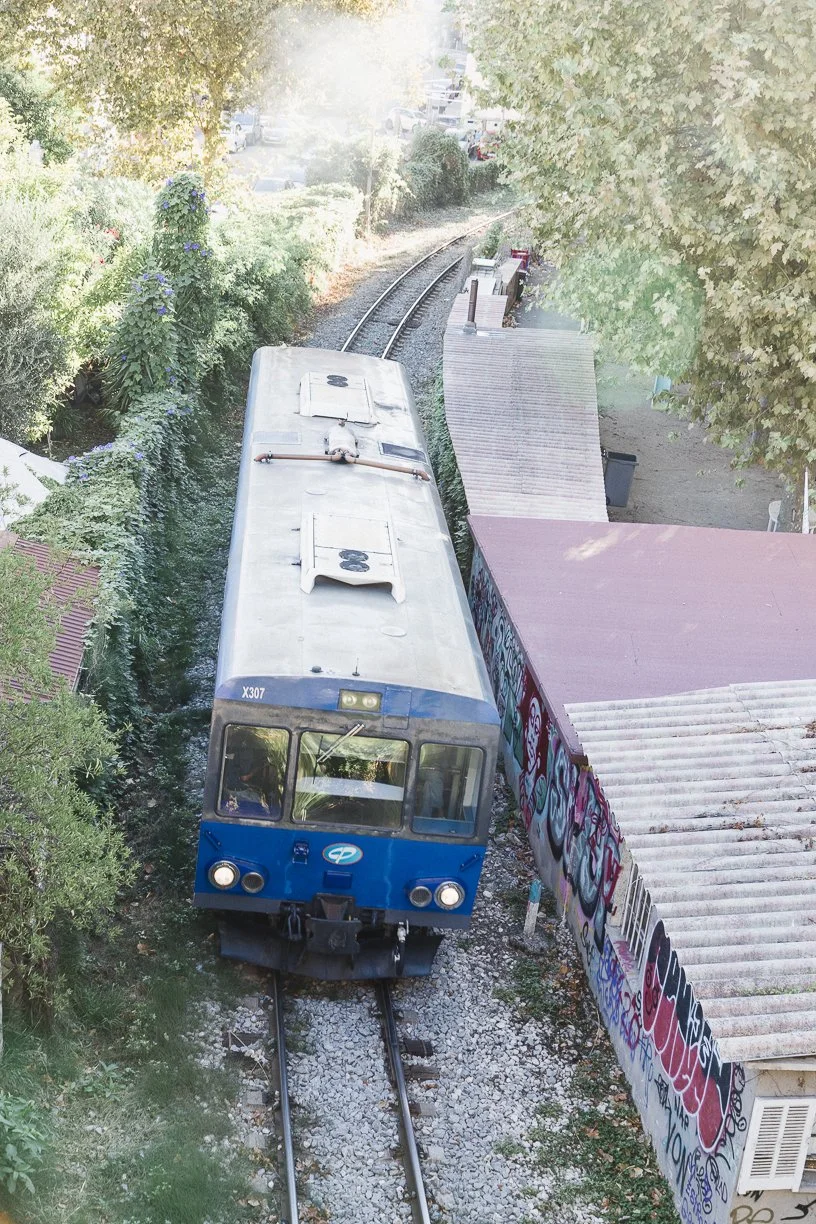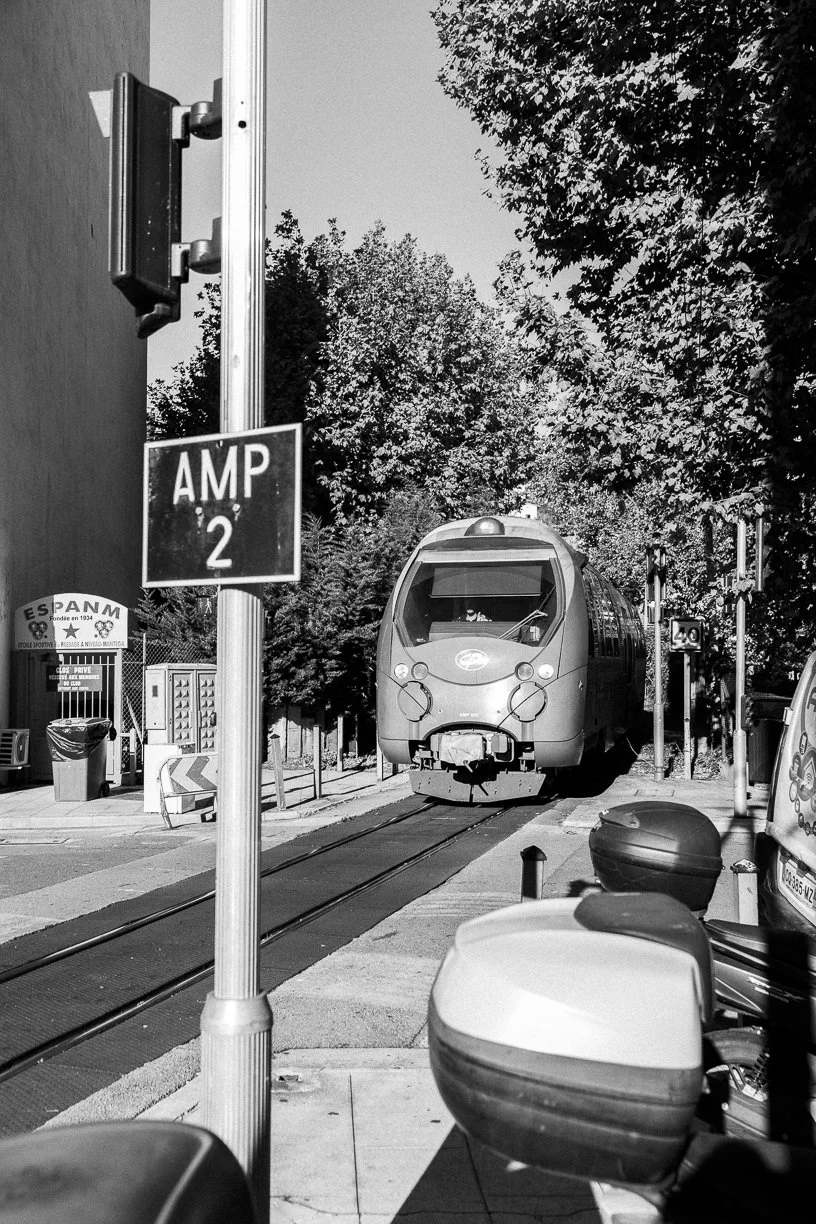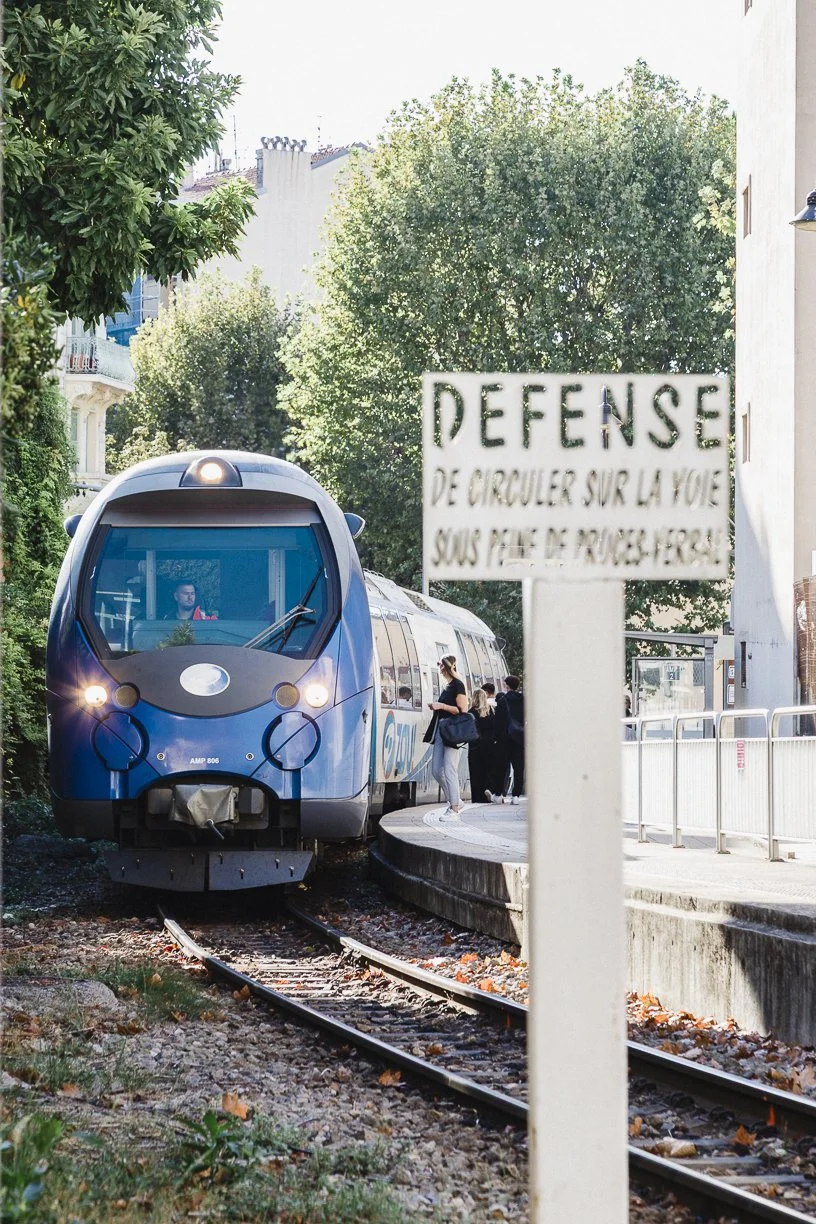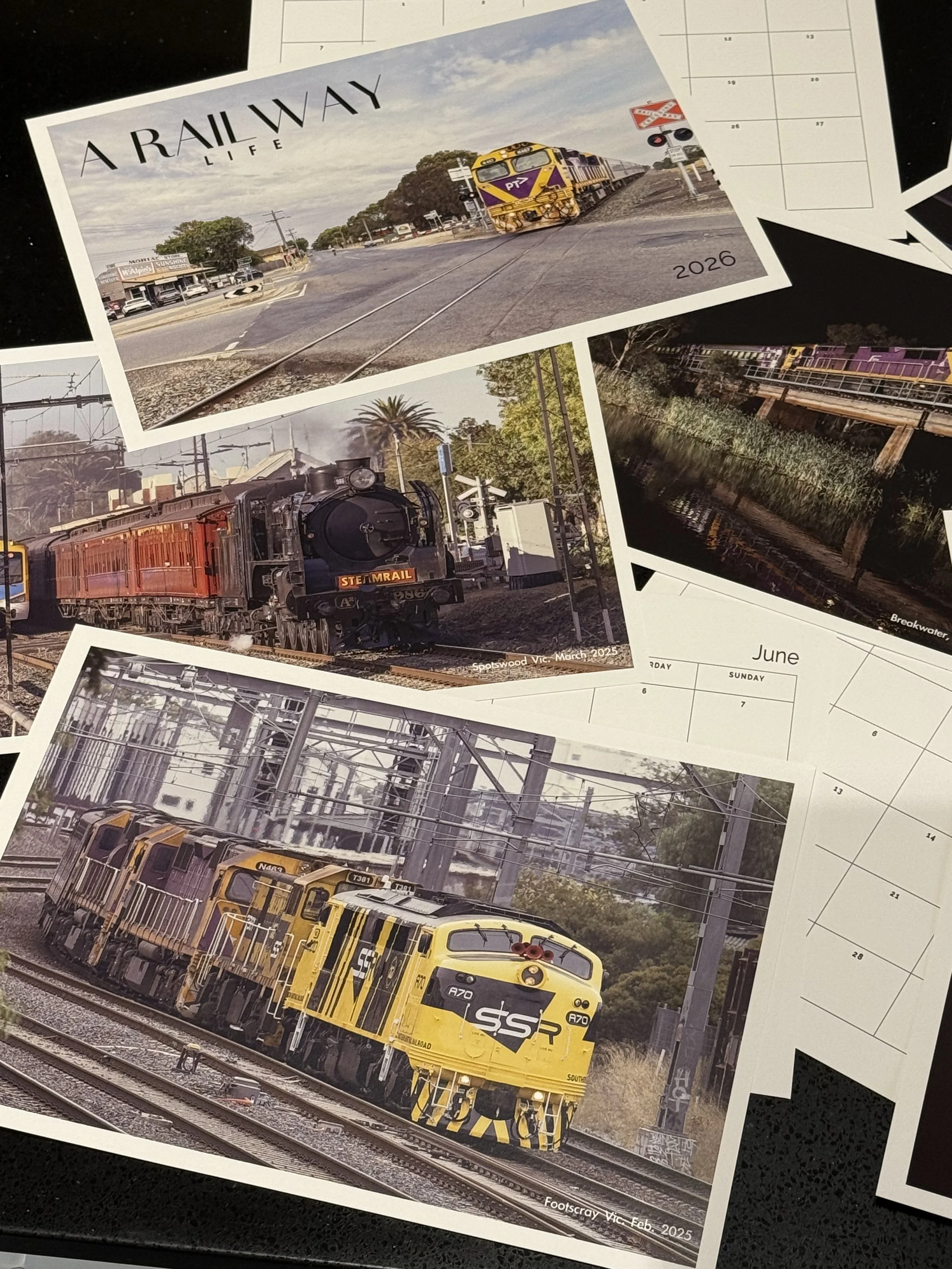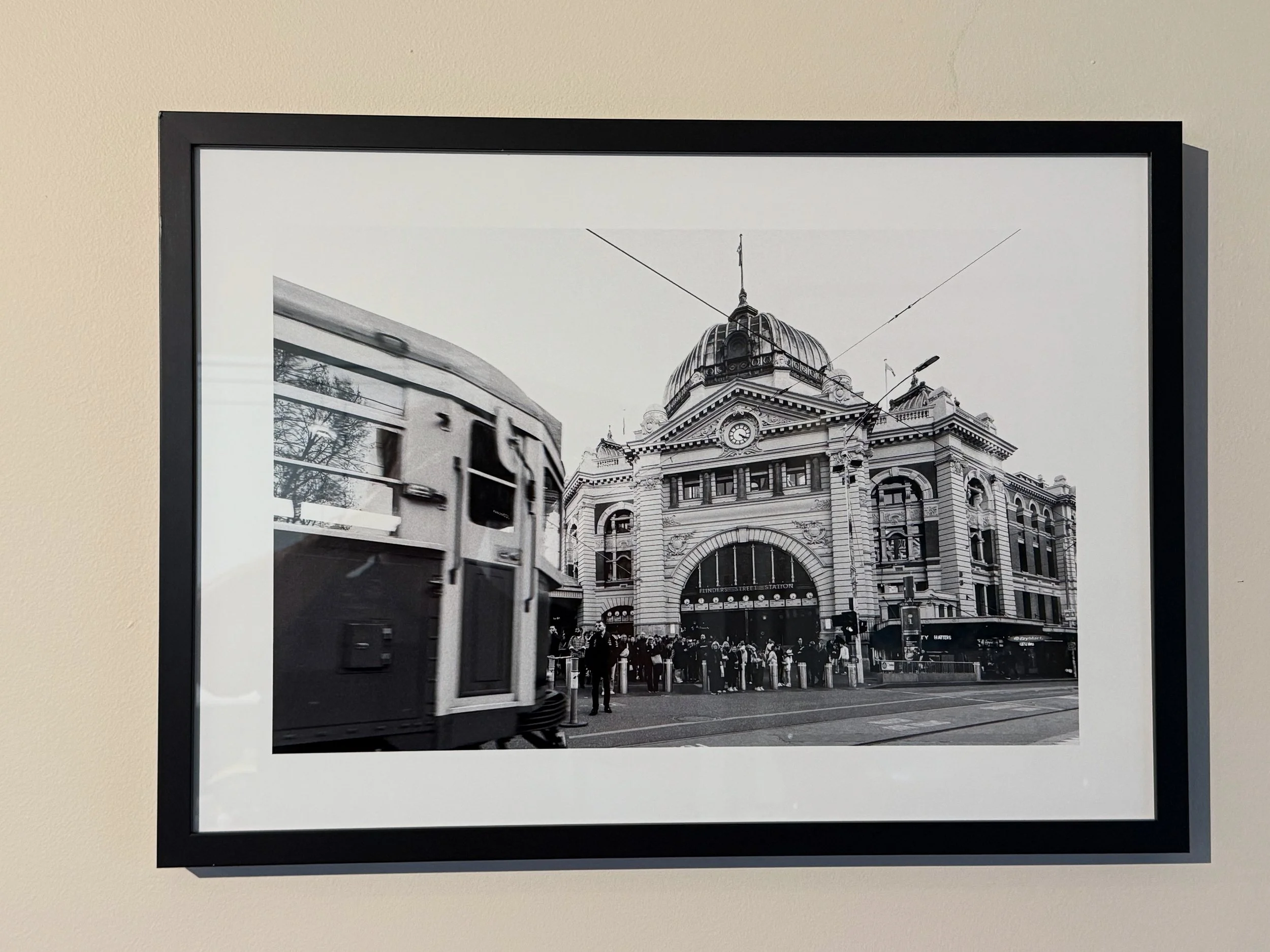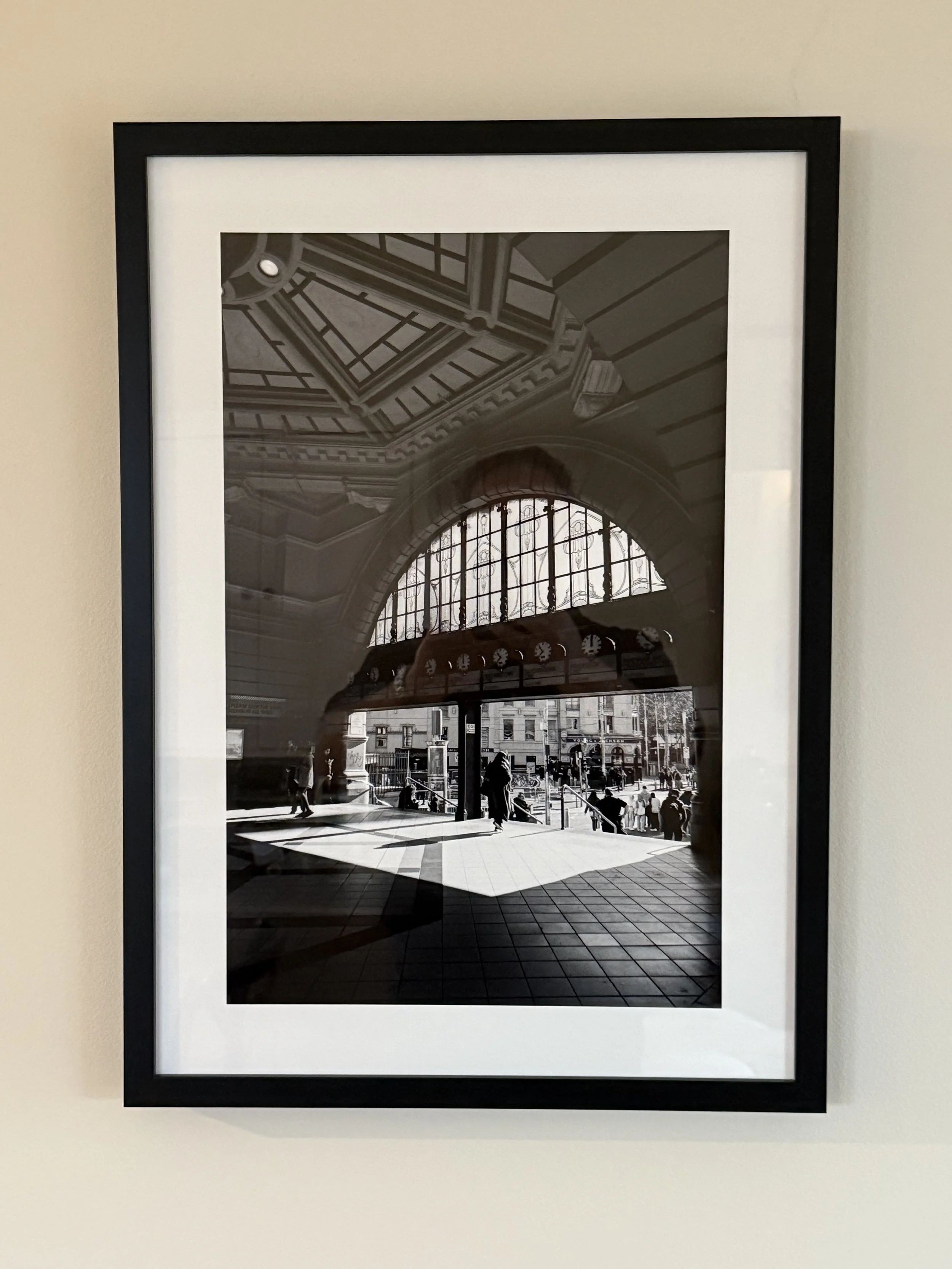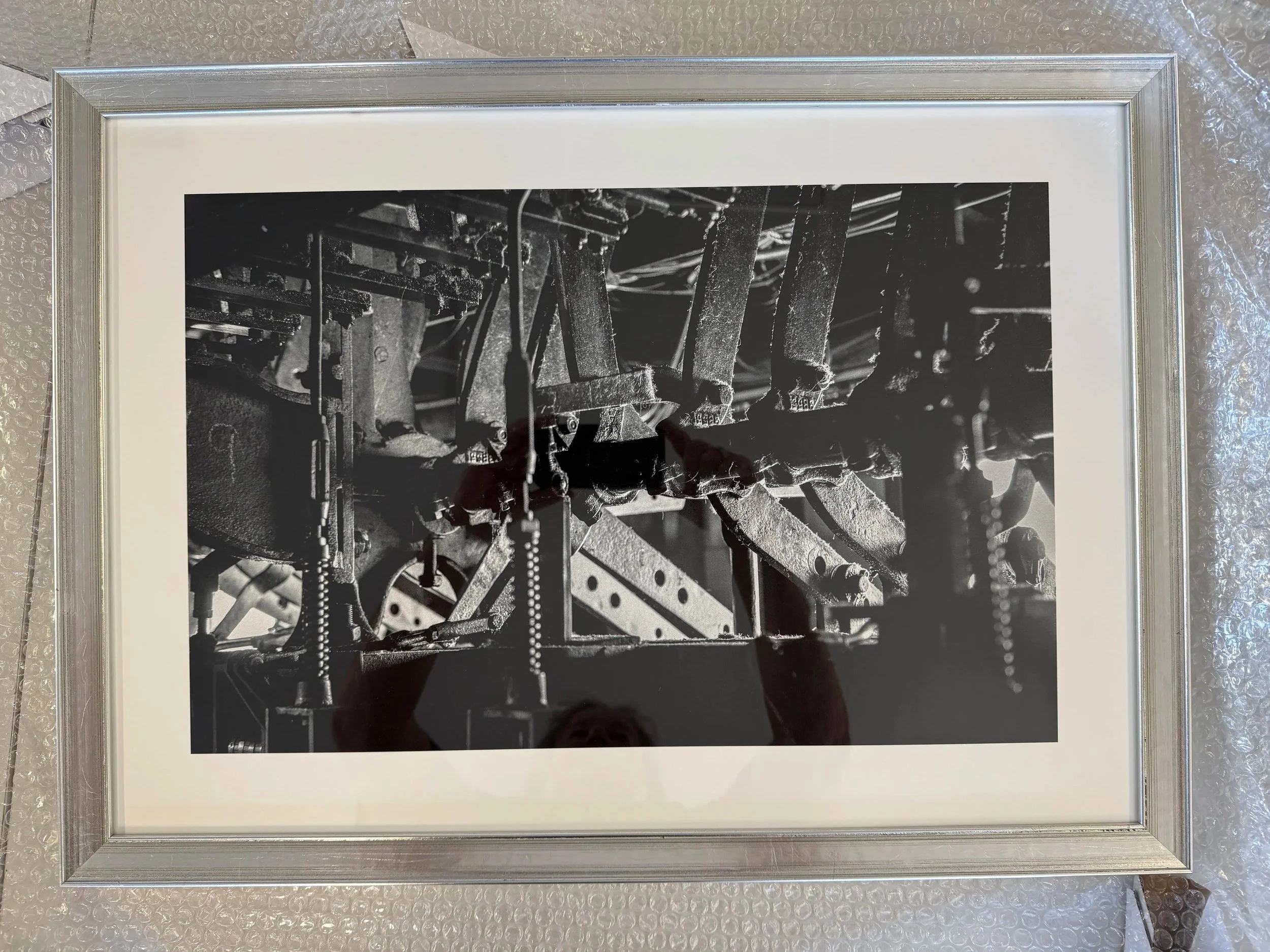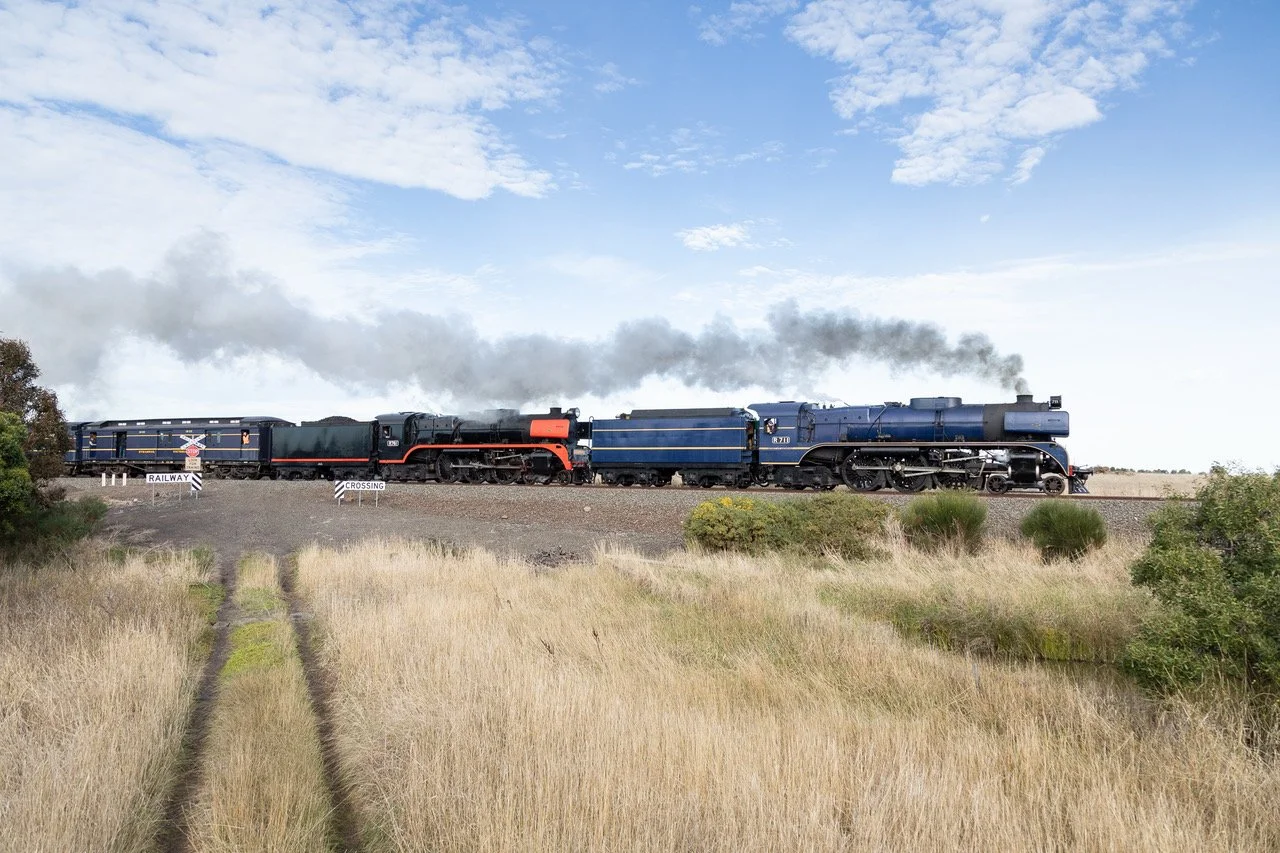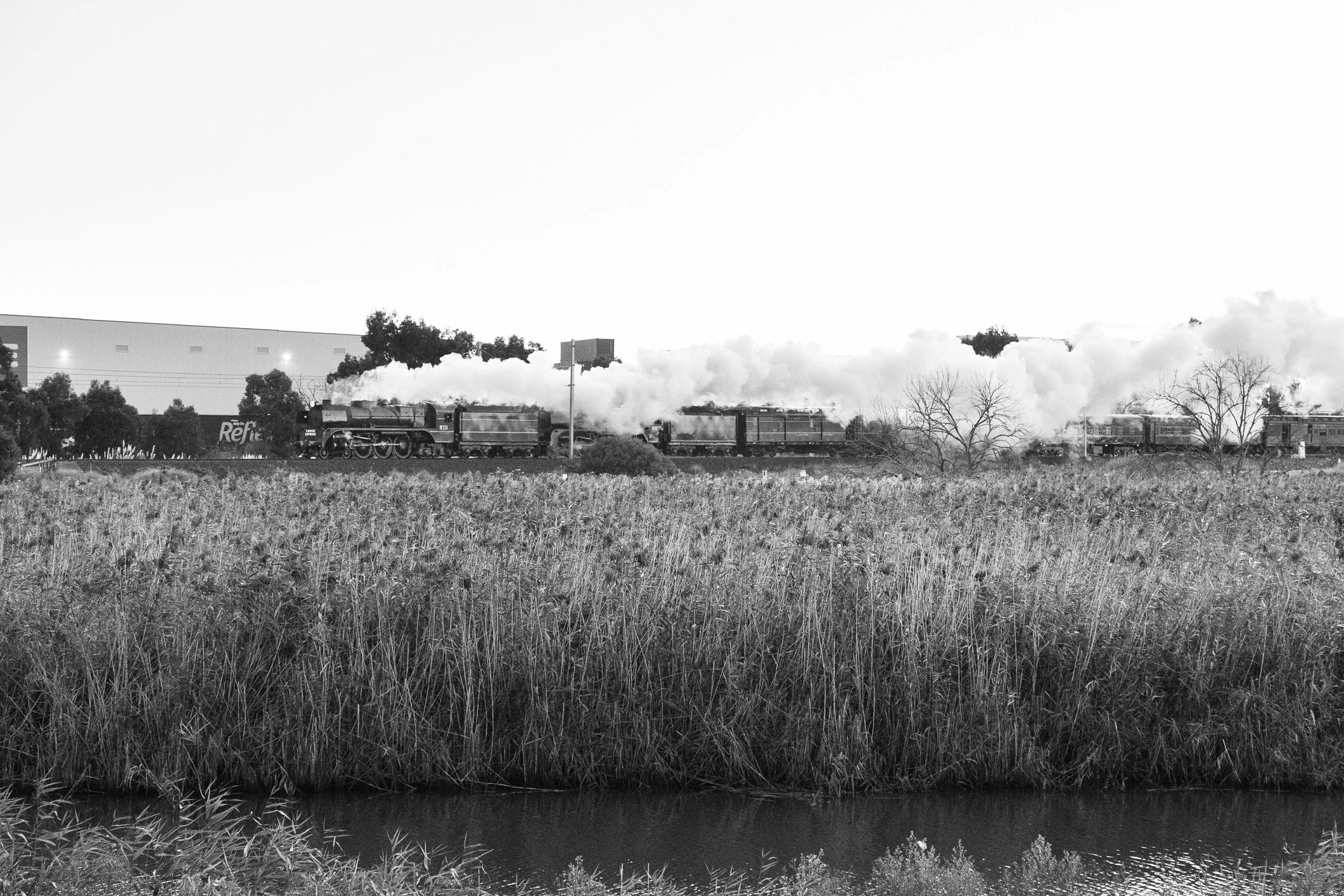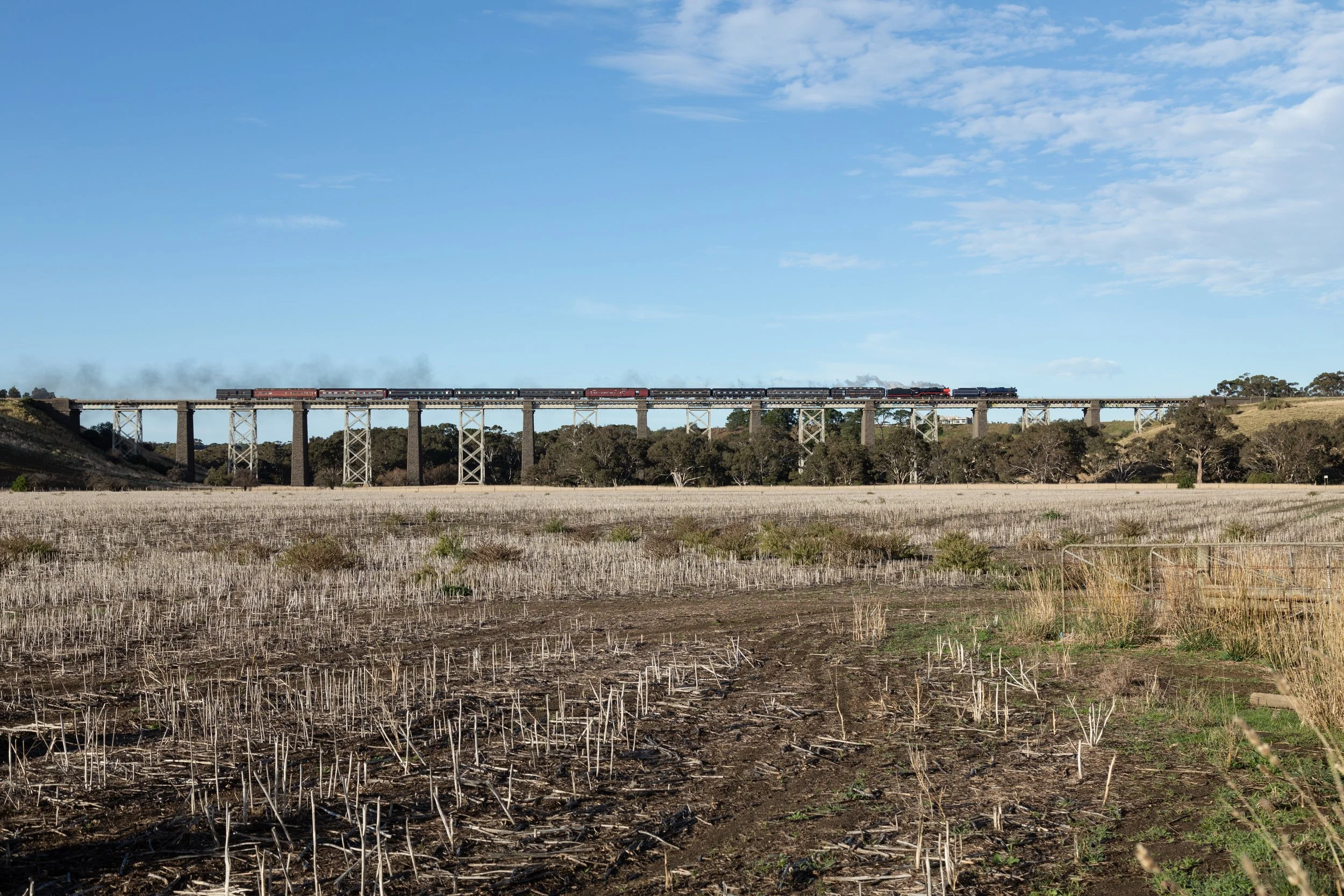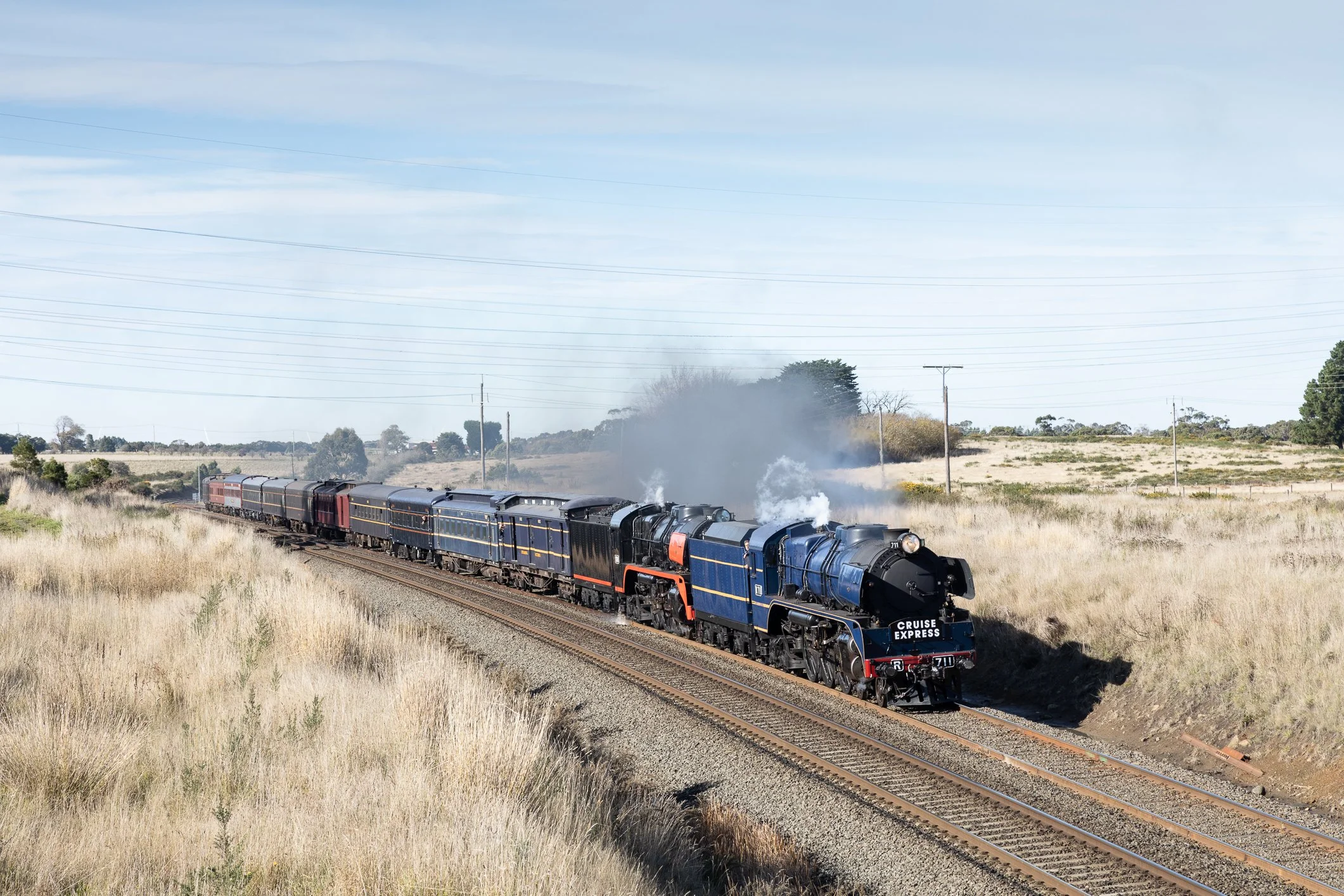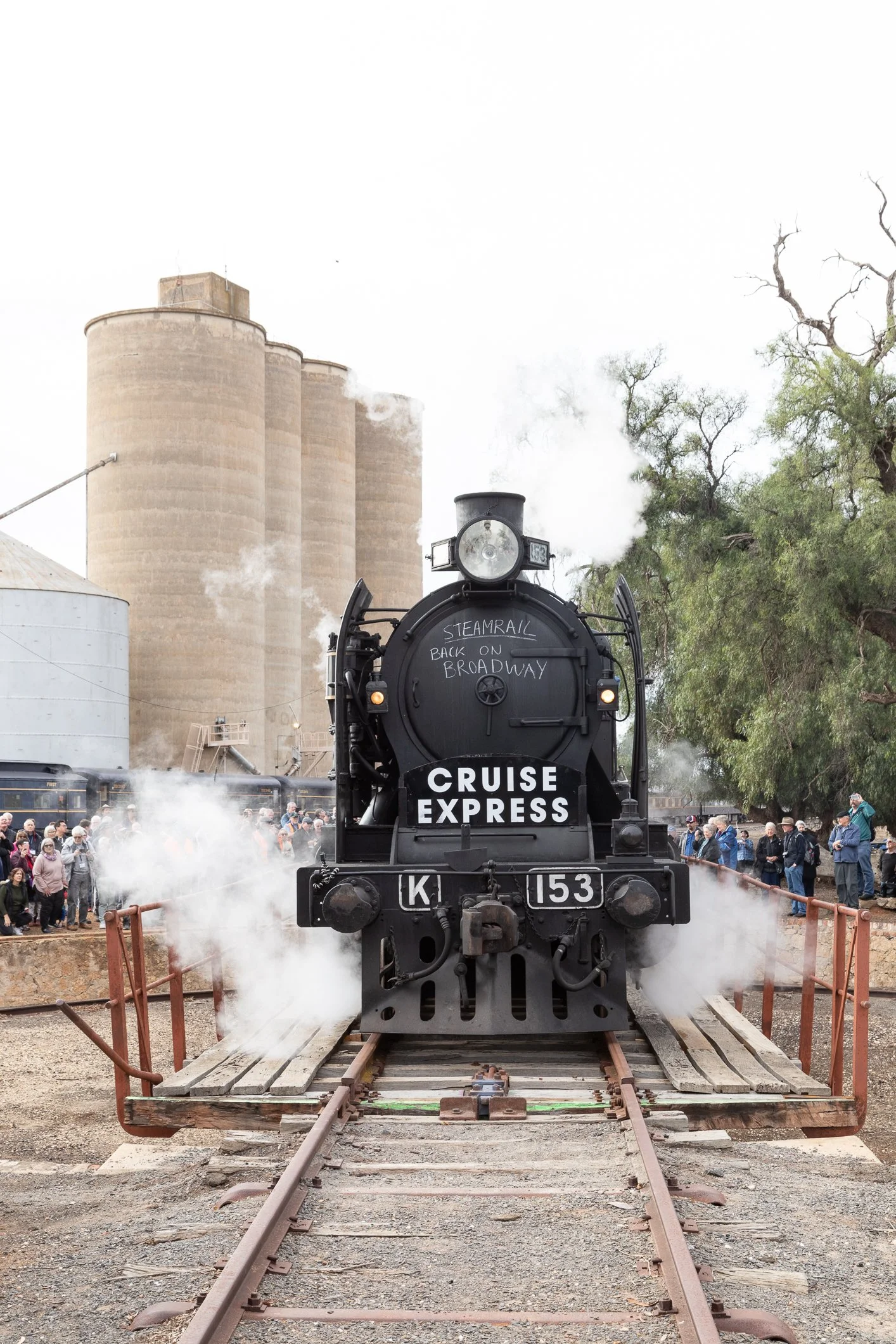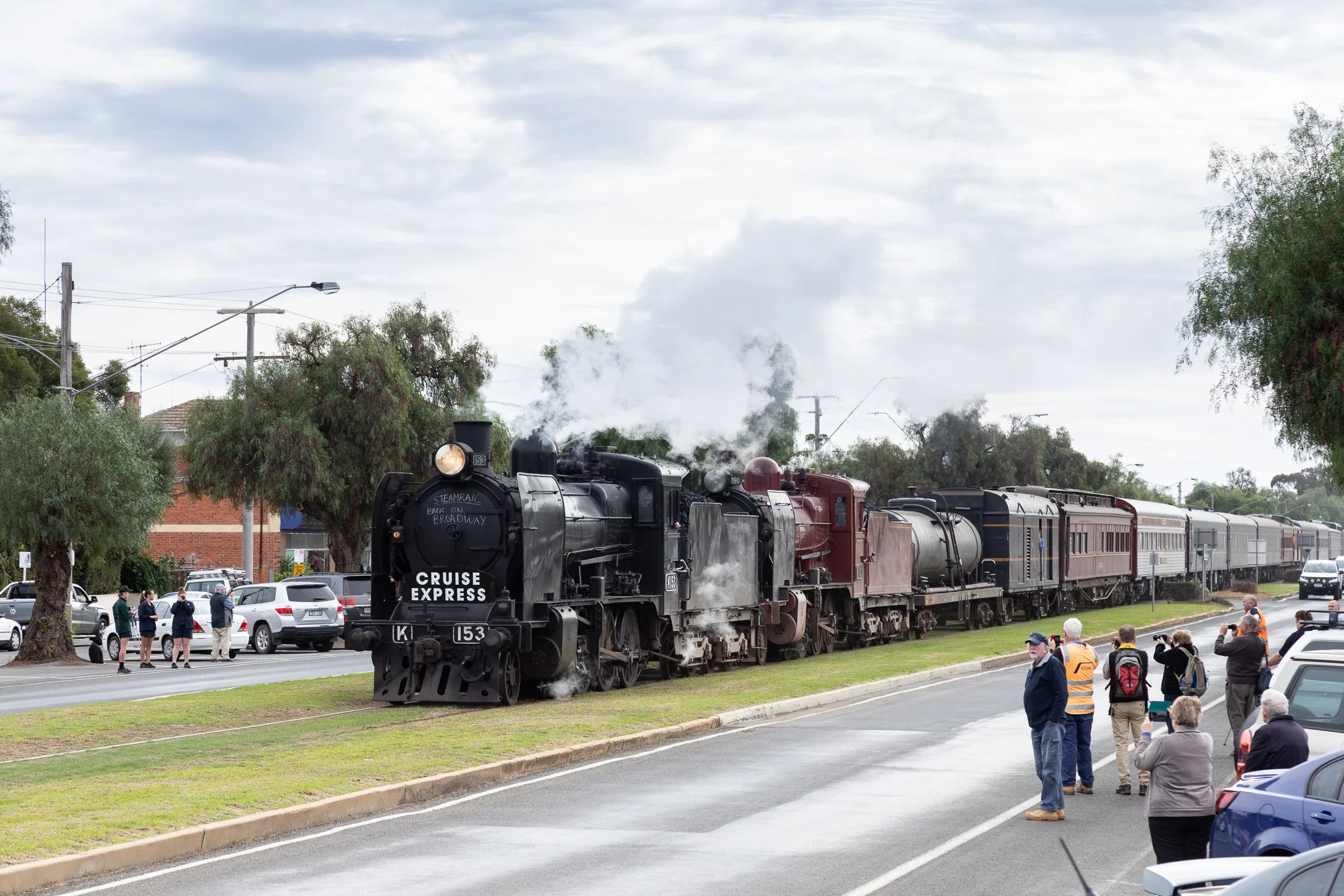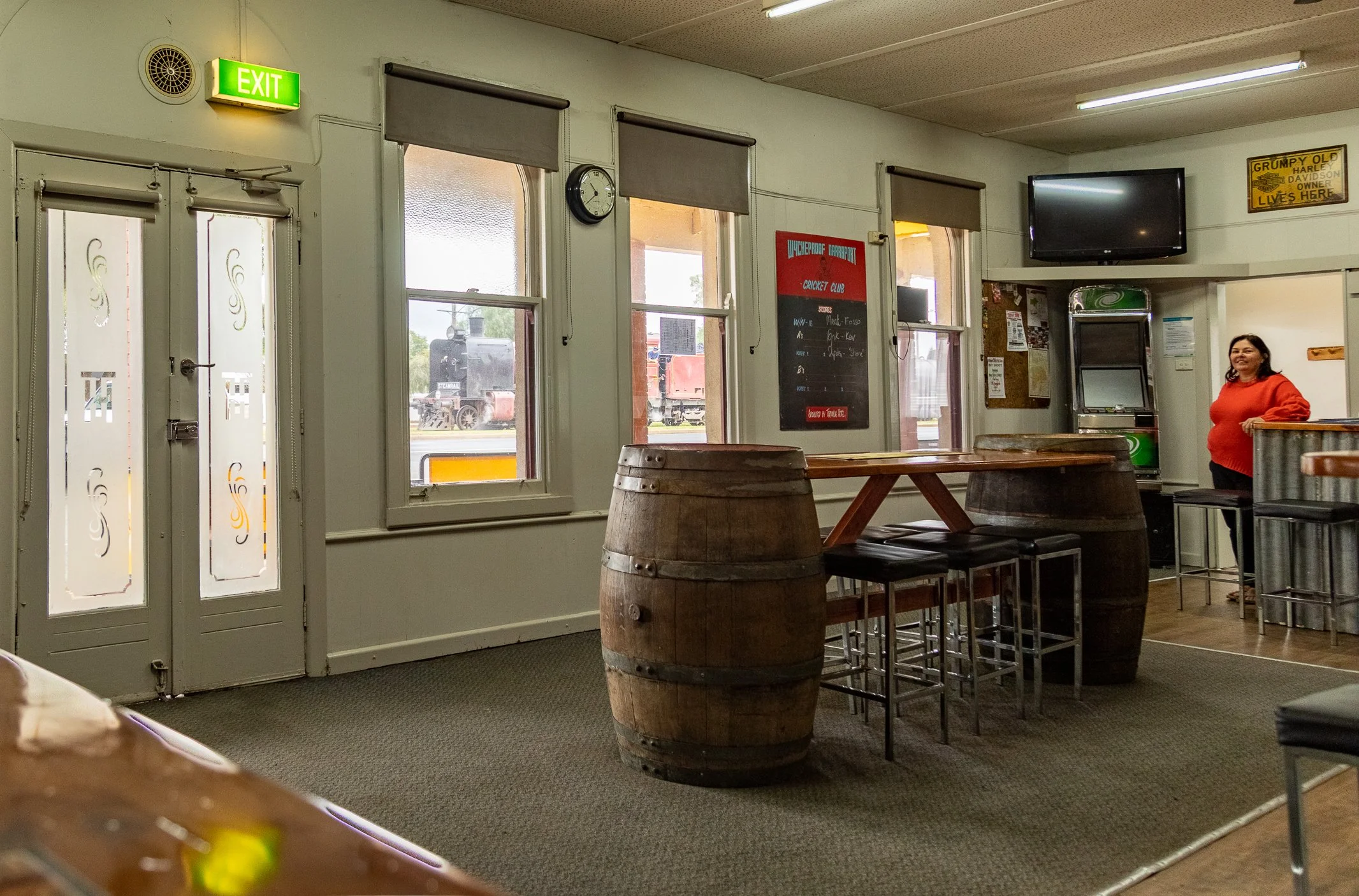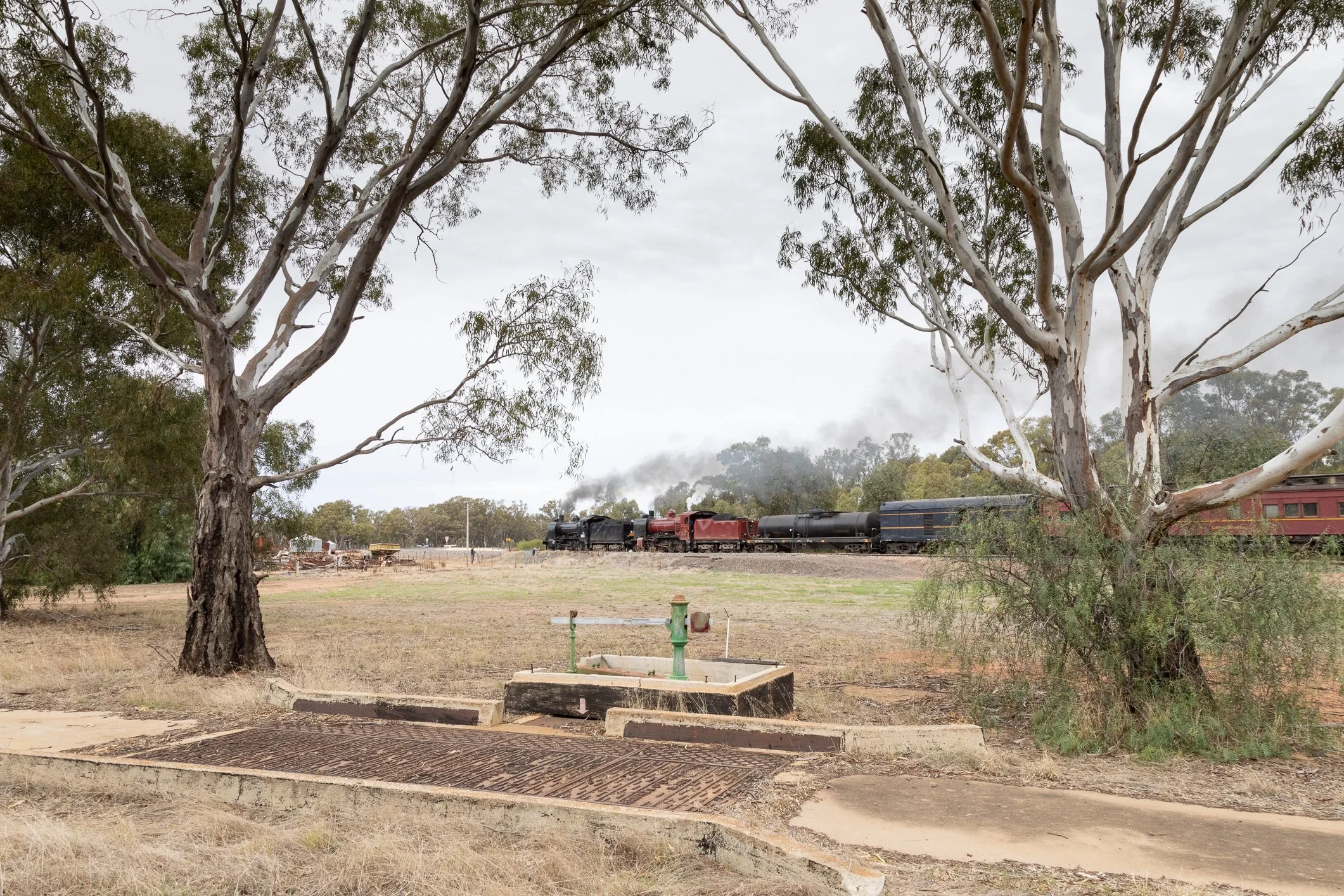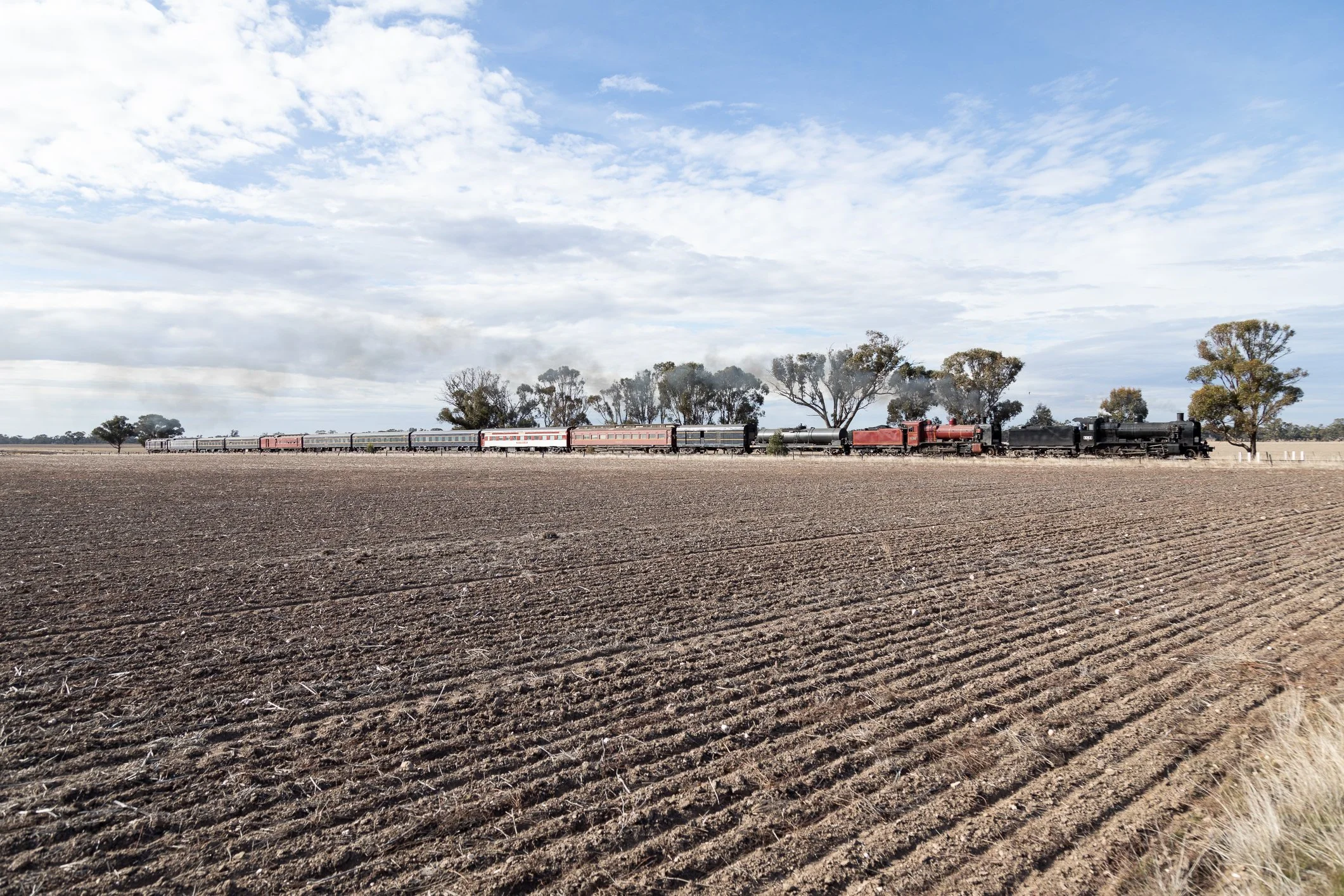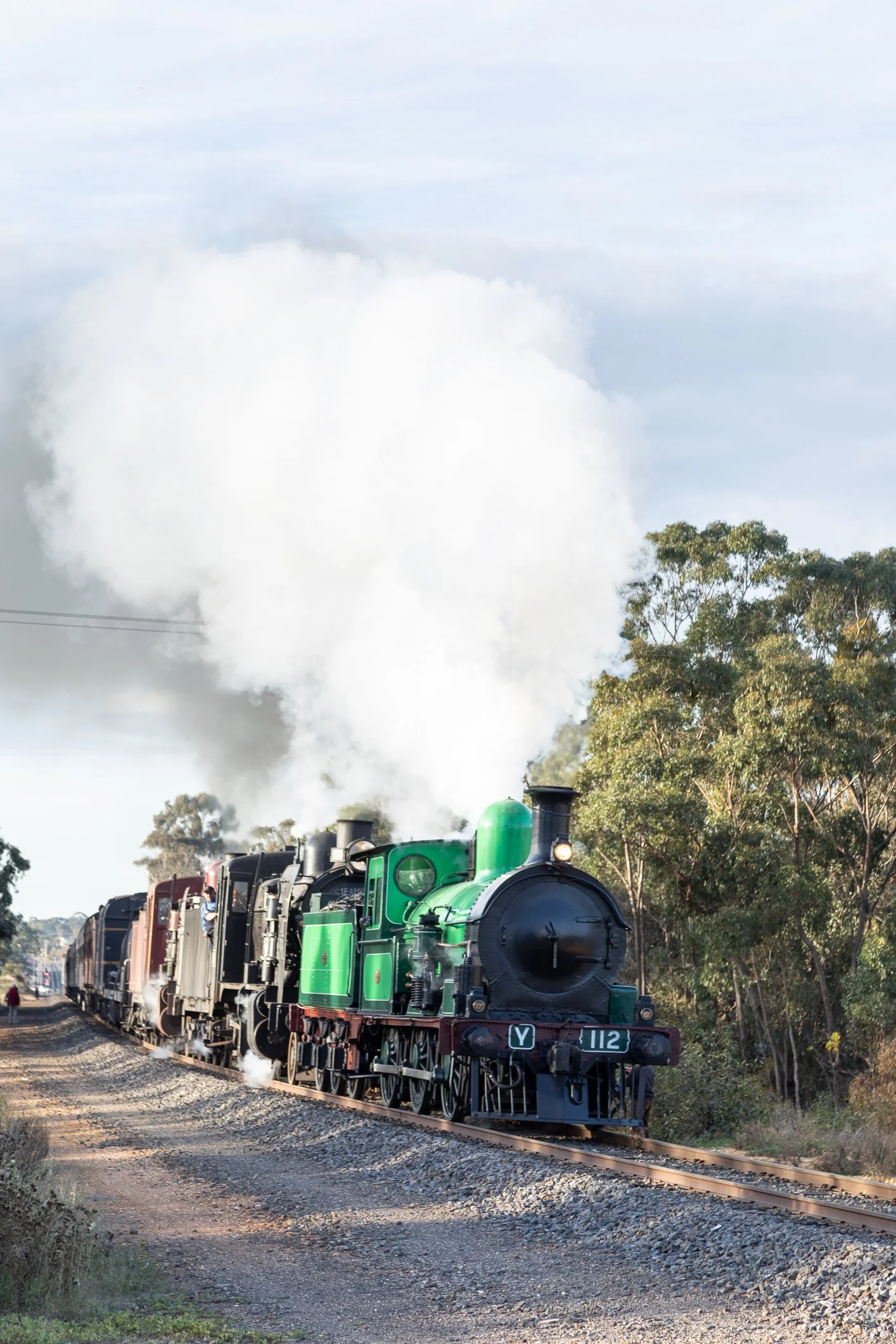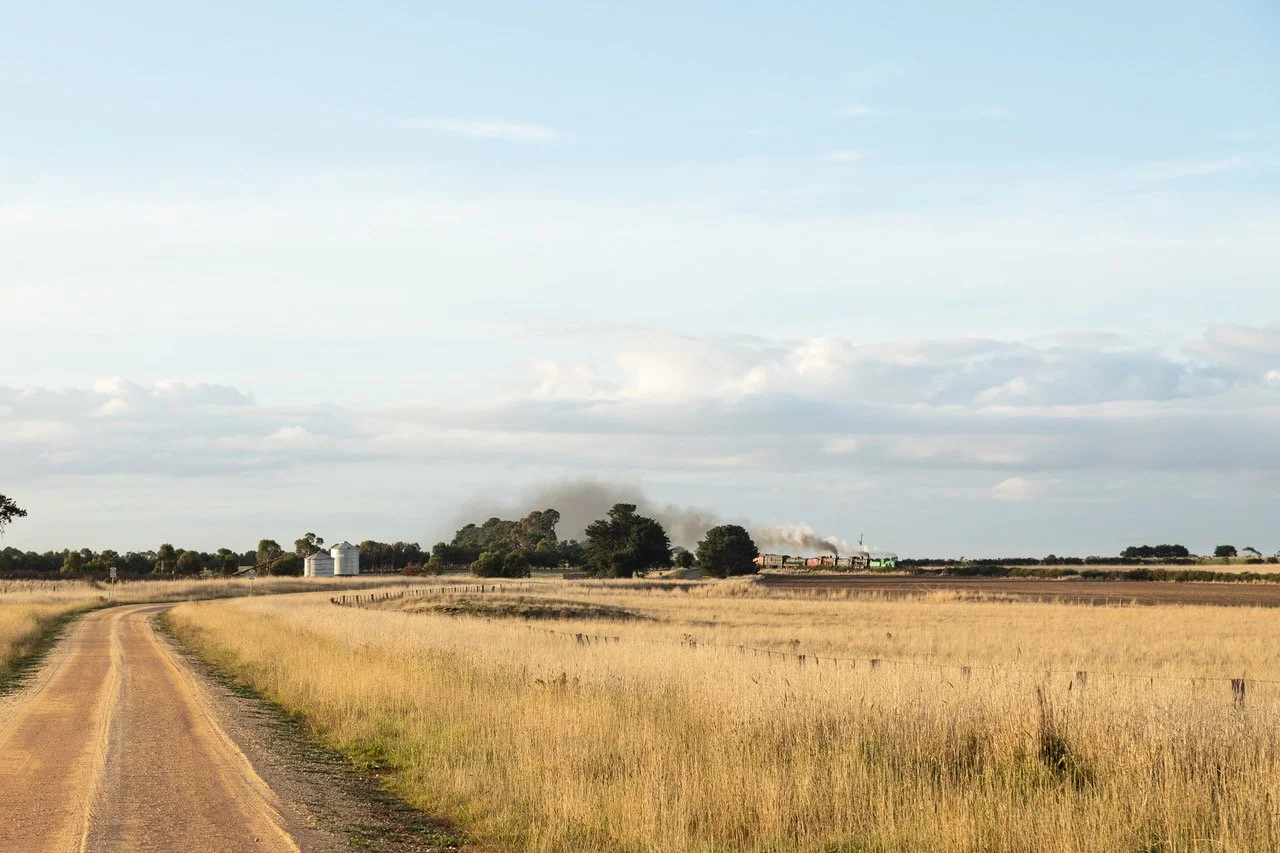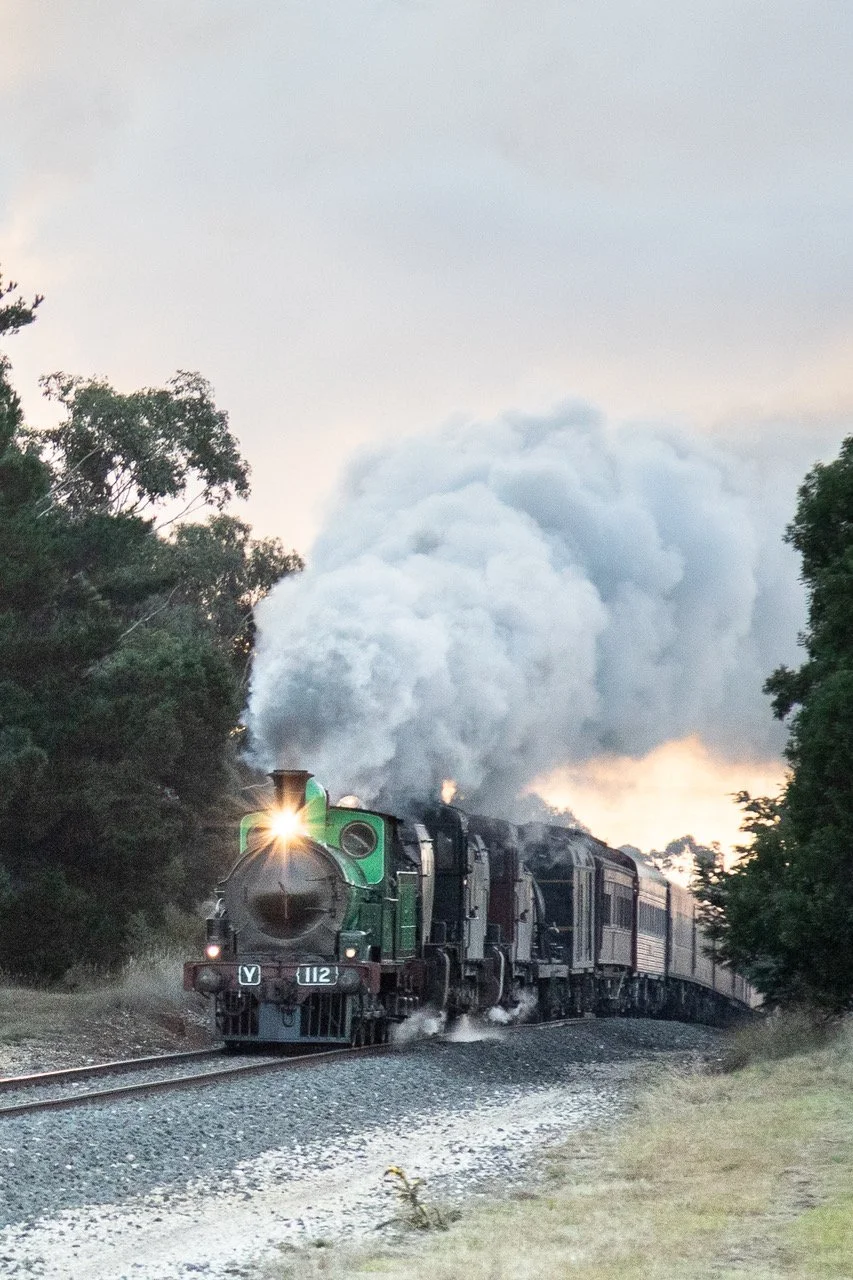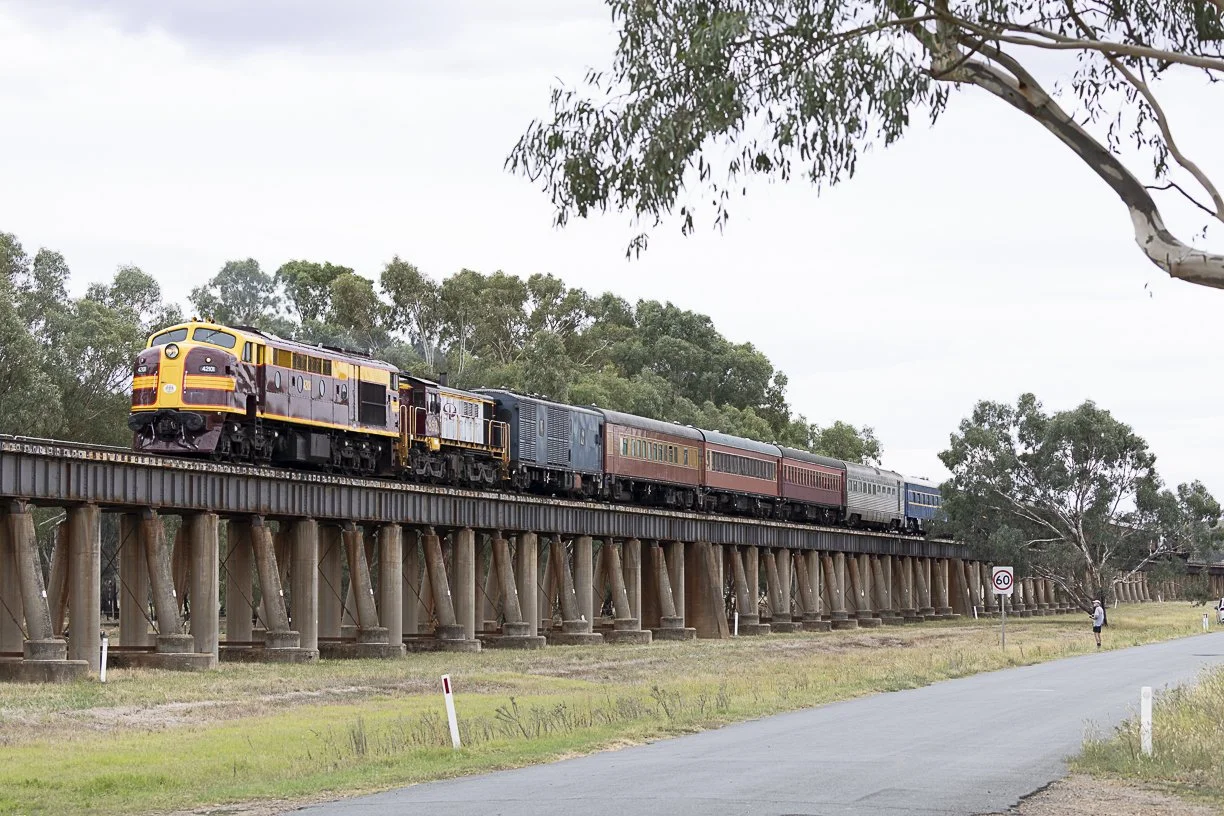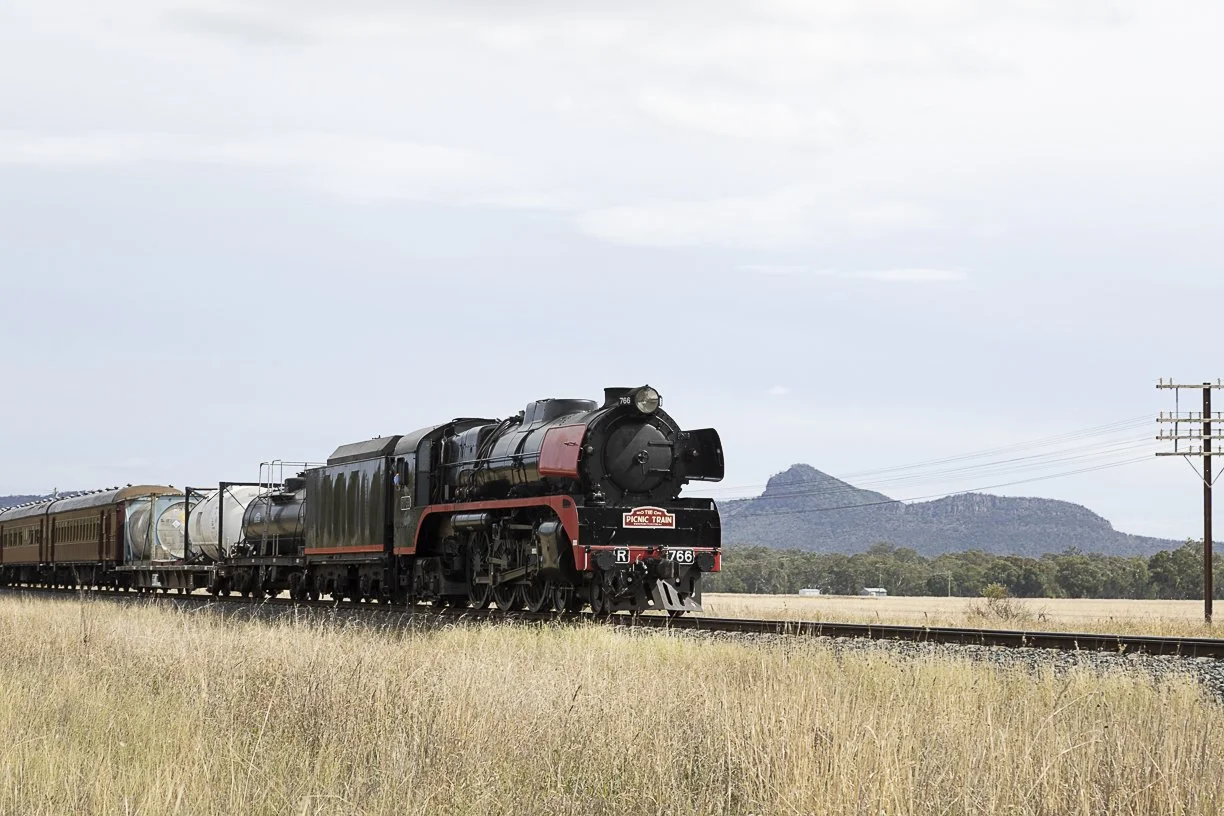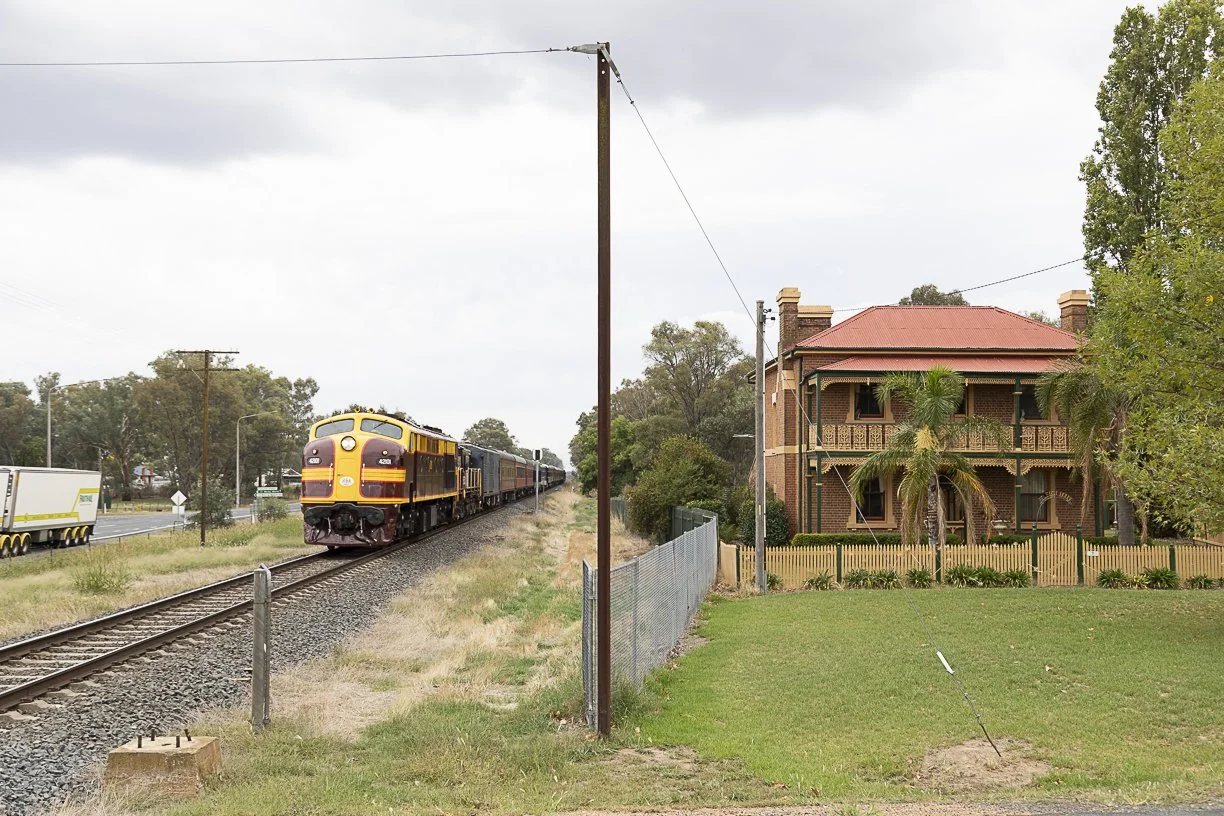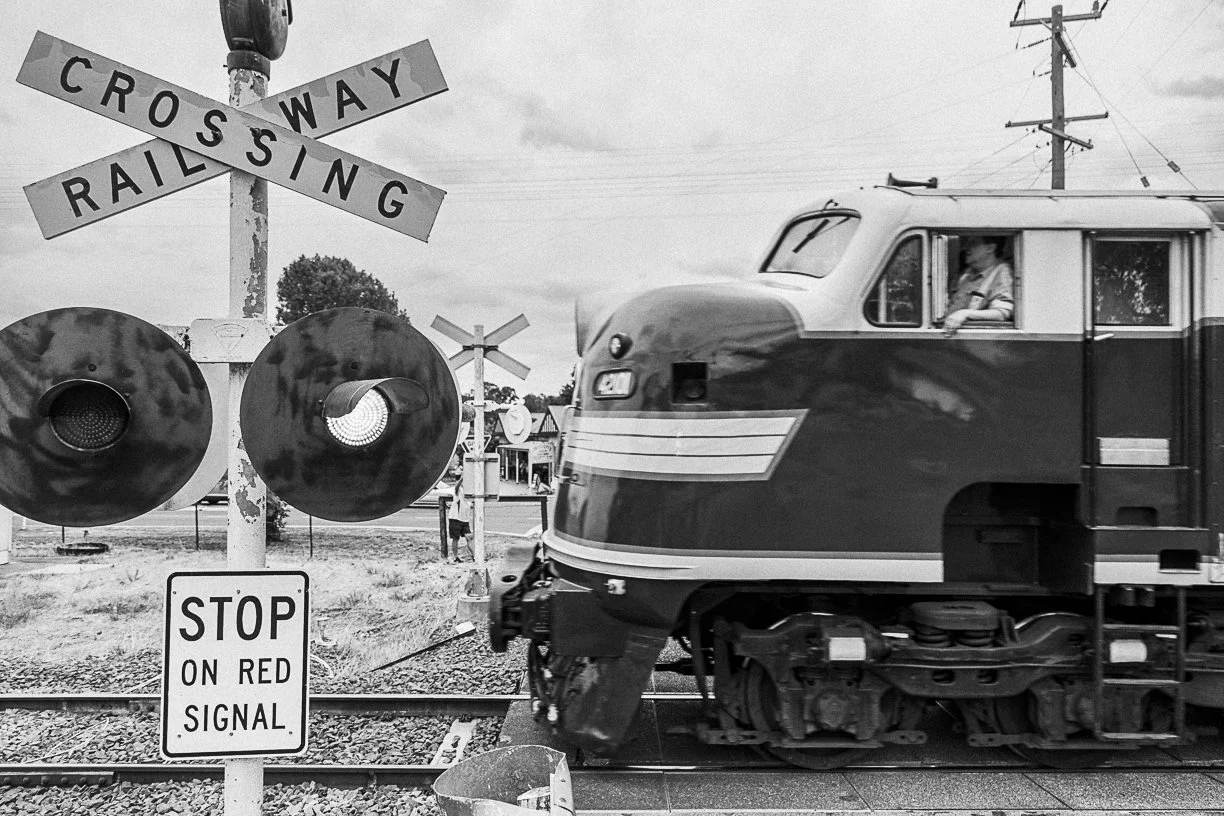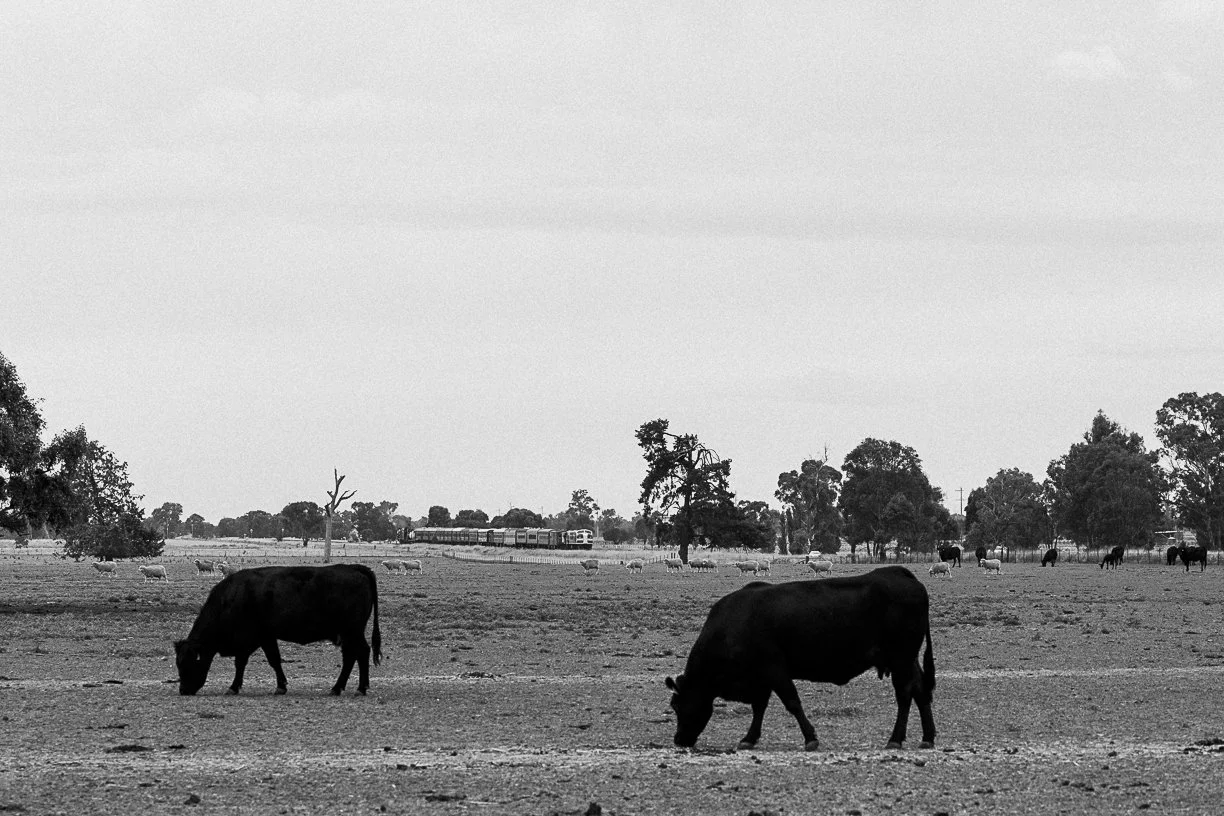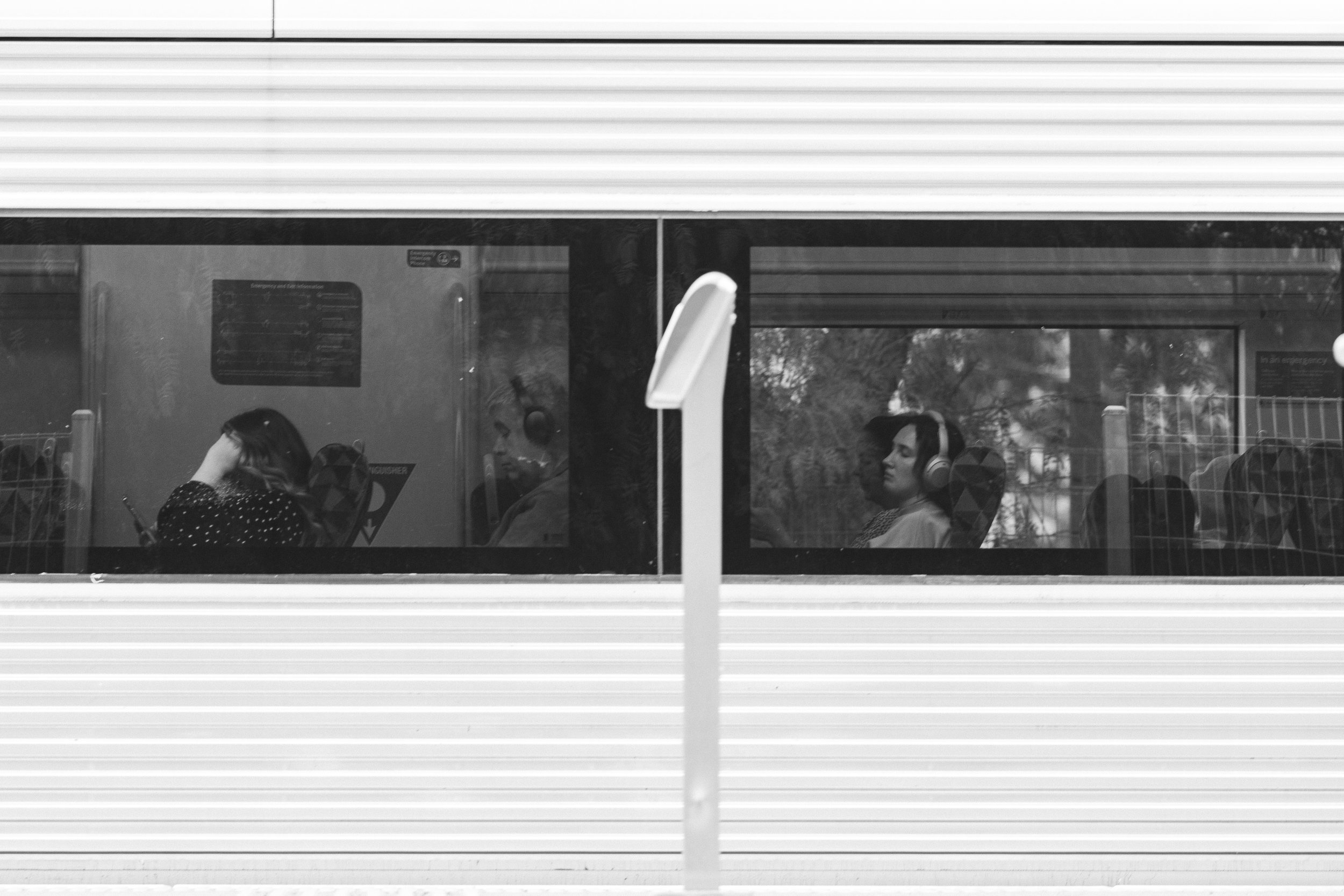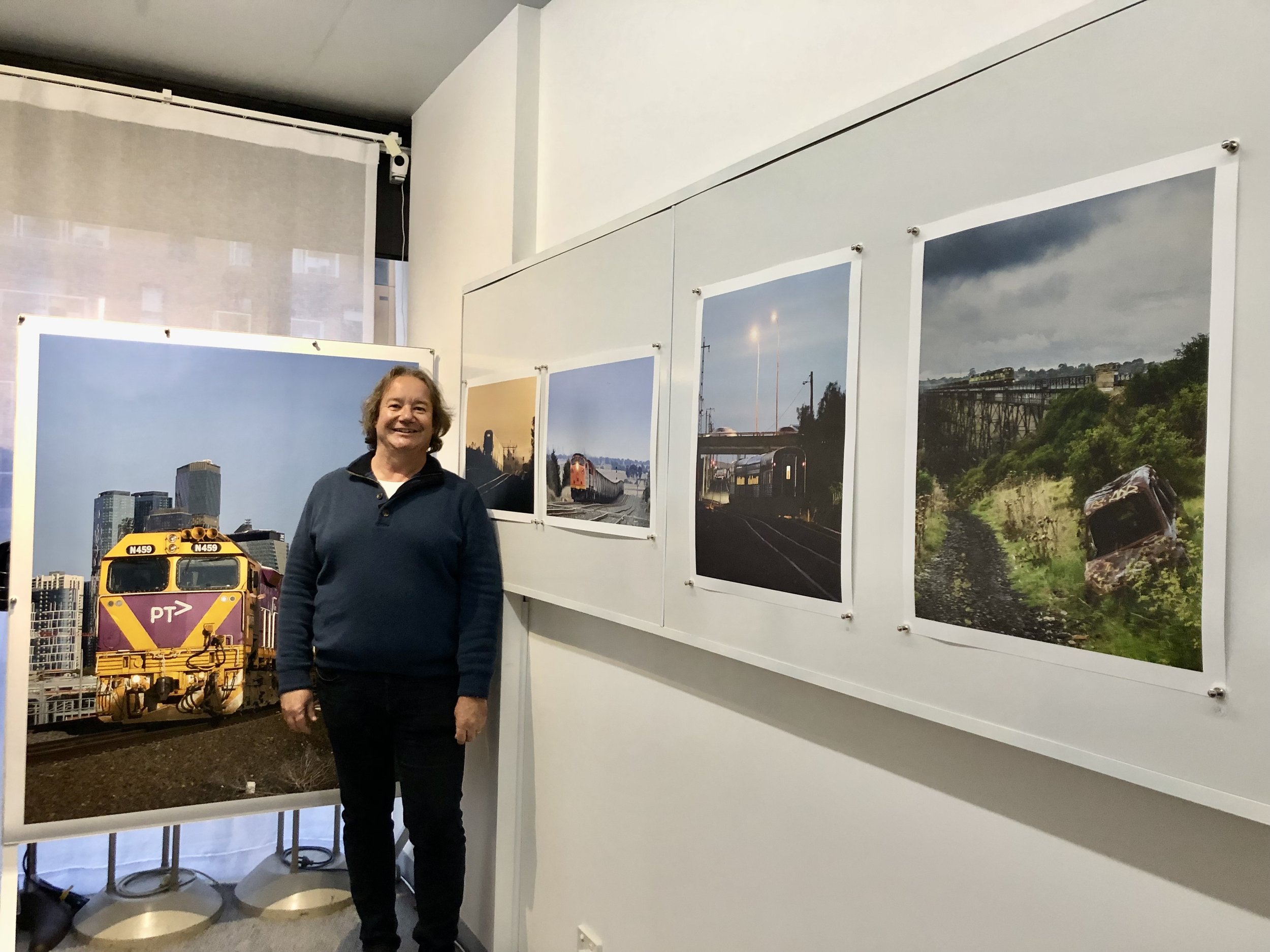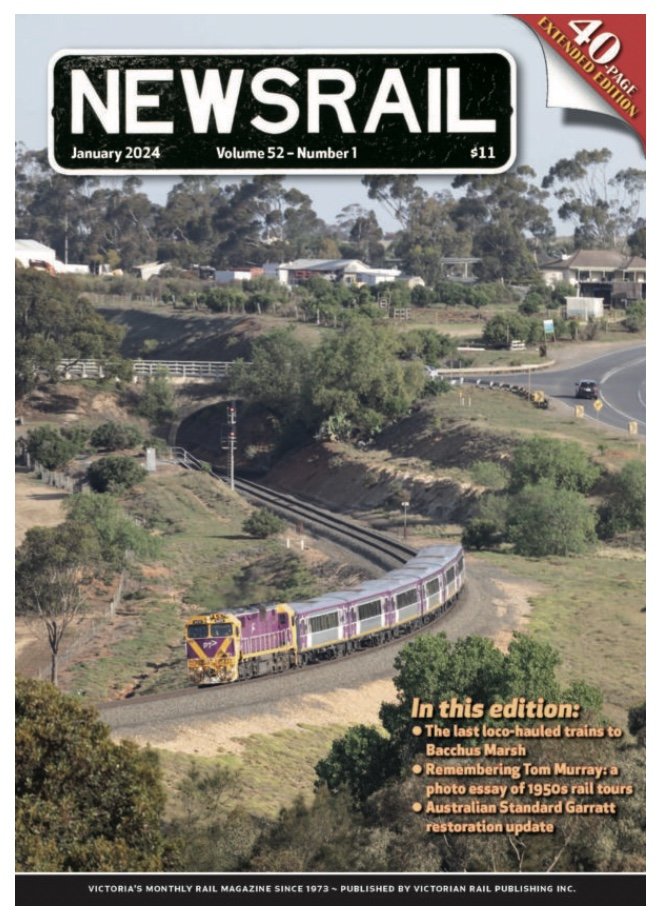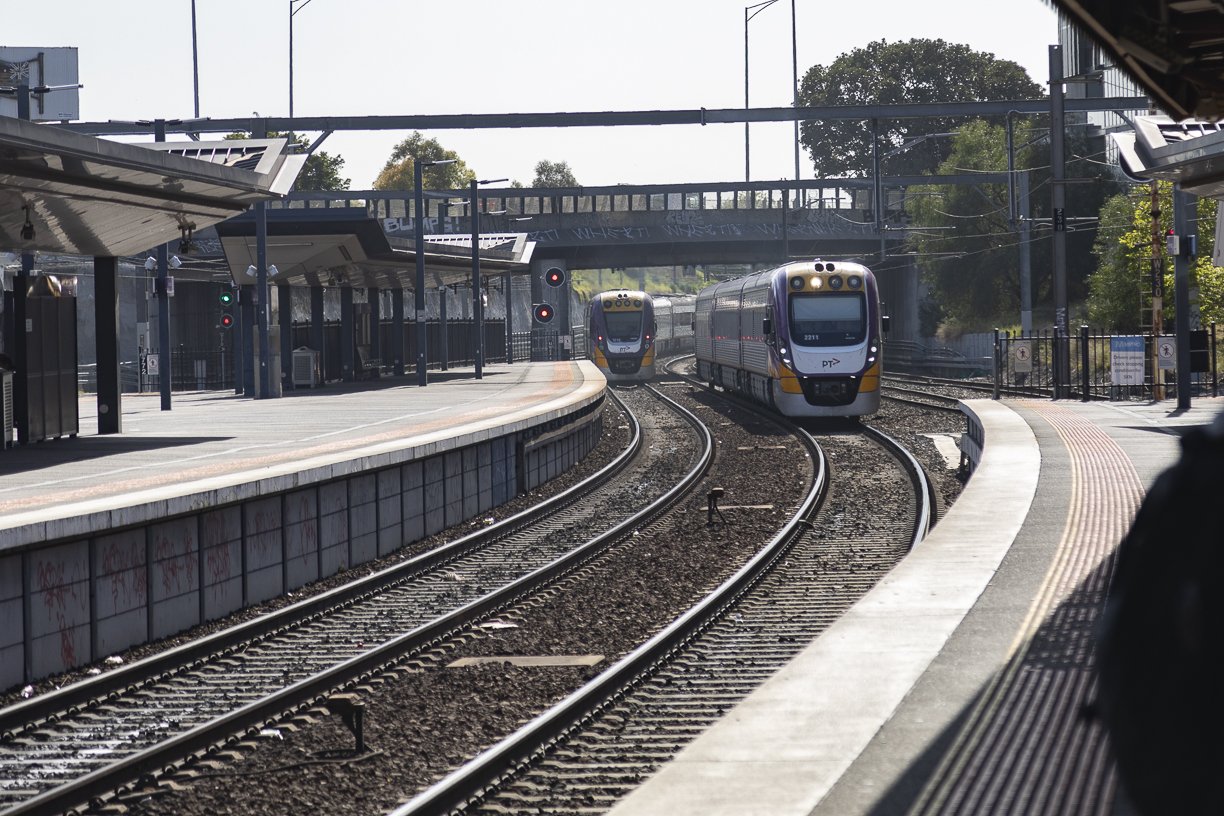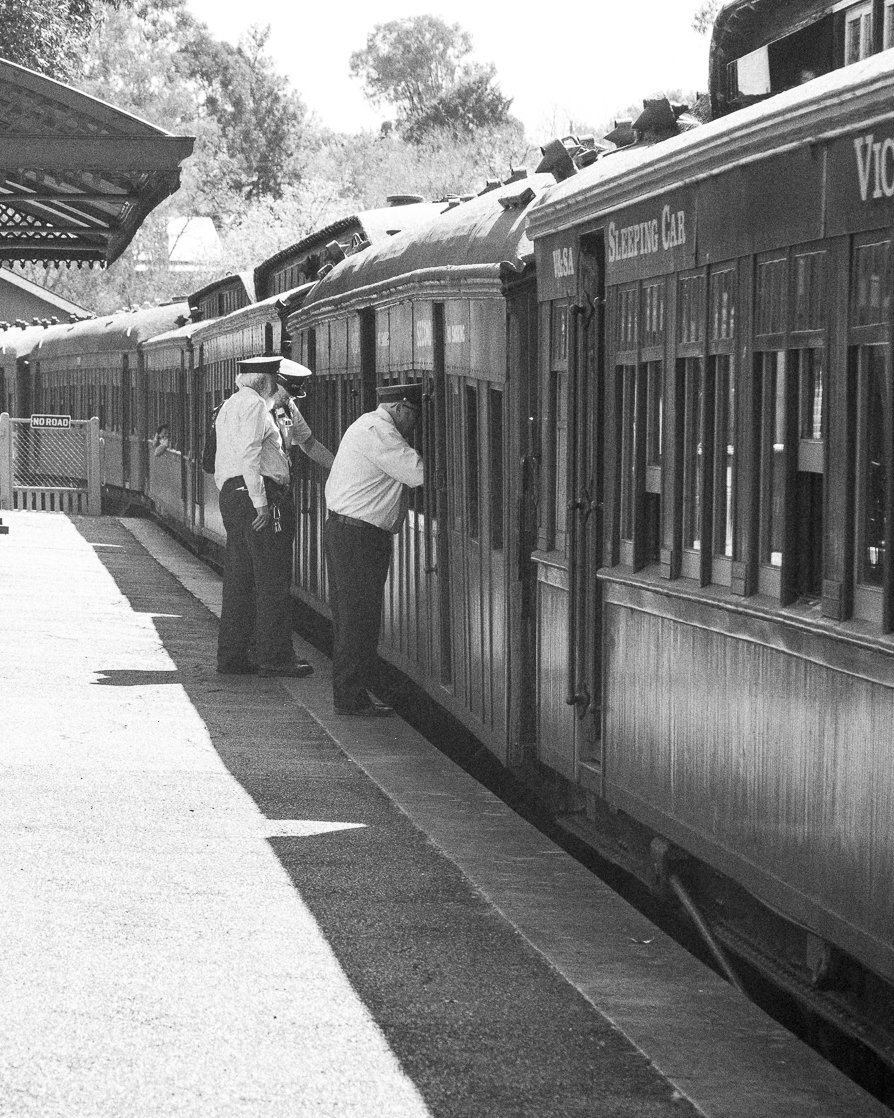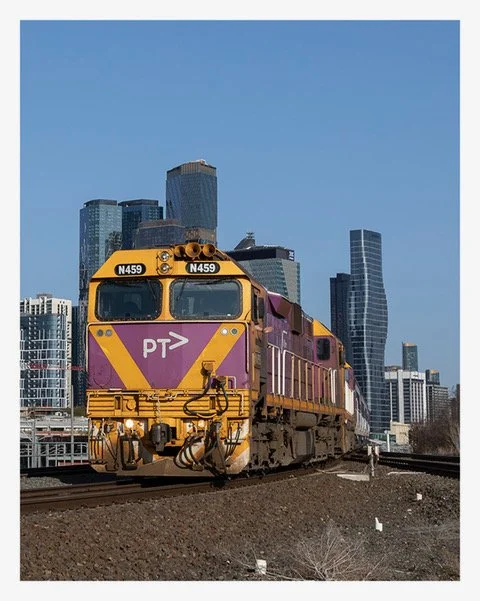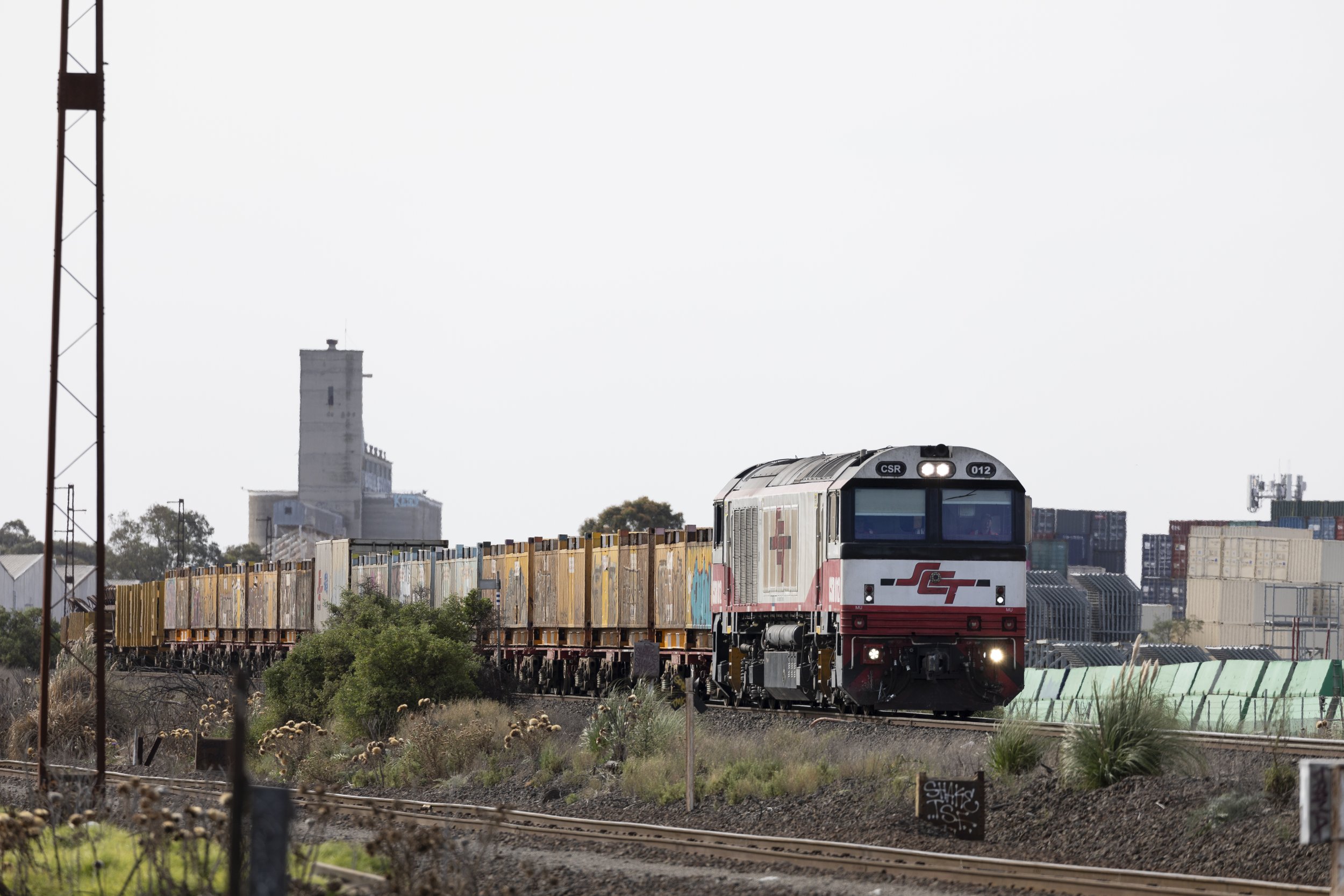The last dinosaur
The Swan Hill line is the last bastion of loco hauled services in Victoria, with 50 year old N classes and N sets forming the backbone of this corridor.
I was able to capture both the Swan Hill, and Melbourne bound services on a recent mid week trip to Bendigo.
Following the withdrawal of loco hauled services on the Warrnambool, Bacchus Marsh, and Bairnsdale corridors over the last year, (See my post here) the Swan Hill line is now the only line in Victoria where the N classes still haul 'classic' passenger trains.
The 340 km trip is serviced with two trains a day in each direction, supplemented by road coach (busses) connecting with trains at Bendigo.
I was heading to Bendigo on Thursday 27 November, so took the opportunity to get a handful of shots of both the down train - 7:39 out of Southern Cross, or Spencer St. in old money, and the up train - 6:54 departure from Swan Hill.
I stopped at Elphinstone, the northern end of the Taradale crossing loop to see if there was a potential to get a shot of the up Echuca Vlocity and down loco hauled crossing there. It was a long shot, but if you don't try, you won't know.
Framed by the old Calder Highway overpass, the up Echuca Vlocity passes through Elphinstone.
I went to the Old Calder Highway overpass and climbed a convenient pile of dirt to catch the Echuca as it roared through the closed station on the main, or west line, formerly the down line in double track days, with no sign of the N class creeping up to the home signal.
This gave me the opportunity to move locations back to the station, and set myself up leaning over the fence to capture a portion of the derelict station, and brick goods shed.
I only had a couple of minutes to wait before the throaty GM could be heard, then a blast of the horn as the train hauled by N 458 came around the corner.
The abandoned up side station building on the cut back platform is beyond tired as it bears witness to N 458 and its train rushing past.
After watching it disappear towards the Elphinstone tunnel, and Castlemaine, I hoped back in the car, and onto the freeway.
While the railway swings west to Castlemaine, the freeway cuts a straighter path to Harcourt, where the two meet up again.
This gave me time to get to Porcupine Hill, the summit of one of the two climbs between Castlemaine and Bendigo. The cutting is dug out of granite, Harcourt being a notable source for this stone, with large quarries in the area.
From here, the line drops down into the Bullock Creek valley, and Ravenswood loop before the last climb to Big Hill, and descending into Bendigo.
I actually had more time to spare than I thought, so was able to scope up a shot for the down, before thinking about what I wanted for the up. It was cloudy, actually raining a bit on and off so harsh shadows weren't a problem.
It's a long straight to the top of the hill for down trains, so went for a head on shot, before moving to the old highway bridge for the train starting to dip and curve. The points for the loop are less than a km from here, and as the train was being put into the loop to allow the up to have a clear run, was starting to slow for the 65kmh diverge.
Cresting the grade at Porcupine Hill. Having grown up with the line as double track, it still looks somewhat wrong to my eye with only one track.
Past the home signal for Ravenswood Loop, the train is starting to slow to take the diverge.
Another smooth cross had N452 come through under the old highway bridge and continue on the way south, while I walked back to the car to continue my journey.
163 years of exhaust smoke has stained the Porcupine Hill bridge, which at one time carried the Calder Highway. It sees little road traffic these days, but the Main Line is busier now than ever.
One of the many rumours doing the rounds concerning this last loco hauled corridor is that by mid next year the Ns will be confined to the Bendigo to Swan Hill section. Time will tell if it’s true or not, but the end will inevitably come, so I'll be making some more outings to catch more shots of trains operating on the 'Main Line'
Regards,
Scott
A link to the past
Australia’s oldest operating mainline locomotive has just returned to service after an extensive overhaul, re-entering service on one of Steamrail’s last steam trips of 2026.
On 22 November, Steamrail Victoria ran an interesting suburban rambler tour, visiting Williamstown, Werribee (both via Altona, and back up the straight), Sunshine, then via the goods lines under Footscray to Flinders St.
A break for lunch for those travelling, and servicing for the train, before heading out through South Yarra to Caulfield, and Cheltenham.
A short pause there, before heading back to Sunshine, and home to Newport via Brooklyn.
It was a very well patronised train, and had hordes of people line side for it, both enthusiasts and curious locals.
Some of these lines hadn’t seen steam for over a decade, and the Sunshine to Footscray section will be undergoing massive changes in the near future.
The train was operated in push - pull fashion, with 1940s built K 153 on one end, and star of the show, Y 112 at the other.
The Y was built in Ballarat by the Phoenix Foundry, entering service in 1889, making it the oldest operating mainline locomotive in Australia. Victoria’s first railway opened in 1854, so to have something from that early in the evolution of steam locomotive design still operating is remarkable. You can read more about this interesting loco here.
It’s actually one of few preserved locos that at present has spent more time in regular service than preservation, something that will eventually change, but not for a few decades!
The loco was for a time plinthed outside the Ballarat Civic Centre, before being restored by West Coast Rail on behalf of the Sovereign Hill museum, with Steamrail leasing the loco when West Coast ceased to exist.
This was the Y’s first tour after three years out of service, an extensive overhaul with new wheels and tyres being fitted should see the nuggety little loco around for a long time.
A massive shoutout to the team at Steamrail for preserving so much of our rail history, and having so many different locomotives available on a long term basis, the organisation leads the way for rail preservation in Australia.
Here’s a few photos I took, I hope you enjoy them.
Thanks,
Scott
On its first trip out of Newport Workshops since its overhaul was completed, Y112 spent October 11 running to Laverton and back on some bedding in trips.
Warren and Tim from Steamrail’s mechanical branch discussing next moves before the train headed back to North Melbourne for servicing.
The brick and bluestone of one of Flinders Street station’s little nooks frames the front end of Y 112 as the train heads back to North Melbourne for servicing.
Finishing with my favourite shot of the day, smoke and steam hang around the loco, while the light catches the rails heading out under Federation Square.
Gambetta, a snapshot of a morning in Nice.
When a day of rail travel on the metre gauge CP railway out of Nice didn’t come off, I spent the morning photographing trains instead.
Read about my morning here.
I've written about the metre gauge CP (Chemin de fer du Provence) railway previously in my post ‘So nice in Nice’.
The last couple of times we’ve visited Nice, the line which extends about 150km into the mountains to Digne-les-bains. has been closed beyond Saint André-les-Alpes, a distance of around 40km from the terminus.
We were back in Nice in September for a few days, and as it might be a while till we get back there, I decided I’d take the train to Saint Andre, in case it gets truncated- like a lot of things, a major rockslide could see it closing back further.
Unfortunately, there was rail replacement busses operating on the section of line I hadn’t travelled on, so I abandoned that plan - catching 'gutter transport' as some of my friends call it on mountain roads wasn't at all appealing - I wanted to travel on the railway!
Instead, I spent a few hours photographing the commuter services arriving and departing the little station of Gambetta.
Gambetta is the first station out of Nice on the CP, it’s literally a one minute train ride from the terminus, but was still busy with school students and workers alike. In the morning, there was a train every five minutes or so, which made for some entertaining watching, and photographing the comings and goings.
The single platform is wedged in between two level crossings at each end, and buildings either side on a curve. The crossing nearest the terminus is essentially the crossroad of Boulevard de Cessole, and Boulevard Joseph Garnier, protected by traffic lights, with a cafe on one corner, and a memorial to 27 resistance fighters killed on 28 August 1944 in the liberation of Nice from Nazi occupation tucked around the corner diagonally opposite.
Not far past the crossing at the other end, Rue Cros de Capeu, the line passes under Boulevard Mantega - Righi, and then into the first of a series of tunnels in the steep Nicoise suburban terrain.
My photography was limited to this small station and surrounding streets, but has given me a nice snapshot of the comings and goings in this corner of Nice. I hope you enjoy it.
X303 and X301 pause at Gambetta with an inbound service. These little railcars have been working the line since 1971.
Station work complete, the train crosses Boulevard de Cessole.
Five minutes later, the cars are headed back out on their next trip.
15 minutes later, X306, dating from 1977 heads into Nice past the memorial to the resistance fighters who lost their lives in the liberation of Nice.
Walking up to the Boulevard Mantega - Righi over bridge, this building caught my eye, far nicer than the modern chook pens that are being inflicted on the Melbourne skyline.
X307 heads out of Nice on the curve out of Gambetta.
And into the first of the tunnels the line passes through on the way to the Var valley.
The bigger rail motor class used on the line, an AMP series from 2008, 805. These dual car sets are used on the longer runs on the line.
And back out again. With a gap in trains, and the sun getting in an awkward height amongst the buildings, my last photo.
The 2026 calendar is here!
The 2026 A Railway Life calendar is here!
Printed in Melbourne on high quality A4 paper, which hangs on the wall as A3.
Please have a look, and lt me know what you think!
The 2026 calendar is here!
Hi Everyone, by the time you read this, the 2026 A Railway Life calendar will be rolling off the presses, ready to start mailing out.
With a similar theme as last year, a mix of steam, diesel and electric trains, mainly from Australia, with a couple of cheeky international pictures to add to the variety.
Like last year, it will be printed in Melbourne on high quality A4 paper, hanging on the wall as A3 giving nice clear pictures, and plenty of room to write notes.
Click here to purchase yours!
The final test print of the 2026 calendar
Framed Prints
I've been grateful to have been asked to provide several custom prints recently as retirement gifts for some of my work colleagues as the transition from working, to the next stage of life's adventure.
It's an honour, and something I'm both happy about, as I try and chose a meaningful image for these people who have spent well over 40 years in Railway Signalling.
I'm also a bit sad about it, as it means some of my greatest mentors are heading out the door for the last time - well deserved, and I thank them all for all the great times and helping shape the future of Railway Signalling in Melbourne.
Logistically, shipping framed prints may be a challenge, but if the idea of getting one of my prints ready framed appeals to you, let me know, and we can see if we can work something out.
Two Melbourne icons, Flinders St. Station, and a W class tram.
Under the ‘clocks’, Flinders St. Station.
Frankston signal box.
Thanks for reading,
Scott
Chasing ‘The shot’
I wrote this article for Newsrail magazine a few years ago after a couple of days out chasing a Cruise Express charter to Wycheproof.
It was a major event, and post Covid attracted a lot of attention from people all trying to get their version of the perfect shot (me included). I took a bit of a lighthearted look at how serious some people were taking things, stepping back and observing not just the trains, but the interactions of those giving chase.
The lighter side of railfanning in the modern era - chasing ‘The Shot’
This article was first published in the August 2021 edition of Newsrail, Victoria’s monthly railway magazine, but after re-reading it recently, I thought I’d share it here too. It’s been slightly updated to reflect the passage of time, and a few more photos than could be fitted into the magazine version.
After Covid lockdowns, 2021 had seen a return to mainline steam and diesel tours, and of course the resultant throngs of enthusiasts rushing and joggling to get ‘The Shot’.
Over the course of the 19th to the 24th of May, Cruise Express, in conjunction with Steamrail Victoria operated an extensive six day broad gauge tour involving eight steam locomotives on main and preserved lines, five of them on the one day!
Here’s a tongue in cheek account of chasing the first two days of this marvellous extravaganza.
On Wednesday morning, R Classes 711 and 761 hauled the first leg of the Southern Explorer tour from Melbourne’s Southern Cross station to Ballarat, via Geelong. Getting away on time in the chilly morning, the locos made good time until North Geelong, where delays with Safeworking processes saw the time slip somewhat.
With the sun barely above the horizon, R 711 and R 761 head out through Altona approaching Kororoit Creek.
I’d taken a couple of shots at Little River with Flinders Peak and the You Yangs in the background, before cutting to Moorabool Viaduct to get the nice side lit photo.
Early morning light on Flinders Peak as the first leg of the tour heads toward Geelong behind R classes 711 and 761.
There was already a handful of people there, and it was interesting to watch people park their cars ready for a quick getaway, then find ‘their’ spot along the fence to set up for video, still, or drone photography.
The spectacular 1862 Moorabool viaduct spans the valley of the same name. The steel trestles were added when the bridge was strengthened to the heavier locomotives and trains in 1918.
There was the usual chatter, why was such and such line closed and ripped up, why did this happen and so on. The two drone pilots had a chat about where they were planning to fly, so there was no mid air collisions, and all was well with the world.
Eventually there was the call of “train on” ( so please shut up, I’m videoing), the sound of a few, then more shutters releasing as the train made its way across the bridge, and climbed away from the other side.
Que car doors closing, engines revving, and the chase was on!
One of my miss-turns ended up being a great location, I climbed up on top of the Landcruiser for a little elevation, and several clicks later - Crossing Paths was captured.
From there I avoided most of the more coveted shots, and chose some more obscure side roads, missed a couple of turns and ended up blocked by roadworks near Lal Lal, and sat in traffic gently watching the smoke from the train get further ahead.
Eventually, arriving at Warrenheip, I joined the other 20 or so photographers and videographers on the bridge so we could all get more or less the same version of “The Shot”, before most of the crowd went racing into Ballarat.
Passing through the site of Warrenheip, the train has swung in parallel with the direct Melbourne line, and is about to start the steep descent into Ballarat.
I decided to head out to the site of Waubra Junction to avoid the masses, then cut for home as I had an appointment I needed to keep.
The photo wasn’t that great, so I won’t trouble you with it.
Thursday morning I arrived at Wycheproof at around 9:30 in time for the turntable recommissioning ceremony, complete with ribbon cutting. Along with the throng of motorcaders, (some worse the wear from a few beverages at both the local hotels the night before), ABC news, local dignitaries and large local turnout, there was one of the drones again, hovering a few meters above the onlookers making sure “The Shot” was captured, and no one could hear the speeches !
K 153 has the honour of being the first loco to use the recommissioned turntable.
A bit of time now to catch up and chat with people, photograph the train in the middle of Broadway, the section of the Calder Highway through the centre of Wycheproof, before heading south to a few locations, some less popular than others.
Back on Broadway - the train is facing south, ready for the long trip back to Melbourne.
A bit early for a beer, but thanks to the friendly publican, I was able to photograph the train from the front bar of The Terminus hotel.
One of the features of the Mallee country, aside from the frequently dotted wheat silos, is dirt roads, lots of right angled corners, and, even at this time of year, dust.
The railway south of Wycheproof virtually all the way to Wychetella cuts across the paddocks on an angle, which, even with the 80kmh speed limit of the train, requires some vigorous driving to re catch, and then get ahead of the train for the next attempt of “The Shot”
It’s been a while since anything was weighed at Glenloth station.
Even on the few sections where the roads paralleled the line, as photographers played a motorised version of leapfrog from top of one grade to the next, the clouds of dust kicking up from the cars always seemed to drift over the railway. This had the effect of obscuring, or at least giving a dust haze as some poor photographer having selected a good position had vehicles roar past!
Between Inglewood and Dunolly, There is a lot of bush country which limited photo opportunities, particularly with the low sun almost behind the train and plenty of shadows.
Between Inglewood and Arnold, passing through some good wheat country.
However, the climb out of Dunolly, despite the poor backlighting drew a large throng like moths to a flame.
There was around 20 car loads of people who had made the trek down the access track ,and were jostling for position. “You can’t stand there, I’m going to pan my video that way” - a very tongue in cheek to the 20 or so people in front, “ you’re all in our shot, you need to move back here”.
Someone on the other side of the line - ‘ Can I just go down there and squat down behind that bush’? ‘No! The bush isn’t that big’!
There was a second group of splitters off to the left, huddled behind a clump of shrubbery, who seemed to be far enough out of ‘The Shot’ to satisfy the main bunch.
The headlight of K153 appeared in the distance, along with the growing smoke as the fireman fed the fire for the assault on the grade. I was standing back observing at this point, not having joined either group, but having a chat with an old friend.
The crowd grew silent so the videos would only capture the sound of the train (and the clicking of the hordes of shutters) as the train ascended the grade.
From the splitters off to the left, a small child made a dash to the front, only to be reeled in by dad, the young fellow saying ‘but I wanted to see better’!
After a bit of a giggle, I took a shot of the splitters with the train in the background, and headed to my car to find somewhere else to try my luck.
Climbing out of Dunolly, a highlight in the search for the perfect shot.
Eventually, Maryborough Station, accessed from Mark Twain Drive beckoned, although the chance of getting a decent photo was slim. It was a chance to catch up with some more friends, before heading up Daisy Hill to capture a photo of the now triple header of Phoenix Foundry Y112 leading Ks 153 and 190 for the leg to Ballarat.
Arriving at the crossing near the top of the grade, I bumped into someone I hadn’t seen for over 20 years, so we had a brief catchup before being Shhh’ed by a couple of people videoing the train just starting the climb. We duly bit our tongues, while I admired the Safetrans S40 boom mechanism, and the shiny electronic bell on top of the mast we were all standing beside…
Shortly thereafter, lights and bells started operating, and a couple of people adjusted their position so not to get hit by the boom counterweight as the arm descended!
Y 112, built in Ballarat by the Phoenix Foundry in 1898 has joined the train for the run between Maryborough and Ballarat.
Back to the cars again, and off we all went, with people leaving the convoy at various points to find their own places, or to jostle for position with others who had been patiently waiting for the train for the half hour or so it was late.
South of Clunes in softening light.
The light was starting to get lower, and shadows longer, so numbers were starting to drop off as people gave up the chase, and headed home to have a rest, download their memory cards, and see if they had managed to get their own version of ‘The Shot’ they were happy with.
Topping Australasian bank, near Creswick, blue hour was starting to take hold.
I hope no-one takes this too seriously, and I’d like to give a massive shout out to the volunteers and professional railwaymen and women who keep our railway heritage alive. Without all the hours you all give freely, none of us would be able to ride on any preserved mainline equipment, or chase it in an attempt to get ‘The shot’.
A history making journey Part II
Part two of The Picnic Train’s transfer with former VR R766 to Albury to operate weekend shuttles. It was the first time a standard gauge R had visited Albury, and 17 years since sister engine, R761 had hauled the last broad gauge steam tour to the city.
Well, this gap has been a bit longer than anticipated, work, and a fair bit of travel sort of got in the way!
Anyway, picking things back up in Cootamundra….
Friday morning was a fairly leisurely start, with time for a sit down breakfast in the railway station refreshment rooms which has a great cafe - well worth a visit if you're passing through.
Discussions over breakfast turned to transport arrangements later in the day, the six Victorians travelling on the train were all intending to Melbourne later that afternoon, which required a few things to fall into place. Stuart, our expat Victorian mate was also in need of a lift into Albury as we were staying the night, but that was somewhat less of an issue.
Scenario one required the XPT to get to Albury well after the special arrived at Ettamogah where it was being stabled. Permission was also required for them to get off the train there so I could drive them into town, and, there had to be seat availability.
The fallback plan was to get a special letdown stop to disembark at Gerogery, and I shuttle them into Albury - a lot longer road trip, for me, with a higher window of risk of missing connections.
With all things heritage, there was absolutely no guarantees it would be anywhere near on time, the only thing for certain was I had my seat locked in no matter how it played out!
I left that with the troops to sort out during the course of the day, and started thinking about what I was going to shoot.
Back across at the train, the volunteers were hard at work replacing one of the turbo generators on R 766, a steam driven generator used to supply lighting on the loco.
The train was marshalled with 42101 leading former South Australian Railways 852, with now north facing R 766 bringing up the rear of the train.
Any steam loco travelling tender first in NSW is restricted to 60kmh, regardless of where it's positioned on the train, so it was going to be an easy, if at times tedious chase.
I decided to only head a short distance out of town and get the roundhouse in the background of the train. It ended up being fairly uninspiring, but ticked the 'record shot' box, not worthy of sharing.
There was a north bound empty grain on the way from Wagga, so the special didn't get far before being put in the loop at Harefield to allow it to pass. I was able to get a shot of both trains passing with locos featuring the distinctive GM bulldog nose, one in preservation, the other, CLF 2 still working full time 50 plus years after it was built.
Crawling up the loop at Harefield for the first of several crosses of the day.
CLF2 and friends notch up to get a run past the special at Harefield.
Next spot was a nice curve with the silos of Shepherds as a backdrop, before the 'inland port' of Bomen.
In the passing lane at Bomen.
The train was held here again for the Port Kembla to Melbourne steel train to get a run, giving me plenty of time to get down to the long Murrumbidgee floodplain bridge for both the steely and then the special.
The heavy coiled steel train from Port Kembla to north Dynon rumbles across the Murrumbidgee flood plain bridge.
Followed shortly after by 42101 and 852 at the head of the patchwork assortment of cars.
Kapooka on the south side of Wagga was reached with plenty of time to spare, the old highway gives access to a decent spot at the top of the climb out of the town. It's a spot I'd been to a couple of times before, we spent a pleasant morning there a few years ago cooking a BBQ breakfast while 3801 ran past us on shuttles!
Cresting the steepest part of the climb out of Wagga Wagga at Kapooka. All three locos were working hard!
Pressing on toward Uranquinty, I was keen to get a shot of the R with The Rock (no not Dwayne, the prominent geographic feature) rising up from the undulating country to the south.
I had a couple of attempts, and kept going, but not far, as the train slowed for another cross, the third in 50km. This time it was the north bound steel train to Port Kembla, and, following it, the Sydney bound XPT.
I shot the steel at the up end of the loop passing the two diesels, then decided to get the XPT passing the R at the back of the train.
I couldn't get a decent angle particularly easily, so decided against my better judgement to wade through chest deep grass beside a small creek to get a better view, and hoping I didn't disturb anything wriggly with sharp teeth!
The steel train was really on the move as it roared past the special sitting in the passing lane.
The long serving XPT also came through at a good pace.
Once both trains passed, the train had a short run as far as The Rock, a mere 15 km further south.
I finally got a shot of the R with The Rock in the background south of Uranquinty.
Here, the train pulled into the platform which allowed the R to take water, and the handful of passengers to hop off the train.
I decided to grab some lunch and water at this point, and catch up with the rest of the group. Like most towns in the area, the Main Street is wide with interesting old buildings to admire.
The old shed dates back to the era when grain was conveyed in bags, both it, and the bulk silo behind no longer serving the use they were built for.
The Rock, and more relics from the past as the train drew clear of the platform into the down loop.
The train shunted out into the down loop, to allow the next train through which was the Melbourne bound XPT.
There was no way at this rate my six co conspirators were going to get back to Albury in time for the V Line service, and, had confirmed there was no possibility of a set down at Gerogery - the platform was long demolished.
So they decided to take their chances, and try and purchase a ticket on board the XPT which, according to the on line booking system was full.
We had a bit of a joke while they were on the platform about the likelihood of them getting on the train, and, a bit like a pantomime, the train came in with them on the platform, and, like magic, when it left after what I thought was a bit too long of a pause, left, and they were gone. Apart from Stuart, our expat who was heading back north the next day from Albury.
The southbound XPT accelerates away from The Rock, fortunately with my friends onboard!
So, once again, I ended up with unplanned, but certainly not unwelcome company!
The final 83 km was stop free, for the train at least, while we, and many more people then the day before played leap frog trying to get phots of the train. Close line side growth limited things, apart from at crossings, so we decided to mix it up a bit by heading down some dirt roads and tracks to see if there was some different cross paddock shots to be had. Not a lot of luck, but worth a try.
Gerogery was decent, with the former Station Masters house setting the scene, and then closer to Table Top, driving past the crossing to get a wider view across the paddock was a bit nicer than jostling elbows for a tight 3/4 shot.
The elegant former station masters house at Gerogery has had many trains past it, but never previously an R class.
The 42101 showing off its classic shape as it leads the way through Gerogery.
Out amongst the sheep and cattle at Table Top.
From there, we were almost out of spots - I sighted a farmhouse that would have made a nice backdrop, but by the time we were able to double back on the freeway, were too late.
That was it for the day, aside from scoping a shot for the next morning, then heading into Albury to check in to our accommodation and out for a couple of beers and dinner.
Saturday morning it was downstairs for breakfast, before venturing out into the drizzly morning to catch a shot of the R on the train, ready to depart north for the first time.
What's left of the Albury railway precinct will soon be undergoing another change, with the existing foot bridges removed and replaced with higher ones to allow double stacked trains.
The signal box that once controlled all train movements to the north is in a sad state, a shame as the station building itself is extremely well presented.
Framed in the wire of the not long for this world Albury station footbridge.
We then headed back out past Table Top to where the railway crosses Bownna Creek, almost halfway back to Gerogery.
We had plenty of time to sort ourselves out before the whistle, and then sound of the exhaust could be heard as the R dragged the train up the steady climb.
Crossing Bownna creek on the first shuttle of the day, and first time an R had departed Albury heading north.
A couple of shots, and listening to the train fade off into the distance, then it was back into the car to drop Stuart in Albury, and continue home to Melbourne, I had a birthday party to go to!
It had been a great couple of days chasing the train over its 420km journey, and catching up with friends new and old.
After now having done a similar trek to photograph the 59 (See The Picnic Train heads south) I think next time there's an opportunity to travel on a longer positioning trip like this one, I'll enjoy the experience from the train.
Thanks for reading and following A Railway Life!
A history making journey
In March 2025, The Picnic Train operated a transfer train to Albury, on the NSW-Victorian border to operate a series of weekend shuttles.
What made this trip so special is that it was the first time a former Victorian Railways R class had visited Albury since 2008, and the first time one had arrived on standard gauge.
Hi Everyone,
R 766, a former Victorian Railways R class operated by The Picnic Train made the historic journey to Albury in the last week of March 2025. It's the first time a R class has operated to Albury from the north, as R 766 is the only example of the class that has been converted to standard gauge.
I headed to Goulburn Wednesday afternoon, chased the train from there to Junee on Thursday, Junee to Table Top (on the outskirts of Albury) Friday, and, took a couple of shots of the first shuttle before cutting for home as we have a birthday party to attend.
The round trip was 1550km, I took 725 photos, so I had some editing work to do!
It was a great trip, with fantastic company of an afternoon and evening with friends who were photographing or travelling.
When I chased The Picnic Train through Southern New South Wales on the Main South two years ago, it had 5917 on front, you can read about that here.
The 70 R class passenger locomotives were ordered from the North British Locomotive works post world war two, and designed to be able to be converted from the Victorian broad gauge of 5' 3" (1600mm) to standard gauge 4' 8 1/2" (1435mm). Due to diesels arriving at the same time, they were all retired before any widespread gauge conversion of lines happened in Victoria - which wasn't really a thing until the 1990s.
After only 15 years in service, R 766 was steamed into a park in Bendigo in 1970 and plinthed, never to be steamed again.
Growing up as a kid in Bendigo, I don't know how many hours I spent crawling all over the loco, but it was certainly a lot!
It had a reprieve in the early 80s, this time towed out of the park by a T class diesel, and replaced by classmate R 711 and was restored, before changing owners a couple of times.
Preparations are well underway to retrieve R766 from its location near Bendigo railway station. The photo taken on 19 December 1981 has kindly been provided by Bruce Dixon.
The restoration project saw 766 and some former South Australian Railways passenger cars operated as The Melbourne Limited by Steam Age Australia as an upmarket Art Deco inspired train. This was the first time a private operator was attempting to run on the Victorian Government system, something we now think of as commonplace, but at the time was groundbreaking.
Unfortunately the venture failed.
It was then sold to Australian Vintage Travel, A former Manly Ferry, the South Steyne, and a DC3 aircraft rounded out their package funded by a very forward thinking Victorian Economic Development corporation initiative, possibly 40 years too early!
Australian Vintage Travel converted the cars to Standard Gauge, for operations in NSW, and R 766 was parked up at Newport Workshops.
This venture did’t last too long, and once again, the future of R 766 was up in the air.
In March 1989, the locomotive was bought by a group of enthusiasts who banded together as Locomotive R 766 Inc. It was operated for a time by Steamrail, and then West Coast Rail, until that organisation also ceased operations. It continued to operate with the Steamrail fleet into the late 1990s.
An offer of outright purchase, rejected by the group was later amended as an annual renewing 30 year lease by the Hunter Valley Railway Trust, as the name suggests, in the NSW Hunter Valley, near Newcastle.
In the early 2000s, the majority of the work to convert it to standard gauge was completed at Newport workshops, before the now kit of parts was loaded onto trucks, and taken to NSW to finish the project.
It's been back in service for a couple of years, but March has seen it venture down to Canberra for shuttles over the Labour Day long weekend, and, late in the month travelled from the railway town of Goulburn to Albury for a weekend of shuttle trips.
29 and 30 of March were the dates set for shuttle trips to Gerogery, about 30km north of Albury. There's no platform there any more, so it was a case of out led by the R, and back with heritage diesel, 42101 at the south end of the train.
So, back to Wednesday. I left work around lunchtime, and thanks to the wonders of modern technology was able to do a couple of meetings in the car on the seven hour drive to Goulburn.
Our group of travellers were all arriving from different points, and mostly around 7:30pm - one from Wollongong, three from Melbourne via plane and train, and three more had arrived earlier by XPT. Dinner plans were made and booked, and another photographer was added to the crew, arriving by car from Sydney.
Checking in at the accomodation I'd booked for two of us didn't go according to plan, on opening the door to the basic room, we were confronted with a double bed, not the two I expected.
Back to check - in, and I received a very unsympathetic we're fully booked, just put a couple of towels between you! Apparently my fault for booking through a third party agency.
I went back to the room, and checked I hadn't made an error, and had booked directly - then went back for another discussion.
There was another person querying the lack of off street parking available, not being satisfied with the reply, he decided to go elsewhere, with no refund, so I was able to negotiate a good price for that room, crisis averted!
A decent feed, a few drinks, and off to bed for an early start Thursday morning - 07:15 departure, which suited some of our group far less than others!
Picking up a coffee and a bite to eat, we started gathering at the station by 07:00, in time to photograph a north bound containerised grain, before a column of steam was seen rising from the loco shed.
I had a very comprehensive set of notes on suggested shot locations from Alan Williams, @ Round the world in a steamy haze , Google Earth screenshot printouts to match, and a few more ideas from conversations over dinner.
First shot on the list was a departure from Goulburn, from the road over bridge just down from the station. Despite the historic nature of the trip, there was only four people there, myself, Trent who joined us for dinner, fellow Victorian, Dan and another bloke who we didn't see again. We did bump into a few other people during the day here and there, and zigged and zagged to different locations ourselves.
Getting underway from Goulburn, the fireman is being enthusiastic with the oil burner tap!
The R put on a very smoky departure, and then it was back to the cars to head to Breadalbane. I wasn't that keen on the spot I'd picked, so went to the site of Cullerin station, which is also where there's a sign proclaiming the top of the Great Dividing Range. It was actually the location Alan had in mind, I'd misread the notes.
The sun was in and out of the clouds while waiting for the train to arrive, which it did eventually, later, and slower than expected, with smoke drifting in front of it. It pulled up not far past the crossing, apparently to check for warm bearings. This ended up happening a few times during the course of the morning, which helped get an extra few shots in!
A thumbs up from the fireman as the train rolls over the top of the Great Divide at Cullerin.
A couple more shots through the Cullerin Range, with the road cutting a much straighter path than the railway, at times on the original pre 1915 single track alignment. The 'new' alignment takes the double track through a series of big sweeping curves, adding considerable distance to the line, but far easier gradients to the old alignment, and road.
Descending the Cullerin range. The railway, and winding farm track through the granite outcrops.
Fish River and Gunning were next opportunities, before getting back on the freeway for a short stint, then off into Jerrawa, and Coolalie.
Long abandoned watering facilities at Fish River.
Rolling through Gunning after another pause to check bearings.
Full noise topping the grade at Jerrawa.
Past the wind turbines at Coolalie.
A scheduled stop at Yass Junction to allow a couple of trains to pass gave time to grab some fuel, and head out through Bowning.
I selected the 180 degree curve near Goondah for my next shot, very backlit with high sun, almost the textbook what not to do, to see what I could get.
A couple of container trains passed each other around the curve with the R following the southbound.
Boxes heading south, boxes heading north. Red Hill, Goondah.
Descending Red Hill, Goondah.
Back onto the Burley Griffin Highway, I stopped at an over bridge outside Binalong, where Trent was already waiting.
There was another northbound train due very soon, so it was going to be a close call as to which arrived first, hopefully the R!
We could see the smoke coming, then headlight, but from the other direction, the sound of the diesels were also getting louder. Both of us were going from one side of the bridge to the other, I ended up getting the diesel first, then dashed across the bridge just in time to get the locos passing each other, a close call!
Which one first? The R?
Or the Aurizon?
The Aurizon crew by a loco length. I hope they had the windows closed!
Next on the list was Linden Road, Cunningar not far out of Harden. The railway climbs up out of a Valley with a nice range of hills in the background.
There were a few more people here, but nowhere near the large number that filled the bridge parapet two years ago.
Dan had also decided on a shot here, so we discussed our day so far, and next options.
There was a short stop scheduled at Harden, helpful given the need for us to drive through town. I wasn't sure where I wanted to go next, Dan elected to go between Harden and Demondrille, which is a long steep climb, while Trent mentioned Colorado Road, about halfway between Harden and Wallendbeen, so I decided to follow him for a shot at a new to me, location.
Before long, smoke from the R could be seen, and the noise from the two diesels shoving hard at the back blocked out the sound from the steam loco, but that eventually swapped around as the train drew closer.
While at times during the day the crew had the loco belching out black smoke, the exhaust was clear and sharp, and the loco sounded great as it dragged the train up the hill and under the bridge.
R 766 leads The Picnic Train up to Linden Rd. Harden with diesels 852 and 42101 assisting in the rear.
Colorado Rd, and three hard working locos moving the 16 car train up the hill, magical to experience.
Colorado Road was a great vantage point to watch the train climb out of the Demondrille Creek valley, and twist around under a couple of road bridges before it reached our location, and from there it was a quick trip to Wallendbeen, and down the North Jindallee road toward Morrison's Hill.
Again, the road is on the original railway alignment, as the line now swings out a considerable distance, giving time for a couple more shots.
Roaring out of Wallendbeen. The slow running of the morning has been put aside, the loco is performing well, and the pace was picking up.
From here, it's a fairly straight run into Cootamundra, so I headed to the station to see the train arrive.
There was a timetabled layover here, with the train scheduled to be turned while the R took on water, allowing the diesels to be on the south end behind the loco.
As this was all going to take some time, the passengers were able to leave the train for a look while at the platform, so I took Alan out with me to get a couple of shots of the train going around the triangle at Cootamundra West.
The rest of the group had rejoined the train for that part of the trip, so after getting our shots, I dropped Alan back at the station, and headed out to Cootamundry Creek to try a shot I'd missed of the 59.
During this time, there had been a fire out near Morrison's Hill just after the steam special came through, so the R was banished to the back of the train in disgrace, leaving the two diesels on the front.
The train was now later than expected, and was held for the south bound Steel train from Wollongong, and was likely to be kept there for the XPT as well. These were also running late as they had been held while the fire was bought under control.
This turned out to be rather fortunate, as Alan had been unable to rejoin the train as it hadn't come back into the platform!
A phonecall from our friends on the train saw me heading back into town to retrieve him, which was easily done, and in time for us both to photograph all three trains.
Trent and Dan were further along at Dirnaseer road over bridge, Trent heading back to Sydney, while Dan continued the chase.
The Port Kembla to Melbourne coiled steel train at Cootamundry Creek, outside Cootamundra.
R 766 playing at bank engine on the climb out of Cootamundra.
The train was less appealing with the R now at the back still facing the direction of travel, but we managed to get a few more shots in, pacing it and having Alan in the car, he was able to get some shots of the train for me.
The R in action at the rear of the train nearing Junee. A study of the locomotive in action, solid wheels on the leading truck, two turbo generators, and builders plate below the number plate on the cab side. Looking further back, the large oil tank on the tender, no buffers, and double ladders on the rear round out some of the differences from its original look. Alan Williams photo.
Once at Junee, we picked up two members of the group, and headed out to the locomotive depot, with it's huge roundhouse.
Half of the building is a museum, and the other half working depot, so entry to the complex was likely to be fairly straightforward - or so we thought.
The museum had closed not long before the loco arrived for turning, so that avenue was out, although a couple of people did let themselves in through the locked entrance, and promptly padlocked the gate behind them.
Home ground advantage? Maybe. A bit selfish, almost definitely.
I wasn't sure I wanted a shot inside the depot anyway, the working side would have been my preference to get the museum items in the background, not that there was a choice. I had headed down to get a zoom shot along the entrance road, however a photo line formed up near the building, so I ran (the doesn't happen too often), back up and joined them.
A spin on the Junee turntable.
Once the loco turned, I ran back to my former position to get it.
Blowing down the boiler after turning at Junee.
As it trundled back towards town, we packed up, and headed back ourselves to check in to our accomodation, go for a swim, and ten adjourn to the Junee hotel for refreshments and dinner under the verandah.
Plenty of action going on to keep the pub crowd happy!
It was a pleasant evening watching trains come and go, have a few drinks, and talk railway stuff.
Simmering in the night at Junee.
Eventually it became dark, there was a few time exposures taken, then time to call it quits after a long day.
I'll continue the trip from Junee to Albury in the next post.
Thanks for reading.
Regards,
Scott
45 minutes at Little River
Little River, a fairly sleepy town between Melbourne and Geelong sees a lot of rail traffic, including interstate freight. I spent some time there last Monday ( 17 March), primarily to get photos of the loco hauled passenger trains passing through.
Here’s a 45 minute snapshot of an afternoon peak at Little River.
March 2025 will see the end of loco hauled passenger trains to Geelong, and beyond to Warrnambool, with the much unloved Vlocity diesel multiple unit sets taking over all services.
Like Bairnsdale, the last of the loco hauled trains on the line are those that are stabled at the country cities overnight, and like Bairnsdale, once stabling facilities ( basically just a floodlit fenced security compound) are, or were in the case of Bairnsdale completed, the Vlocitys will be allowed to sleep over.
As it currently stands, there's three evening services out of Southern Cross, the 16:31 Geelong, 17:06 Warrnambool, and last for the evening, the 19:15.
In the up direction, the 06:10 and 09:24 departures are the loco hauled services from Warrnambool, while the 05:34 Geelong is the last loco hauled commuter service in the state - and perhaps the country?
I've taken a reasonable number of shots of these trains over the last couple of years (See my post Chasing Dinosaurs), possibly foolishly not travelling far past Geelong for any photos, but at this late stage, that's not likely to change.
I've decided that I'll try and get a last few shots this week, before other commitments see me heading interstate for a poke around.
Monday 17th March was a beautiful sunny day in Melbourne, after a damp Grand Prix the day before, so I took my camera gear with me to work intending to head out to get some shots I'd been thinking about for a while.
Little River is a small town between Melbourne and Geelong, boasting a pub, church, service station / shop and a handful of houses.
It's also served by the Geelong line trains, with a lovely bluestone station on the Geelong bound side, and less inspiring facilities against the impressive bluestone goods shed on the Melbourne bound side.
While this would be an unusual setup in the suburbs with those waiting to go to the city getting better facilities then those heading home after work, there is a reason. The Geelong line was originally opened in 1857 as a single track with crossing loops at key stations. It was duplicated in fits and starts, from both ends, Werribee to Little River in 1970, then the final double track link to Lara was finished in 1981.
Heading out through Laverton, the sky looked dark, not in a nice spectacular way, more flat and grey.
I thought about not bothering, but in a month's time there won't be the option, the locos just won't be there, so kept going to see what I could get.
I arrived at Little River station just as a Geelong service was departing, and wandered up on the platform to see what possibilities there were for a shot along the verandah for an oncoming train.
Playing around with a couple of lens options, my 70 - 400 wasn't going to work, so I ditched it in favour of the 24 - 105, which gave me room to move and fit in some key elements I was looking for.
So, lets start the clock…
At 17:15, the first train to be photographed was the 16:31 loco hauled Geelong. I framed this through the verandah for something a little different.
The 16:31 with N453 ( City of Albury) races through Little River with a train load of commuters.
Following behind it at 17:31 was the 16:49 South Geelong Vlo, ( I think I missed the 16:46 express Waurn Ponds).
Tuned out at the end of the day, I wonder what the commuters on the 16:49 South Geelong are reading, or listening to?
Prior to the 16:49 departing, the screeching horn of an approaching Vlo from the Geelong direction sounded, this being the 16:58 Waurn Ponds - I managed an ordinary record shot of both trains passing at 17:35.
As the 16:49 South Geelong disappears behind the shrubbery, its opposing number, the 16:58 from Waurn Ponds crosses the Little River, express through the station.
A bit of dithering saw me miss an up standard gauge train, before setting up on the up platform.
I witnessed the arrival and departure of the 17:25 ex South Geelong at 17:48, and set up for the next 'prize', the 17:06 Warrnambool, which ran express through at 17:51.
Clean and simple. N462 (City of Shepparton) on the front of the 17:06 Warrnambool passes the elegant bluestone Little River station, with its ornate VR coat of arms on the end wall.
Four minutes later, another up express VLO, this time the 17:23 Waurn Ponds. It had barely sailed out of sight towards Melbourne when the pedestrian gates at the end of the platform started again, this time with the 17:12 Waurn Ponds, photographed at 17:56.
The 17:23 ex Waurn Ponds rattles through Little River, while the platform screen tells of the imminent departure of the ex Melbourne 17:12 Waurn Ponds train, running a few minutes late.
I wandered along the platform to have a bit more of a look around this interesting old station, as a down standard gauge crawled towards the crossing. Once the booms dropped, the pair of NRs were notched up, and the train accelerated through, and off into the distance. That was 18:00, and I called it quits for the evening, having shot my fill of Vlocity's and the next loco hauled train, the 19:02 Warrnambool nearly two hours away.
NRs 12 and 63 pick up speed with 2MA5, a mix of containers and empty wagons in tow.
While there's plenty of trains on the Geelong - Melbourne corridor - as there should be with a lot of people commuting every day, the scene for photographers is going to be a bit of a yawn come April when the locos are gone, the Vlocity trains are ok for what they're doing, (although that's questionable on long distance traffic), but they don't inspire a lot of excitement.
Let me know what you think about the changing scene in Victoria in the comments!
Regards,
Scott
Doubling up, a Sunday outing.
Sunday’s train photographing outing didn’t go to plan - they seldom do, but netted me three sets of photos with two trains in them, which was a bit unusual to say the least. Keep reading to find out more…
After a stinking hot February Saturday, (23 February) was supposed to be a bit cooler, and, apart from some potential storms, nicer.
With an empty SSR grain out of Appleton Docks in the early afternoon, and a loaded one in, we decided to head up the Northeast for a few photos, and lunch at a winery, most likely Fowles, not far past Seymour.
Some late news this morning had the southbound still sitting at Yerrong Creek, well north of Albury, but Pacific National's (PN) Sydney - Melbourne container train 7SM7 was likely to pass the northbound grain at Wallan.
Leaving home at half past 11, an hour before the train was due out, gave plenty of time to get over the Westgate, and heading onto Citylink. Hoping to get a look at what locos were on the train, it was already snaking out of the yard, much better than running hours late, and all the better for lunch plans!
First stop was Summerhill Rd., between Cragieburn and Donnybrook. Until recently, it was open paddocks, with the line climbing out of Cragieburn, and over a vertical curve at the crossing, before dipping down the other side.
It can give nice views of the city on a good day.
The area is under intensive industrial development, so I'm glad to have got some shots there over the years.
Out near the crossing, we were being followed by a Metro Trains Signal Maintenance ute, which could really only mean one thing, a signalling fault.
We look after the broad gauge system from the crossing back to the city, and our people are great at what they do, so I wasn't too worried.
Parking and walking to where I wanted to be, an ARTC ute came over the crossing, and down the access track past me. This now had me wondering, they look after the standard gauge, so there must be something going on impacting both sets of lines.
The signal just past the crossing for northbound trains was at proceed, so it was a case of settle in and wait. And wait. And wait…
Some big storm clouds rolled in over Melbourne, and there was a bit of lightning, which might have provided a nice backdrop, but it passed through fairly quickly, well before any trains arrived.
The Albury passenger train should have been through shortly after we arrived, eventually, lights could be seen at Cragieburn, and the train came through very slowly, about 30kmh. As it was approaching, a second Vlocity could be seen on the Broad Gauge at Cragieburn, and, at a similar speed, crawled up the hill, and through the crossing on its way to Shepparton.
The lunchtime Albury Vlocity crawls over the hill to Summerhill Road, while the headlights of the broad gauge Shepparton service can be seen in the background.
I was able to get a photo of the Albury with the Shepparton way off behind it, so two trains in the photo which I thought was a bit of a novelty.
With the slow speed of the trains, the crossing had been down a while, and, after the Shepparton went through, it stayed down.
A Melbourne bound Seymour train came into view, also travelling slowly, which allowed me to get a couple of shots of the two trains passing.
Shimmering in the summer heat, the late running Shepparton passes an equally late running Seymour to Melbourne service between Cragieburn and Donnybrook. The signal is for the standard gauge, showing yellow over red, or normal speed warning. This gave me a good indication our grain train was still on its way, and would likely pass the PN train at Donnybrook.
Second set of two trains in a photo, happy with that!
I then received a tip off the Albury Pass, and PN train would be crossing at Kilmore East, which would then have the SSR grain and PN containers crossing at Donnybrook. That seemed like a better option than where I was!
The idea of heading north for lunch was fading as time ticked away, so some alternative plans were discussed as we headed up the back road to Donnybrook.
I hadn't been to Donnybrook for few years, and was staggered by the amount of housing development - and as with a lot of these outer fringe suburbs, burnt out cars and household rubbish dumped on the roadside, not very attractive or encouraging!
Finding a location at Donnybrook wasn't too hard, after exploring a couple of options in the now suburbs, I settled on the station carpark, and went for a walk down an access track.
The PN train was already sitting there, and the signal for the grain was at proceed, so hopefully it wouldn't be too far away.
NRs 42, 102 and 22 sit at the front of Pacific National’s 7SM7 container train from Sydney to Melbourne at Donnybrook. The clouds parted for some sunlight on the back half of the train, but the front didn’t get any love.
I found a spot where I could get a decent view south, and would be ok for the passing shot, as long as the cloud held, and aside from a couple of small sunny patches, there was no indication it wouldn't.
Eventually, the grain swung into view, crawling as the previous trains had been, which allowed me the luxury of moving a couple of times.
It was overcast enough to get some reflections off the rails as SSR 101 and 102 bring the grain into Donnybrook.
The standard gauge line swings around the back of the broad gauge platform, as it does on most of the stations on the line to Albury.
A couple of approaching shots, then of the two trains, and finally the PN train crawling south, we called it a day, and headed to Brunswick for a very late lunch.
The empty grain has the main line as PN’s train waits its turn to continue south.
With the grain in clear, the points will soon run, and give the PN crew a path.
A splash of sunlight on the NRs as they slowly draw back onto the mainline.
Three sets of shots, with two trains in them on the one day isn't something I've ever achieved before outside of a metropolitan area, so a happy day out!
Thanks for reading.
Regards,
Scott
2024 End of year roundup
A look back at 2024 from an A Railway Life perspective - it was busier than I thought!
Hi Everyone, with 2024 just about done and dusted, I thought I'd have a bit of a look back at what my railway travel and photography year looked like.
Close to home, I travelled on seven mainline trips in Victoria, including 707 Operations first standard gauge Winelander, and a couple of epic Steamrail trips to Bairnsdale and Wycheproof.
I thought I'd had a slow year behind the camera, but looking back, I photographed 14 heritage trips, some of the last loco hauled passenger trains in Victoria, and plenty of freight on both broad and standard gauges. We also managed to travel on, and photograph both the Victorian Goldfields Railway at Castlemaine and Daylesford SCR.
We had two trips to Queensland with mixed results from a railway front, but both great getaways.
A trip to Longreach in January was abandoned due to bus replacements, although the Brisbane section we did do turned out ok with a visit to the Four-ex brewery where I got to tap the wooden beer barrel, and a trip out to the famous Breakfast Creek hotel, where I again sampled beer 'off the wood'.
In November however, we were staying in Noosa, and finally visited the Mary Valley Rattler which operates out of Gympie after a couple of false starts over the years. The line was shut for quite a while by the rail safety regulator, and, when it reopened was a shorter journey than previously available due to a truck destroying a bridge. It’s certainly a reminder to travel on, and photograph things when you’re able to.
There was also some international travel in 2024 too, France, with a trip to Paris, then south to Bordeaux and Belvès, as well as New Zealand's Northern Explorer from Auckland to Wellington.
The Northern Explorer between Auckland and Wellington on the North Island of New Zealand has some spectacular scenery.
Photography wise, I started experimenting with flash photography of moving trains, my first real attempt was very successful, with Night Moves the result.
It's been my best selling print this year!
Night Moves, R 707 gathering speed out of Sunbury on a miserable night.
I've had a couple more night shoots, and I'm looking forward to trying a growing list of locations in 2025.
I’m not a fan of graffiti, but the colours and reflections on the Cremorne bridge work.
There was also my first exhibition participation at the XYZ gallery in Melbourne’s Docklands - it was interesting to see some of my images up beside some fairly amazing photos!
My first exhibition!
A walk through of the Metro Tunnel netted this shot, which ended up in the top 60 of MTR's 50th birthday photo competition, which I was happy with!
This has been the year for getting photos blown up large! Starting with a full size wall as part of a meeting room refresh, I was asked to take a series of photos for another wall size creation, featuring some of Metro's control and fault centre teams. This ended up stretching over several corridor walls, another aspect of people doing their jobs to keep the trains moving for the travelling public.
Centre top, and middle two are some of my contributions, very happy to be a part of it.
Three A3 prints I was asked for, can anyone spot a theme?
There was another commission for three A3 framed prints which I'm looking forward to seeing hanging when the opportunity arises.
I’ve also had at least one photo published every month (and one cover) in magazines, Newsrail And Railway Digest being the two main publications.
The January edition of Newsrail - I’d made a few trips out to Bacchus Marsh photographing the last days of loco hauled trains, and captured this one.
To round things out, I released a 2025 calendar, which has sold out, thanks to everyone who bought one. There's even one on it's way to the Netherlands, 16,000 km away, my previous longest distance parcel was to Birmingham, Alabama, a mere 15,400 km.
I'd also like to shout out Will James Railways for promoting my website on his Youtube channel, it's a great way to see what's happening in the world of Australian model railways - and he has some great merch!
My 2025 Calendar
Writing all that out is has made me look back on what’s been a fun, and successful year of growth, travel and photography, I’m looking forward to seeing what 2025 brings!
I hope you've all had a fantastic 2024, and to those who've had a rough year, look forward to a happier new year in 2025.
Thanks for reading and following along on A Railway Life.
Regards,
Scott
A day on the Victorian Goldfields Railway
With a friend visiting from the UK, we took a mid week visit to the Victorian Goldfields Railway, an easy day trip by train from Melbourne.
With an expat mate, Andrew visiting from the UK for a couple of weeks, there was discussion about a midweek trip to travel on the Victorian Goldfields Railway, which operates between Castlemaine and Maldon in Central Victoria.
The railway runs on Wednesdays and Sundays, with additional services on Saturdays during school holidays
It worked out that Wednesday the second of October was going to work best, so tickets were booked First Class for three of us for a day out.
Andrew, Paul and I met at Newport station and caught a train to Footscray with time to grab some breakfast before getting on a Vline service to Bendigo.
Back over to the platform, and a few trains passed through on time before we had the station announcement, 'The Bendigo train is maybe five minutes late, and the Waurn Ponds is late too'.
A few minutes later, 'The next train might be the Bendigo, not sure, and the displays might be wrong, so listen for announcements'!
A train arrived, and as well as the station displays and announcements, the side of the train also said Bendigo, so we hopped on and settled in.
Vlo’s everywhere at Footscray!
It was a comfortable ride in the older Vlocity with reasonable seats, and tray tables, far better than the newer ones.
Heading out through Clarkefield, Gisbourne and Macedon, the city bound platforms had quite a few people on them, waiting for trains which we passed fairly frequently.
The only one of any interest was the loco hauled service from Swan Hill we passed in the platforms at Kyneton with N474, City of Traralgon on the front.
From here, the line is single, a feature of 'improvements' made as part of the Regional Fast Rail project in the mid 2000s.
There's a long crossing loop at Taradale which extends to Elphinstone, then back to single line for the run through the tunnel at the top of the hill before the line drops downgrade into Castlemaine.
In between Kyneton and Castlemaine, there's one intermediate stop at Malmsbury, a small town with a well known bakery, and pretty gardens beside the bluestone railway viaduct.
The remainder of the trip to Castlemaine was uneventful, arriving onto Platform 1, the main platform eight minutes late at 11:38. I'd expected to arrive on Platform 2, which is is the original 'Bendigo' bound platform, and shared with Platform 3, formerly the Maryborough and Maldon platform, these days used almost exclusively by the Victorian Goldfields Railway.
There was a pair of Sprinter rail motors occupying Platform 2, which eventually wandered off toward Bendigo, assumedly on a driver training or test run.
Using the underpass and stairs to access the island platform, we had a bit of a laugh at the 'only in Australia' watch out for snakes signs in the subway.
Up top, the booking office was open, and the train was already in the platform, so we went to check out our first class car, and then the rest of the train.
We were able to secure a compartment in Acheron, a former South Australian and Victorian Railways joint stock sleeping car which has been extensively (but tastefully) modified to offer a premium carriage.
Our compartment was formerly two sleeping compartments, but the middle wall had been removed to create a large open space which could accomodate a group of eight reasonably comfortably, but six would be less squeezy.
The trailing first class car, in an open lounge configuration with a bar in the middle was Macedon, originally built by the famous Pullman company in the US as a sleeping car, again, for the VR and SAR.
This heavyweight steel car was refitted and saw service crossing the Nullarbour on the Tea and Sugar train which dropped off supplies to the small communities spread out across the Trans Australian Railway. It was eventually retired, before being sold and receiving the restoration and refit it has today.
With plenty of time before our 11:30 departure, I went and exchanged our electronic booking for proper Edmonson cardboard tickets, before heading up to the loco with Andrew for a look.
J549 was gently simmering at the head of our considerable length train - seven carriages, and just short of a full goods load for the loco on the line.
Time for a bit of a polish before setting out to Maldon, the two Sprinters are still sitting in platform 2.
As mentioned in my last post, the J has undergone a major overhaul, and is looking great, a fantastic job by the railway.
With a few photos taken, we visited the museum and shop in the former refreshment rooms before it was time to join the train, and have a look at the menu to see what was on offer. Our host, Max came and introduced himself and had a chat about the railway, and rail preservation in general.
The bar menu onboard first class
Drinks were obtained, and we settled in with the windows open to enjoy the sights out the window, and sounds of the J working hard on the steep grades. There’s a map and curves and gradient chart on the VGR website here which shows the line’s hilly nature.
Settled in with a locally brewed Shedshaker ale.
Rob Lee lives nearby, and took a photo of the train climbing away from the Midland Highway bridge, nice to see it from the outside while we were sipping on a beer!
Crossing the Midland Highway bridge on the outskirts of Castlemaine. It’s always nice to have a photo of the train you’re travelling on, thanks Rob!
After passing through bush and farmland, we arrived at Muckleford, the intermediate station on the railway, around 20 minutes from Castlemaine. A short stop was made here for Safe Working purposes - swapping the Castlemaine - Muckleford staff for the Muckleford - Maldon one.
Departing Muckleford, there's a slight downgrade before crossing the Muckleford Creek trestle bridge, and from there on, it's a steep 1 in 40 climb for around 5 km before some zig zag grades, with the last km to Maldon also being a 1 in 40. We arrived more or less on time at 12:15.
Almost at the top of the long climb out of Muckleford.
While there was a courtesy bus on offer to take people into town, we decided to walk and leave space for others - it's a short pleasant stroll anyway.
The Main Street of Victoria’s first Notable Town (as decreed by the National Trust). Many of the buildings lining the street date back to the goldfields era of the 1850s.
Not sure of what we were intending to do for lunch, we dropped into the Maldon Hotel to take refreshments, and look at the menu. The lady behind the bar suggested ordering promptly to ensure we would be fed before needing to get back on the train. Departure time was 14:45, which we thought would have been ample, but there was quite a few people in the dining room.
In the end, we opted for a couple of beers and a chat, before wandering over to the Maldon bakery, the oldest continuously operating bakery in Australia, having been established in 1854, and still going!
They do a very nice pie!
Back up at the station, we had time to wander around the platform - the loco having been turned, serviced, and positioned on the Castlemaine end for the return journey.
With departure time not far away, the booking office is closed, and signs are being bought in.
I stuck my head in the booking office, and remembered standing in front of the fire with a milo on cold winters days when volunteering as a conductor after the railway reopened in 1986.
A nice variety of Edmonson tickets in the booking office at Maldon.
The on board crew having a chat with some of the passengers at Maldon
It was soon time to re-board the train, so I went for a wander down to Macedon for a look. The open seating with comfy chairs, and view out to the back of the engine was very nice - I'm not sure which car I'd pick next time.
Macedon has some nice chairs, and plenty of windows to take in the views.
One thing that was noticeable on various sections of the line was the ride, and differing sounds from the wheels on track.
The track gang have re railed the line with heavier rail, salvaged from other closed lines, and have been carrying out an extensive re sleeping program replacing timber sleepers with concrete ones released from the level crossing removal program.
While it's been an expensive, and labour intensive project, once finished it will pay off for the railway in the long term, saving constant replacement of timber sleepers, and providing less wear and tear on the rolling stock.
To get an idea of the work involved, have a look at the railway's Civil Blog page, it really is amazing what the small team has achieved.
Back to Muckleford again, and the Safeworking stop was repeated, swapping the to staffs again for authority to enter the section to Castlemaine.
The beautiful interior of Acheron as the train pauses at Muckleford.
Leaving Muckleford, the line climbs on various gradients, including stretches of 1in 40 for about three km, before dropping down to the Winters Flat trestle bridge, and then climbing to the now removed junction with the Maryborough railway and back in beside the Melbourne - Bendigo line, and finally Castlemaine station.
It had been a fantastic day out, thanks to Max and the other car attendants and crew for looking after us!
We opted to wait for the Melbourne bound Swan Hill passenger train for our return journey, it’s likely that next time Andrew visits from the UK the loco hauled services will be extinct. The nice big windows, and extremely comfortable seats were a far cry from this mornings ‘improved’ offering!
N 461 brings the Swan Hill pass into platform 2, the large sheds in the background are the carriage and engine sheds for the VGR.
I hope you’ve enjoyed reading this one, and you consider checking out the Victorian Goldfields Railway, in any of their seating options.
Thanks,
Scott
PS - I mentioned the snake signs at Castlemaine station earlier - we spotted this brown snake not far away from there on our return!
An Eastern Brown snake getting some sun on the edge of the walking path alongside the creek in Castlemaine.
Happy anniversary R 761
This year Steamrail Victoria is celebrating 40 years since R 761 was restored to service.
The big R has now spent twice as long in heritage service as it did working for the Victorian Railways!
A special Vintage Train was run to Castlemaine on September 21 for the occasion, click here to read about some of my memories of 761, and photos of the trip.
This year Steamrail Victoria is celebrating the 40th anniversary of the restoration of possibly its most well known locomotive, R761.
The big 4-6-4, or Hudson as that wheel arrangement is known has now spent far longer in heritage service than it did with the Victorian Railways. With dieselisation, it had a fitful service history between when it was delivered in 1952, stored on and off until it was overhauled in 1970 for Vintage Train duties, until its last trip on 5 September 1974.
1980 saw restoration begin on the loco, with trial trips run in late 1984 leading up to a members train to Ballarat in December that year.
Early in 1985, it travelled to Bendigo where it was painted at the railway workshops in stunning gloss black and red.
The first time I saw it was on the day it transferred back from Bendigo to Newport after getting its new coat of paint.
Due to contacts at the Bendigo loco depot, Dad found out when it was due to head back to Melbourne, so, based on what we were used to - K classes on slow moving trains, I was allowed a day off school, and we headed down to the steep climb to Elphinstone tunnel from Castlemaine.
I have vague memories of Dad shooting the last of a movie film on another train, and some scenery so he could put in a fresh pack of super 8 before the R arrived.
When it did, it flashed by us up the hill and into the tunnel, not being impeded by a train certainly helped, but nothing like anything we'd seen before!
Since then, I've travelled behind 761 into South Australia, and across parts of the Victorian network that are either gone, or now standard gauge. I've been extremely fortunate enough to have had cab rides from Spencer St. to Ballarat, and Ballarat to Ararat on different occasions, both very exhilarating runs!
Saturday 21st of September was chosen to run The Vintage Train to Castlemaine to commemorate the event, which sold out quickly.
I was in two minds, travel or chase, in the end, my dithering left me with only one option!
Sunbury was on the cards again, in a slightly different location to where I shot Night Moves, this time the Jacksons Creek bridge not far further around the corner, but a totally different angle. The sun kept disappearing behind clouds, and so it remained when the train was heard whistling into Sunbury, and the exhaust could be seen above the trees. It looked and sounded magnificent as it crossed the bridge, then roared up the deep cutting towards Clarkfield. I hung around for a few more minutes to shoot the loco hauled Swan Hill passenger train before heading back through Sunbury, and onto the Calder Freeway.
Leaving Sunbury in its wake, R761 and The Vintage Train crosses Jacksons Creek.
The R is gleaming at the moment following a repaint earlier this year, and looked fantastic climbing the grade out of Sunbury.
We crossed the railway near Woodend, and smoke still hanging in the air had the train just in front of us, so a few minutes late.
School holiday traffic wasn’t helping progress, and as we took the Malmsbury exit, I was wondering if we would actually make my next planned shot at Taradale.
A last minute decision to try a shot at the beautiful Malmsbury viaduct paid off, with the train coming around the corner as we pulled up.
It was a fortunate stopping place, as Janelle who was paying attention to the view said shoot it over the vines, which was a great call.
The beautiful bluestone Malmsbury viaduct with R671 and train heading north to Castlemaine.
There was a bit of a lull in proceedings as the train had to stop at Taradale to allow passing traffic, before heading into Castlemaine.
This gave plenty of time to get to the top of Elphinstone tunnel, the top of the last climb before the train. Like most popular spots, there was plenty of people there already, and others arriving after me, but I decided to see what I could get.
Like a lot of the network, there’s more trees and shrubbery than ever before, the corridor doesn’t see the vegetation maintenance it used to.
I managed a reasonable shot, then back to the car to trundle into Castlemaine well after the train arrived.
The overgrown cutting on the approach to Elphinstone tunnel has always been soggy, it's hard to believe it was once a double tracked railway.
Lunch was next across the road from the station at the Bar Midland in the Midland Hotel, where we caught up with one of our friends visiting from the UK who had actually managed to secure a seat on the train.
He was however departing on an earlier Vline service in time to get back to watch the footy at the MCG. That ended up being a bit of a drawn out affair, with all passengers booted off the train, and the two three car Vlocity sets re-marshalled due to a fault.
The train eventually departed about 30 minutes down, by which time my parents had arrived from Bendigo to catch up.
We wandered over to platform three, where the Victorian Goldfields Railway train with freshly painted J549 was waiting departure time.
It was a great opportunity to have a look at the J, and chat with Addie and Brett, both long time volunteers on the railway.
Addie and Brett on the recently returned to service J549.
After the train departed for Maldon, we headed back over the road for a drink and a chat, and despite Janelle telling me the Steamrail train was out at 15:30, I had it in my head it was 15:50 departure, so we missed it!
It was due to wait at Taradale for 20 minutes, so there was plenty of time to drive out, and see it depart once the Bendigo bound Vlocity went past.
Starting right at the bottom of the 1:50 grade at the end of the viaduct, the R looked, and sounded fantastic as it comfortably accelerated away and under the bridge.
Taradale crossing - the R gets away smartly on the climb out of Taradale as an opposing Bendigo service dips into the loop.
It's a testament to the volunteers and employees of Steamrail that the loco was restored, and has remained in almost continuous service for such a long time, far longer than its Victorian Railways career.
If you’d like to travel on The Vintage Train to Castlemaine, it’s running again in November, more details here on the Steamrail website.
Looking forward to many more years of travel and photographing R761!
Paris to Belvès - off the beaten (railway) track
Our trip to France for a couple of weeks this May took us to some familiar places, and, some not so familiar.
It's the first time we've been to Paris since 2018. It was nice to revisit some sites, as well as explore some parts of the city we hadn't been to before. Like any big city, there's always something more.
A large part of the city is criss crossed by the Paris Metro, meaning you're never far from a railway station! Several of the lines are driverless, meaning you can stand in the front of the train, and see where you’re going, always a fun experience.
An overview of the railways in this post, If you’d like to look at a map of the entire French rail network, I can highly recommend this one.
Further afield on this trip, we revisited Bordeaux, using the TGV service from Paris Montparnasse , a journey of two hours and ten minutes for a distance of 580km!
There's a thrill about belting across the countryside at 300 kmh that never gets old.
Bordeaux St Jean, the main railway station was under massive renovation when we visited there in 2016, in preparation for the new high speed TGV line which opened in 2017.
Bordeaux St Jean under scaffolding as part of the 2016 renovations
And the finished product in 2024
On that trip, we caught a TGV train from Bordeaux, using the conventional lines into Paris, criss-crossing the new line in some places as it took a more direct route.
It was interesting to see the reverse perspective on this trip, zipping past towns and cities we'd passed through last trip.
This time, we had a couple of nights in Bordeaux before heading off into new territory, the little hilltop town of Belvès in the Dordogne region east of Bordeaux.
Belvès is served by a railway, however unlike Paris or Bordeaux with their frequent fast services, the little hilltop village only sees three trains each way a day, with an extra one on Friday evenings.
The railway is only single track, with short lengths of bolted rail, and timber sleepers, with single car rail motors, or as they are known in France, Autorails, providing the rolling stock.
Belvès is about two hours from Bordeaux, taking the train from the fantastic St. Jean station towards Sarlat. The first portion to Libourne, in the Bordeaux commuter belt was under electric traction, but, before departing the station, the pantographs dropped, and diesel traction took over.
Not an unusual circumstance in Europe, where bi mode is common, but yet to be introduced in Australia.
The line from here onwards was single line with several passing loops at stations, one notable location being well known wine centre Saint-Émilion, which we visited in 2016.
The train was absolutely packed, standing room only until Sainte-Foy-la-Grande, about 80km from Bordeaux when Janelle managed to get a seat, and I had enough room to sit on my case.
Eventually we both ended up with seats, which was far more comfortable!
Bergerac was the largest town we passed through, before arriving in Le Buisson, a smaller town, but with a large station and rail yards.
Le Buisson is a junction with the railway connecting Periguex and Niversac from the north, through to the junction station of Siorac en Perigord, with Sarlat to the east, and our chosen route, south through Belves to Agen.
The section between the two junction stations is double track, a legacy of busier times on the railway when Sarlat wasn't a terminal station, but rather another point on a through railway to Périgord and destinations east.
The Niversac to Agen railway was proposed in the 1850s, as part of a bigger plan to connect Paris Gare d'Austerlitz with Madrid in Spain by the Chemin de fer Grand-Central de France railway company (there's a catchy title)!
After debate about the route, the company was given approval to build it, but collapsed in 1857 before work began.
The Compagnie du chemin de fer de Paris - Orleans (PO) took up the charter, and constructed 140km of very high standard railway with shallow gradients, substantial viaducts, and tunnels, all designed for double track, although it was laid as single.
The line was opened on August 3, 1863, after which there were three trains per day linking Agen to Paris - taking nearly 15 hours for the express, and over 25 for stopping trains!
Up until the 1990s, the line still carried sleeping car trains from Paris to Agen - somewhat like some of the sleeping car trains that used to operate in, and out of Victoria there is a balance between getting somewhere fast, or, departing and arriving at reasonable times.
From what I've researched and observed, the line is a lot quieter nowadays, with only a few trains venturing between Agen and Periguex each way each day. I was lucky to be able to photograph a couple of services crossing viaducts either side of Belves on separate days, as well as the action at Siorac when we changed trains there.
Like some other rural line in France we've travelled on, the signalling is semaphore, and controlled by mechanical levers, with some electrical interfaces. All good fun to observe, and photograph!
Interestingly, the signalling equipment isn't in the station building, but under a flimsy looking verandah arrangement, totally seperate, out on the platform.
Our train from Bordeaux was travelling to Sarlat, so we alighted, and had plenty of time to watch the signaller reset for the next arrival from Agen.
The afternoon Agen to Periguex service arrives at Siorac en Perigord.
Siorac is a typical French rural station, the different companies all put their own spin on the styling, but there's a lot of consistencies.
Once that train was through, the route was set from the double track section for our train to Belvès, and onto Agen.
Some of those levers were heavy!
Our Agen bound train is next to arrive.
It's literally a six minute train ride around the corner to Belvès, with a short walk up the hill to the village.
Google maps says it's a 20 minute, 1.1km walk, I can tell you it took us a lot longer, somewhere between 30 and 40 minutes.
The distance was nothing, it was the steep climb dragging our bags that took it's toll!
So, what made us pick Belvès as a holiday destination?
Belvès from across the valley, the road from the station is centre left.
Janelle has been writing about France and French travel on, Distant Francophile (DF) since 2014, which has meant she's met up with some other really interesting Francophiles along the way.
Over the years, we've stayed in people's rental properties, been invited for dinners and lunches, and even been driven around to wineries and villages we would never otherwise visited. It's been a great way to meet people!
This one was a while in the making though.
We were staying at Planches et Plonk, an award winning chess and wine bar, with two guest rooms in the middle of the medieval village.
A beautifully curated selection of cheeses, meat and wine at Planches et Plonk.
We'd met the owners Graham and Damon for lunch in Lille in 2019 (Janelle had interviewed Graham on DF previously), before they'd started work on renovating. It was a great lunch, and we were keen to visit once the opened, but of course, Covid happened, and we just hadn't got there until this trip.
Since then, they've been on UK TV show 'A New Life in the sun' - twice, and won several tourism awards, so we were really looking forward to catching up and visiting.
It ended up being a fantastic three night stay which probably goes without saying when you're staying above an award winning cheese and wine bar owned by great hosts in one of the prettiest villages in France, there's nothing to complain about!
Belvès is an interesting village, perched high up on the hilltop, and although there's not much in the way of fortifications to be found these days, it once had all the trappings.
The entry to the 11th century Castrum - old town.
While it’s no longer a medieval powerhouse, the weekend market, troglodyte caves under the square, laneways and restaurants all offer something for visitors.
There's plenty of places to relax and enjoy life in Belvès.
The Sunday afternoon train from Agen crossing a beautiful stone viaduct on the edge of town.
We had an easier start to our trip back to Bordeaux, and onward to Paris as Graham happened to be heading out around the same time we needed to get to the station, so no walk down the hill required.
I had time to take some photos of the station and surrounds before our train arrived, and instead of changing at Siorac en Perigord, we continued onto Le Buisson.
The disused goods shed at Belvès station
While we had a bit of time, lugging our bags around town with us would have been a pain, (we couldn't leave them at the station), so we stayed fairly close by.
Once again, there were more mechanical signals to be seen at both ends of the yard, and watched a few trains pass through, and talked to some other travellers from Australia.
A bi mode service arriving into Le Buisson through a sea of grass, poppies and semaphores.
As luck would have it, I was invited up into the cab of one of the trains waiting to depart, just as the headlight of ours came into view - I did manage a quick look!
Leaving Le Buisson, we crossed the Dordogne river, before swinging left towards Bordeaux, leaving the line to Periguex to continue north.
We crossed the river a further four times on a variety of stone arched and iron bridges, passing through small towns, and a couple of larger ones.
Crossing the Dordogne at Mauzac. The river is dammed here to feed the Lalinde canal, which bypassed a shallow 15 km section of the river.
Back at Libourne, the pantographs were raised, and diesel engines shut down for the run into Bordeaux.
Our arrival at Bordeaux St Jean was on time at 13:18, comfortably in time for the 13:46 TGV to Paris Montparnasse.
We had forward facing seats on the top level of the train for the ride back, a couple of cars walk to the buffet which wasn't too bad.
French trains are licenced, so looking out at the countryside with a beer for me, and a glass of wine for Nell and a bag of chips was a great way to finish the trip back into the city of light.
I hope you've enjoyed reading about our trip to somewhere off the beaten track, and our railway travels.
Regards,
Scott
Night Moves
I nearly didn’t head out to take this shot. It was blowing a gale, plenty of rain about, and like many other things, the Vline signalling communications system had copped a dose of dodgy data issues due to the Cloudstrike outage that had a global impact. I didn't expect the network to recover, and a special train would be low on the list of priorities to work through the out of position revenue services.
While steam heading towards Bendigo after dark is unusual, 707 Operations had two weekends of consecutive Riverlander tours running to Deniliquin, so there would be other opportunities.
It was nice and warm in front of the fire, so I decided to settle in.
Surprisingly, we heard the train leave Newport on time on its way into the city, a good start, and watching the weather map, the rain kept circling around, leaving a big hole with Sunbury just on the clear edge, where I wanted to shoot.
General consensus with some friends on a couple of chats was don’t bother, one however said you have a heater in the car, and coats, why not?
So I thought what would O Winston Link or William C Gill do?
( They probably would have been out and set up in the daylight, but let’s not dwell on that)!
So at 9:30 off I went.
Yes, it was horribly windy, but not a lot of rain fortunately, and I set up in the inky darkness.
I’m so glad I did!!
Setting up in the darkness, I wasn't exactly sure how to lay things out, but had a reasonable idea of where I wanted the light. Looking at other people's photographs of similar bridges and how they lit them, and having a vision in my head of what I wanted to achieve certainly helped me.
The preceding Bendigo Vlocity as I was setting up gives a perspective of how dark it was.
I took a series of test shots, first with two flashes, then walking back to the car to get the third one to experiment with some lower fill.
It took bit of mucking around to get light evenly on, and hopefully above the bridge, without tree shadows, and too many highlights.
Nothing else to do now, but wait for the train, and hope it didn't rain on my gear.
Some of you might be thinking, is setting off a series of flashes going to distract or impact the driver of the train?
I was worried about that, but in the week prior was discussing what I was thinking of doing with some friends, one of whom happened to be rostered on this trip as fireman.
He’d had other photos taken at night where he knew it was happening, and hadn’t even noticed the flash going off. Being side on, there wasn't much of an issue.
That eased my concerns considerably
We talked about it a few days later, he was looking out for me, and didn’t see anything, and assumed I hadn’t bothered due to the weather!
R707 was leading, so I heard its whistle on the approach to Sunbury, but it was the noise of the A and N class diesels slotted in behind the R I could hear as it got closer.
I put my finger on the shutter release, and waited, and fired.
It was difficult to see the flashes going off, but the screen on the back of the camera lit up with what I'd captured, and I was pretty happy with myself!
Packing up and walking back to the car, I could hear the train climbing up towards, Clarkfield and Riddles Creek, the sound carrying on the northerly wind.
I've had two A2 size test prints made on Canson Platine Fibre Rag, a glossier paper than I normally use, to bring out the deeper blacks.
The print is up in the shop for sale, available in colour or black and white in the Iron Highways collection.
Thanks again everyone for reading My Railway Life Journal.
A trip amongst the Passing Clouds
On the King’s Birthday long weekend in June, Janelle and I headed to Daylesford for a couple of days. We took a ride on the Daylesford Spa Country Railway to Victoria’s highest railway station, and visited Passing Clouds winery, which is served by its own railway station.
On the King's Birthday long weekend (anyone else still getting their heads around that one)? , Janelle and I headed for Daylesford for a few days of fresh country air.
It was a bit over 12 months since our last visit, and, as we did last time, we included a trip on the Daylesford Spa Country Railway.
Running out of Daylesford in Victoria's Central Highlands through farming, and then forest country, it's a pleasant excursion, bouncing along the lightly laid branch line in a vintage rail motor to Victoria's current highest railway station at Bullarto.
Sunday at Daylesford railway station also coincides with the extremely popular weekly market, which has assisted in bringing a steady stream of revenue to the railway for years.
The Daylesford station entrance, lined with rugged up stall owners and visitors.
We'd booked on line a few weeks ago, our plan being to catch the 12:15 train to Bullarto, and on the return journey, alight at Passing Clouds station to visit the winery of the same name for a wine tasing. It gives the best of both worlds, travelling the full length of the line, and visiting a winery without needing a designated driver.
After breakfast, and jacketed up in the cool weather, we had a wander of the shops, and ended up at the station early enough to catch the 11:00, the second of four services.
There was no worries with making the change, and we were issued with nice ye olde style Edmonson cardboard tickets, something that's now being phased out on tourist railways due to a lack of appropriate card stock.
It was close to 11 when we got on board, so most of the seats were taken, but we found a pair in first class facing the direction of travel, so no problems there.
I should say, being the long weekend, the Sunday market, and Daylesford itself was heaving with visitors, so the largest rail motor in the fleet, Walker RM 91, a 280 hp unit with 38 first class, and 56 second class seats, separated by an independently housed engine unit with a pair of Gardiner 140hp engines was running the service.
The Walkers are a something of a bitsa machine, with the engine and control units supplied from Walkers LTD. in the UK, frames from Thompsons in Castlemaine, and bodies from Martin & King in Armadale. The components were then assembled at the Victorian Railways at the Newport railway workshops.
A post war initiative delivered from 1948, the Walkers were designed with a 10 year lifespan in mind, but in true VR fashion, lasted well beyond that, into the 1980s.
While the 280s the biggest of the three types of these rail motors, the collection at Daylesford also has examples of the two smaller models, a 153 hp unit which is also in service, and the last remaining 102 hp one, 7RM which is a longer term restoration project.
Departing out of Daylesford, the railway heads past some impressive sheds where the operating equipment, and restoration projects are housed out of the Central Highlands weather.
To quote one of my friends who's spent many years in the Tourist and Heritage sector, the most valuable thing in any collection is a shed to house it!
The next notable thing is the faint remains of a railway formation swinging across the paddocks to the right, the connection through the Wombat Forest to Newlyn and North Creswick where it joined the Ballarat - Maryborough railway.
With the Ballarat goldmines hungry for firewood and timber props, this line was extremely busy in its day.
If you're interested in the history of the saw milling and tramways that supplied them - and moved the sawn timber to the Victorian Railways network, I'd highly recommend reading a copy of Wombat Woodsmen by Norm Houghton OAM, a comprehensive look at the industry that once existed.
Click clacking on over the 22' 6" length rails - 6.6 metre in current terms, we travel out through open farm country for a while, before entering light forest country. The next point of interest on the line is the intermediate station of Musk, now little more than an open shed on the platform, but once a busy staton with sidings off the main line to the south.
Shortly after leaving Musk, the relatively new station of Passing Clouds is reached. Passing Clouds was constructed to give direct access to the winery of the same name - as mentioned earlier, we've taken advantage of the service previously, and were doing so again today.
Passing Clouds station is six years old this month, but looks the part on the railway with its authentic platform construction, and small, but appropriately painted waiting shelter.
Surprisingly, we didn't stop at the station, but continued on towards Bullarto.
It's pretty clear when you book to alight at Passing Clouds that you need to make the booking office aware that's your intention, so the crew know to stop there, so it was interesting to find that on arrival there were a few people who had a wine tasting booked, and were now late due to the express run through the station! Unfortunately the message hadn't made it from the booking office to the train.
The crew shortened up the stay at Bullarto to win back a bit of time for the group, which, given the cool weather wasn't unappreciated.
I'd mentioned earlier that Bullarto is currently the highest railway station in Victoria at 747 metres above sea level, the title previously being held by Shelley on the Wodonga to Cudgewa railway in northeast Victoria, which was at 781 metres.
Both are / were high enough to see snow reasonably regularly, Bullarto getting a decent dusting usually once or twice a year.
I've been lucky enough for a chilly snap to occur on a Sunday a couple of years ago, and managed to get photos of the train arriving in the snow, after having to deal with road closures on the way.
August 2019, and after a very decent snowfall, 63RM is arriving at Bullarto.
No snow this time, but there was still an opportunity to admire the recently finished railway station building, a fantastically accurate replica of the building that once stood on the site, something that this railway does particularly well.
The return journey to Passing Clouds had us back in the first class end, bumping along once again through the forest.
It was interesting to pass through an area that if you didn't know better looks like it has been logged, but in fact was the subject of a violent storm that uprooted trees, dropping power lines, and closing roads - and the railway.
Reopening the roads and restoring power took a while, and the railway even longer, the damage far beyond the resources of the volunteer railway.
Fortunately local businesses, and government assistance saw it reopen again, but it's a reminder to get out and support the tourist railways when they are operating to help see them through bad patches.
Once into the more open country, we slowed and stopped at Passing Clouds. Unfortunately our end of the rail motor wasn't on the platform, so we made a quick scramble through the engine section to the second class end to alight.
No harm done, but a note to visitors intending to alight at Passing Clouds, sit near the front in both directions so you can easily get off!
Departing Passing Clouds, with the home signal for Musk just up ahead.
A couple of shots of the departing rail motor, then the short walk up the driveway to the winery.
About to arrive - or pass through Musk.
The group with the booking for a tasting and lunch were just in front of us, and quickly settled in, we weren't in a hurry being a train ahead of where we had planned to be.
Passing Clouds is celebrating its 50th birthday, not all of which has been at the Musk site, which is reflected in their wine list showcasing several wines from their original region northwest of Bendigo.
We tasted the premium list - not having to drive made that an easy decision to make!
I can certainly endorse a tasting there, and if you have longer, lunch is also highly recommended.
Last time we visited there was a shower of snow, this time there was a few passing showers, and a rainbow over the vines - and plenty of passing clouds!
Passing clouds, and a rainbow from Passing Clouds winery
Keeping an eye on the time, we left with a couple of bottles to take away, and walked down to the station. The train turned up early - apparently the same thing had happened on this trip, meaning the winery restaurant was also 20 minutes out of whack with the bookings, not helpful for them, or the customers.
A yell to the conductor saw the train held, until we were safely on board again.
We were seated in the second class compartment section this time, which, to be honest was more comfortable than the first class end!
Back at Daylesford, the market was slightly less chaotic than it had been earlier, so once the passengers disembarked, I took a couple of photos before we headed back into town to find some lunch. The town was busy - it is on most weekends, but the long weekend crowd added to the numbers, with considerable queues outside some of the cafes.
Looking back from the end of the line at Daylesford station.
We were fortunate to snag a table outside at Winespeake
After lunch we continued our afternoon wandering around the shops picking up some bits and pieces we'd seen earlier, but didn't want to lug around.
We went back to the Lakehouse where we were staying to relax for a bit, before going for a wander around Lake Daylesford, before dinner.
Lake Daylesford, and the Lakehouse apartments with some Autumn colour still hanging on.
A great relaxing weekend away in this beautiful part of the world!
While we, and I'd suggest most visitors arrive by private car, there is a Vline bus service from Woodend, essentially the bus that replaced the train service when that was removed, which gives an alternate way to visit the area.
Not something that I'd thought of, but a couple of people at Passing Clouds had come that way.
Thanks for reading!
Scott
Glen Waverley shuttles
Hi Everyone,
Today’s post, touching on the Steamrail Victoria’s Glen Waverley shuttles, operated on July 5th.
The train was rostered with two K class locos on it - the colourful duo of blue K183, and red K190 doing the honours, with K190 facing Glen Waverley.
Between the locos were a set of five E type passenger cars, with a water tank wagon for a top up halfway through the day.
Six shuttle trips were scheduled from Glen Waverley to Darling, an intermediate station with a crossover to allow trains to terminate, and head back to where they came from. In addition, the transfer from Newport, Steamrail's home to Glen Waverley, and home again in the afternoon were also available for travel, with all trips sold out! Steamrail has certainly found a popular niche with the suburban market, and provide a nice mix of motive power, carriages and destinations to keep the enthusiast, and locals looking for something nostalgic to do.
The afternoon return trips to Newport have been popular with a few friends over the last couple of years, a good train ride, and, refreshments at The Junction Hotel, just across the road from the station to finish off the day.
Janelle and I had made a spur of the moment decision to head into the city Friday night, and after a great meal, went to bed looking out over the city from the 27th floor of the Grand Hyatt.
Looking out over some of Melbourne’s landmarks, Flinders St. station, the Yarra river, St Paul’s and the Eureka sky tower.
Our room also had a view of Flinders St. station, and platform 10 where the steam special was picking up passengers from the following morning…
I managed to get a photo of the train arriving into Flinders St. a couple of minutes late, before we headed out for breakfast, and a bit of a wander.
Steaming through some Melbourne icons, K190 leads the train into Platform 10 of the stunning Flinders St. station.
Once we'd retrieved our car, we headed out towards Syndal, the second last station on the line, and at the bottom of a big dip between Mount Waverley, and another crest before the line drops into Glen Waverley.
I had a location in mind that I thought would be ok, it was a stretch of the memory banks as I hadn't been out there for quite a while.
My memory was ok, as the location was fairly much as I remembered it, if anything a bit better!
We'd timed it well, as our trip out the Monash Freeway passes Darling station, and the train was just ahead of us, so all was looking ok for the fourth shuttle of the day, before a pause while the engines were serviced.
I found out when I checked my phone after parking the car that it was actually shuttle three, running 40 minutes late, due to a mechanical issue. Not great for the train crew, or Steamrail's mechanical team, but, things were still going ok.
There was a lot of people out and about for it, not just your usual enthusiasts, but plenty of locals hoping for a glimpse of the train. This ended up causing issues later in the day with people wandering across tracks with no rail sense, or in some cases self awareness or self preservation.
I set myself up with a view down the hill into Syndal, and didn't have to wait long to hear the train departing Glen Waverley, and get stuck into the climb.
Once over the first hill, the train eased off briefly, before it was regulators open, and back into the steep 1 in 30 gradient.
Looking smart with a set of E series cars behind it K183 drags the train up the one in 30 grade out of Syndal, one of the steepest sections of line in Victoria.
It looked, and sounded spectacular in the chilly air, and as K183 burst under the Lawrence Rd. bridge, the exhaust rolled out very nicely!
With Syndal station at the foot of the grade, K183, with K190 pushing hard at the back make short - and impressive work of the steep climb.
A short drive to Mount Waverley and a spot was found for the return with the line sweeping across Alvie Rd., on another one in 30 climb up into the station.
There was a cluster of enthusiasts nearer the station, I headed down the hill to find something of my own.
In due course, the train was heard, travelling at a good clip, and K190 came past on the front looking great!
On the approach to Mount Waverley K190 is looking good on the front of the train.
Home to Williamstown after that, and confer with friends the arrangements for the afternoon, given things were so late.
Sticking to the original plan of arriving at Glen Waverley by 3:15pm, for the planned 3:35 pm departure might have seemed a bit optimistic, but with changes to watering arrangements, and some luck, anything could have happened to get things back on, or near to schedule, so it wasn't worth the risk.
Of course, things hadn't improved, if anything, had deteriorated - but that’s railway operations.
Janelle and I had been talking at crossed purposes earlier in the day about expected time back at Newport, and possible dinner arrangements, with me mentioning the timetabled 16:41 arrival, that being interpreted at 6:41 arrival.
She happily dropped me at Newport station, and headed home for the afternoon, while I headed off on my little adventure.
It turned out that we passed the fifth steam special near Jordanville, running substantially behind schedule, and had time to catch up with some friends for a beer before the last shuttle departed at 3:42 pm, an hour and 13 minutes late.
A friend on the train advised that before heading back to Newport, the train would be shunted out to the sidings to position both locos on the front, as the mechanical issue with the leading loco was still a concern.
It was certainly interesting standing on the platform watching the two K classes shunting the yard, not something that to my knowledge had ever occurred out there previously!
K183 pulling the cars forward before dropping into the sidings.
With K190 in platform 2, K183 in No.4 road, and the passenger cars in No.5 road, it’s a busy scene in the dying light at Glen Waverley.
Once the train was reassembled with the two locos tender to tender, K183 leading, it was set back into platform 2, ready for departure.
Pulling the train back out of the sidings, onto the up line into the sunset. Once the rear of the train is clear of the green signal, the points will be run for the train to come back onto the track on the right of the path.
At 17:22 we set off, considerably behind the advertised 15:35, however, with a full train of happy passengers!
It had been a while since I'd travelled behind steam in the evening, which although chilly, was a fantastic experience.
Departing Glen Waverley, with K190s smokebox just out the door.
There was still plenty of people lining platforms waiting to see the train passing through, and as a couple of our group remarked, there's nothing like a steam train to bring a smile to people's faces - especially those thoroughly surprised by it passing through while they were waiting for their train.
The run through the suburbs was great, and then into the lights of the city once we passed through Richmond. We did get to admire the city lights for a while while we waited for platform 10 to become available, before pulling into the station.
Quite a number of people left the train here, with many heading up for a last look at the locos before they departed.
Once we had a path, and headed out onto the viaduct, the drivers of both locos put on a whistle show, which echoed around the city.
Clattering through the pointwork of Southern Cross (or Spencer St. depending on where you sit in my readership), we had a smooth run back to Newport, arriving at 18:33 - near enough to on Nell's predicted time!
After thanking our hosts, and mate who had the difficult job of managing K183 all day, it was time to get out of the cold for dinner and a de-brief on what had been a really enjoyable day.
While it’s hard enough work when things are going well, how these dedicated people respond when things aren’t going to plan, but still deliver a quality service has to be called out.
Big thanks to the crews, paid or otherwise, from Steamrail, V/Line and Metro Trains who made it a successful day for all the passengers and onlookers!!!
Thanks for reading!
Scott
Three in one day
Given we’ve just passed the Winter solstice, the weather on the weekend in Central Victoria was remarkably sparkling. It certainly wasn’t warm, but Sunday was particularly vibrant, with clear skies, and not a breath of wind.
Janelle and I were in Bendigo Saturday afternoon to visit an exhibition at the art gallery with her parents, and stayed overnight. While we planned to head back to Melbourne in the morning, a photo in a chat group from a friend of the Victorian Goldfields Railway J 549 sitting in the sun at Castlemaine changed that! The loco was at the head of a train soon to depart for Maldon, a 45 minute journey through farmland and dry Central Victorian forest.
Bendigo to Maldon is just over a 30 minute drive, and it was 35 minutes until the train was due there, so it was game on!
It was a very easy familiar drive, one I’ve made many times before as a passenger when I was younger, and by myself.
We made the Bendigo Road level crossing with time to spare, so I headed off down the track to take advantage of the 1 in 40 gradient down, and back out of the dip where there was once a small trestle bridge at the 88 mile post.
Having a bit of time to think about things, I remembered walking the same bit of track years ago with dad, well before the railway was reopened by the dedicated volunteers, some of whom are still at it today.
The line reopened as far as the Bendigo Rd. crossing in 1986, and was gradually extended until it reached Castlemaine, the junction with the Melbourne to Bendigo railway.
For some years, a mostly volunteer team under direction of Ganger Will Maylor have been steadily working at replacing the original light branchline weight rail with heavier, longer lengths, and the timber sleepers with concrete ones cascaded down from regional upgrades and level crossing removals to turn the railway into a less labour intensive, more sustainable line for the future. There’s regular updates posted on the VGR Civil blog which make interesting reading, and show how much can be achieved by a small dedicated crew!
Eventually stirring me back out of my daydreams, J549 could be heard working up the long climb from Muckleford, the line’s intermediate station through the forest. One of the last classes of steam locomotives introduced into the Victorian Railways, the 1950s built J is certainly right at home on the branchline.
It was the second steam loco restored by the railway, the first being 1940s K160, which is currently under major overhaul at Steamrail Victoria’s Newport workshops, where it was built.
The J itself has only recently returned from overhaul, and looked magnificent as it dropped over the crest of the hill, descended the 1 in 40 grade to the 88 mile post, and then commenced climbing for Bendigo Rd, and into Maldon station.
J549 and its train in the dip at the 88 mile post mark.The optical illusion of a long zoom lens, and cropping afterwards gives the impression the train is closer than it actually is!
Safely off track, the J starts to work harder as it gets into the climb that continues almost all the way to Maldon station, about one and a half kilometres away.
Once the train had passed, we were thinking of lunch options, and, as we enjoy visiting Daylesford, headed for the famous spa town, another 30 minute drive away, which is also home to the Daylesford Spa Country Railway (DSCR).
It’s a pleasant drive between the two former gold mining towns, the only other settlement of any note being Newstead, on the Loddon River, and now closed Castlemaine - Maryborough railway. We paralleled the rusty overgrown rails of what used to be a heavily trafficked line, particularly in grain season, before cutting across to the central highlands, and into Daylesford.
Patchy internet hadn’t turned up any availability for lunch at a couple of places we want to try, so we opted for a charcuterie platter and glass of wine at one of our regular spots when we’re in the area, Winespeake, which is always a good experience.
Lunchtime also coincided with a lull in the DSCR timetable, so once we’d had a break, we were right to go about ten minutes before the train departed.
The DSCR operates heritage rail motors, dating from the 1930s, 50s and 70s over a nine km section of the former Victorian Railways branchline from Carlsruhe to Daylesford. Like the Maldon railway, and many others across the state, it had closed in 1978. The Railway is aiming to extend the line to Trentham, the major intermediate town on the line, which is also a popular spot with day-trippers from Melbourne.
We checked out a couple of likely photo spots before settling on one at Musk, a small halt on the railway, and waited for the Diesel Electric Rail Motor (DERM) to arrive. 63RM (Rail Motor) was constructed in the early 1930s with a Winton petrol engine, and like its classmates, was eventually fitted with a pair of General Motors diesel engines, saving the railways a considerable amount in fuel.
The DERMs lasted in service until the early 90s on commuter services to Sunbury and Bacchus Marsh, with a handful passing into preservation. I’ve been lucky enough to bounce all the way from Ballarat to Mildura on one!
I took a couple of shots at Musk, and then we headed to Bullarto, the terminus of the line for another shot.
Wintery colours and soft light, the Central Highlands are a great part of Victoria.
Bullarto is currently the highest railway station in Victoria, and most years sees a dusting of snow which makes for a great scene if it happens to coincide with the railway’s operating Sunday.
The Last climb into Bullarto, and Victoria’s current highest railway station.
From here, we headed into Woodend, and back onto the Calder Highway to head for home.
Steamrail Victoria were operating shuttles between Watergardens (Sydenham) and Sunbury on the Bendigo line, so of course it made perfect sense to try and line that up too!
Once near Sunbury, a quick call to a mate who was on the train established we had a little bit of time up our sleeves to find a spot, and get set up.
I took a turn too early, and didn’t end up where I wanted, and with a lot of other people to boot.
There wasn’t a lot of time to play with, so I ended up rolling the dice on something completely random, which worked ok.
Last trip for the day, A2 986 leads the Tait electric train back to Flinders St. from Sunbury.
The train comprised of 1907 built A2 986 attached to the Tait ‘red rattler’ suburban set of cars, which works well for these shuttle trips, as the electric Tait train can power in one direction, and the steam loco the other.
After getting the shot, we headed for home, via the supermarket, and after sorting the groceries, I headed back up to Newport station for one last shot of the day of the train heading back to the Steamrail depot.
Almost home, the Tait leads the way back into Newport, a little late due to congestion at Flinders St. due to football loading.
A catch up with the mates travelling on the train was in order at the Junction Hotel, before heading home after a successful weekend.
Steamrail have a fairly busy weekend schedule for the remainder of the 2024 season up into November, if you’re interested in travelling you can find details here.
I hope you’ve enjoyed reading this post, and you consider visiting one of these great volunteer run organisations!
Regards,
Scott
An Exhibition - update!
Hi Everyone,
As discussed in my last post, I hadn't actually made it to the exhibition at XYZ gallery to see the finished product.
Thankfully, that's changed, and I must say, I was really happy to see both my own photos hung on the walls, alongside those of Garrie's own images, and some his extremely interesting collection, as well as Jonny Tanoto's Chinese station series.
Garrie's collection of 1950s British steam was much larger than I expected, aside from the collection on display on the walls, theres's three albums of UK steam - potentially every single member of the Great Western Railway King class is in there!
It was fantastic seeing the two iconic Sebastião Salagdo & Stephen Dupont images on paper, as opposed to on computer screen!
There's only two weeks of the exhibition left to run, from 1pm to 5pm Thursday through to Sunday to 25 June.
I'll be in the gallery on Sunday afternoon if you want to drop in and say hello - let me know in the comments if you're likely to drop in, and I'll make sure there's a glass of Champagne waiting for you!
Cherry Swamp road, Little River
An Exhibition!
Hi Everyone,
In February last year (2023) I answered an open call for railway photography for a longer term exhibition project by Garrie Maguire from the XYZ photo gallery.
I met up with Garrie late last year at the Gallery in Melbourne's Docklands for a chat, and get an idea what he might be looking for - I'd never exhibited anything before, so had no idea of how it worked, or what to expect!
Initially February this year was discussed as he had a few other things in the pipeline, including some overseas rail travel in China. With some ideas now in my head about what to expect, and what sort of images would suit, started pulling together a bit of a portfolio. initially I focused on passenger trains, and travel, but after some further conversations in March, morphed into more diesel loco hauled trains, mostly taken in 2023.
It was good fun working through what we liked, and then fine tuning it with Garrie's help, and then, looking at re-cropping and editing a couple of others for a better look.
By mid April, we'd settled on a set of eight photos to be printed at A2 size - 420 x 594mm, the same size as I sell my regular prints at, and one big one - 1200 x 1500mm one to be the feature image at the end of the gallery as you walk in the door.
One Last Time - N459 hauling its last train in Vline passenger service
The exhibition was due to open on 19 May which made things interesting as Janelle and I were heading to France on the third of May, and wouldn’t be back until it opened - not much time to get the prints made and dropped off!
In the end, everything lined up and the prints were all done by the second, and dropped off to Garrie the next morning with plenty of time before we left for the airport.
I did have time to unpackage and inspect them - I'm still in awe of how fantastic the images look printed on good quality cotton rag paper in a decent size, so much nicer than on a screen
So, how is the exhibition?
Honest answer is I don't know!
The exhibition is open from 1pm to 5pm Thursday through to Sunday from 19 May to 25 June, but since arriving home, I've ended up with a dose of Covid, and haven't been able to go for a look!
I know from the galleries website there's some interesting images for Garrie's collection of 1950s British steam, Dutch post war railway reconstruction, amongst some other important railway images.
There's photography from Jonny Tanoto focusing on Chinese high speed railway station architecture, as well as some of Garrie’s work on the Bejing Subway - I'm really looking forward to getting in for a look!
If you have time to drop in, please do, and let me know in the comments what you think.
Dooen time!
With some interesting locos on hire to SCT logistics, I’ve made a couple of local outings to get a few photos. I hope you enjoy them, and my journal post, Dooen time.
Hi All,
This started out as a bit of a mini post, but grew legs as I started writing, and then I added a couple of extra extensions on.
I haven’t been out much in the last few weeks, a combination of work, weather, model railway time and minor renovations has kept me close to home.
News a couple of weeks ago on the jungle drums was that SCT logistics would be hiring former VR locos C501, and X31 from Seymour Rail Heritage Centre, as well as CLF2, owned by Railpower to operate the Dooen to Appleton dock service.
Dooen is close to Horsham in Western Victoria, around 400km west of Melbourne. There’s a major intermodal hub there which generates enough rail traffic for a daily train.
C501 has previously been hired to SCT, but it’s X31’s first venture onto standard gauge since the mid 80s, so its certainly got enthusiasts up and about.
I’ve missed the train a couple of times, but when I received a text Thursday afternoon that it was between Geelong and Lara, and I was close to home, I thought I’d go for a look.
I think I’ve mentioned before in another post that the Geelong railway runs roughly east - west, so anything heading into town has the sun behind it, and high this time of year, not super photographic conditions.
Once the line gets to Newport however, it swings back around to the northwest, and heads to Brooklyn, between Newport and Sunshine. Here the line splits, with a broad gauge line continuing to Sunshine, and dual gauge towards Tottenham, and the city.
The line between Brooklyn and Newport is double tracked, with the ‘east’ line being dual gauged, and the ‘west’ line broad gauge only.
Currently the west line is booked out of service, and has been for some years.
While not the most scenic line by any stretch of the imagination, it is fairly popular with photographers due to its geographic alignment.
In days past it was a busy section of track with numerous abattoirs, factory sidings, scrap steel, quarry and even a railway tip siding.
Tottenham had a large shunting yard where trains were made up to go to various destinations, and freight travelling to Geelong, Warnambool, and Adelaide via the plains to Cressy all funnelled through this section. Further out in the industrial west trains of tank wagons from the Geelong and Altona refineries, as well as car components being shipped between the Geelong and Broadmeadows plant at Somerton also passed through daily.
Brooklyn up until the 90s was a busy place!
The main standard gauge line to Adelaide via Cressy and Ararat across the plains provides most of the traffic through now, with the occasional broad gauge goods.
There is also a train from a quarry at Kilmore East that runs daily to either Brooklyn via Sunshine, or to Westall on the Dandenong line as well.
That seems to have headed down a rabbit hole, perhaps I need to start adding some diagrams and maps into these posts, what do you think?
Brooklyn is a tangle of trackwork, signalling, associated boxes and signs, yard lights over the remaining sidings, as well as the busy Somerville road crossing, all the hardware of operating a railway. I had half an idea forming as I drove out there about framing the train in this tangle of infrastructure, using a lot of zoom to compress it all together - and thread through other aspects I didn’t want.
There were three other people there when I arrived, only one of whom was down where I was thinking of shooting from.
I wandered down and had a chat, and found somewhere I wasn’t going to get in his way, and set up for the train that wasn’t far away by this stage.
It wasn’t too long before a headlight could be seen in the distance, and the gentle chatter of the locos could be heard. The crossing briefly interrupted the ‘music’, but, the locos notched up as they crossed the road, and started the climb towards Tottenham, we were far enough away from the crossing to not have the distraction.
Splitting the sticks at Brooklyn. With seven signals protecting the junction, Brooklyn has a bit going on for a now fairly quiet location.
At that point I was wishing I was taking video, photos just don’t capture the noise!
It took a while for the four locos (modern CSR004 was behind the three interesting ones) and 53 wagons to go past, before the last cleared the crossing, and the booms lifted.
While talking about the SCT and other things rail, a short train appeared from the Tottenham direction, CSR012 with steel containers heading to Laverton, not expected, but added something to the evening. While the Chinese built, German engined CSRs certainly aren’t a fan favourite, they make up part of the current scene, and like everything will eventually become scarce.
CSR 012 with coil steel containers heading west, I assume to Whyalla SA via the Laverton SCT yards.
Not too long after, we were treated to another train heading west, MA5 (Melbourne - Adelaide) with two NRs, and a 1990s Australian National AN class leading the way. The AN was a rare catch, with all 10 members of the class stored out of service until recently.
NRs 39 and 23 lead AN8 into Brooklyn from Tottenham. The line joining from the left is the broad gauge connection to Sunshine, where the silos looming over the train are located.
The train didn’t make it to Geelong, it failed at Elders Loop, between Lara and North Shore, and a pair of relief locos were sent.
I was going to finish this post here, but, I’ve gone out for this train a couple more times, the following Sunday and Monday.
Sunday was a bit of a last minute affair, the train was due out of the docks at 18:50, so in between some sanding, painting, and dinner I ducked up to Footscray.
I took my chances with getting blocked by Vline and Metro services, and set up at a spot to get the train coming up the goods lines under Footscray station.
My luck held - just, but that’s all you need!
Out of the darkness, and into the light with a putrid windscreen! C501 emerges from under Footscray station into the late afternoon light.
With the Dooen climbing out of the tunnel, a Vlocity has departed from Footscray station, and the laws of gravity - and power to weight dictate the pass will soon scoot past the goods train.
And almost caught. The low summer sun was throwing some strong shadows - and rail glint, as the Vlo overtakes the train.
The next night I went local again, Altona where the line crosses Cherry creek for something a bit different, before cutting back near Brooklyn.
The elegant X class is sandwiched between the higher horsepower CLF and C class as they cross Cherry Creek, in Altona North.
Hauling boxes past boxes in Brooklyn.
I hope you’ve enjoyed this post, and please let me know, would you like to see some maps and diagrams to better explain what I’m up to?
The Steamrail Victoria bi-annual open weekend is coming up on the Labour Day long weekend, hopefully I’ll see some of you there!


